- Search Please fill out this field.
- Manage Your Subscription
- Give a Gift Subscription
- Newsletters
- Sweepstakes
- Travel Destinations A-Z

How to Plan the Perfect Trip to the Italian Dolomites — Luxury Hotels and Beautiful Hiking Trails Included
Take a breath of fresh air in the famed Italian mountains.
Laura Itzkowitz is a freelance writer and editor based in Rome. She has been contributing to Travel + Leisure since 2014, when she started as a fact checker before becoming a contributing digital editor in 2015 and going freelance in 2016. She has also held positions as a contributing editor at The Points Guy and the NYC cities editor at DuJour Magazine. In addition to Travel + Leisure , her writing has appeared in Architectural Digest , Surface Magazine , Brooklyn Magazine , T Magazine , The Wall Street Journal , Vogue, GQ, Departures, Afar, Fodor's, Town & Country , Condé Nast Traveler , Robb Report , Hemispheres, and others. When she's not jetsetting around Italy and beyond, she can be found in Rome, enjoying some cacio e pepe or relaxing at home with her husband and two dogs. Originally from the Boston area, Laura moved to New York City in 2011 to pursue a master's degree in creative writing and translation at Columbia University. She also holds a bachelor's degree in French from Smith College. * 10+ years of experience writing and editing * Co-wrote "New York: Hidden Bars & Restaurants," an award-winning guide to New York City's speakeasy scene published by Jonglez Editions in 2015 * Contributed to "Fodor's Brooklyn," published by Penguin Random House in 2015, which won silver in the Lowell Thomas Travel Journalism competition * Contributed an essay to "Epic Hikes of Europe," published by Lonely Planet in 2021 * Updated the 2022 edition of "Fodor's Essential Italy"
:max_bytes(150000):strip_icc():format(webp)/Laura-Itzkowitz-7768a0f140c54a79a100af7f9a83e829.jpg)
Best Time to Go to the Dolomites
Best places for dolomites hiking, best things to do in the dolomites, best dolomites hotels, best dolomites restaurants.
Francesco Riccardo Iacomino/Getty Images
Located in the northeast corner of Italy, bordering Austria, travelers will find the Dolomites. Le Dolomiti (in Italian) share some of the alpine styles of neighboring regions, but boast a culture — and even a language — all of their own.
Ladin is a language spoken in South Tyrol, Trentino, and Belluno, though you're just as likely to hear German and Italian throughout the region. That's because South Tyrol was part of the Austro-Hungarian Empire until 1918, when it was annexed to Italy.
The Dolomites also offer some of the most incredible mountain scenery in Europe, with 18 peaks rising more than 10,000 feet. Dolomitic limestone forms the mountains' peaks, which rise dramatically above green valleys and picturesque lakes that freeze in the winter. The region is a favorite ski destination among Italians and famous for hiking in the summer. Here's everything you need to know about visiting the Dolomites.
Michela Sieman/Travel + Leisure
The Dolomites are a famed ski destination , with many visitors and Italians alike heading there during the winter holidays. They have also become increasingly popular in the summer, especially for hiking and nature lovers. During the shoulder seasons — from late March through late May and from early October through mid-December — many resorts and hotels shut down.
A cable car will take you up to the summit of this mountain , which is a popular spot for skiing in the winter and hiking come summer. At the first stop on the cable car, you'll find the Masi Wine Bar and Ristorante Col Druscié 1778, which serves apple strudel and spiked eggnog alongside salads and heartier fare.
Lago di Misurina
Arriving at the beautiful Lago di Misurina, about 20 minutes by car from Cortina d'Ampezzo, you'll see the yellow rehabilitation center for children, created because the fresh mountain air was believed to cure respiratory ailments. The lake, situated 5,761 feet above sea level, draws people in all seasons to walk the 1.6-mile perimeter, along which there are places to picnic. It's also the access point for hiking the Tre Cime di Lavaredo, a popular trail that departs from the Rifugio Auronzo.
Lago di Braies (Pragser Wildsee)
This Instagram-famous lake is especially alluring in the summer, when the sun reflects off its emerald waters, around which rises the impressive Seekofel massif. From June to September, you can rent a wooden rowboat (€25 for an hour, €15 every 30 minutes after that) and cruise around the lake, but because it has become so popular, the boathouse often runs out of boats by 11 a.m. If you don't want to wait, it's best to arrive when the boathouse opens at 9:30 a.m. You can also walk around the lake's perimeter, stopping to admire the chapel built in 1904. For a more strenuous hike, you can access the trails that lead up into the mountains from the south end of the lake.
Dolomiti Superski is a network of 16 ski resorts with 745 miles (1,200 kilometers) of slopes and 450 lifts that you can access with just one pass. It includes popular destinations like Cortina d'Ampezzo, Alta Badia, Val Gardena, and Marmolada. There are single-day tickets, multiday options, or season passes available online . Of course, you can also buy tickets at the individual lifts.
If you don't know how to ski (or just want a break from the slopes), sledding is an exhilarating outdoor activity. At Lago di Misurina, you can ascend the Tre Cime di Lavaredo aboard a snowmobile and sled back down. The driver will drop you off at the Rifugio Auronzo 7,654 feet above sea level, where you can borrow a sled to whiz down.
Cristallo, a Luxury Collection Resort & Spa
The grand dame of Cortina d'Ampezzo , the ritziest ski town in the Dolomites, Cristallo boasts a long and illustrious history. Opened in 1901, it hosted an impressive roster during its dolce vita heyday, including Frank Sinatra, Brigitte Bardot, aristocrats like the Duca d'Aosta, and even the U.S. Olympic team, which practiced at the hotel's ice-skating rink in 1956. Now a member of Marriott's Luxury Collection, the property combines alpine charm with the amenities of a luxury hotel, including a relaxing spa and a fabulous bar that serves creative cocktails.
Hotel La Perla
A member of the Leading Hotels of the World, this family-run mountain chalet was opened in 1957 by Annie and Ernesto Costa, who still live on the third floor. Their sons now run the property and have added distinctive touches, like a trippy tour of the wine cellar, a Michelin-starred restaurant, and an après-ski club. The resort is so close to Austria that you're just as likely to hear German as Italian. Ask for a peek of Ernesto's impressive collection of vintage motorcycles.
Run by a young couple, this Michelin-starred restaurant highlights fresh local ingredients, including cheeses and charcuterie made at the owners' agriturismo up the road. The tasting menu is a gastronomic journey into the mountains, with dishes like marinated trout with smoked broth and barley prepared like a risotto with aged cheese, pepper, and bay leaves.
El Brite de Larieto
If you don't want to splurge on a full meal at SanBrite, you can get a little taste of the owners' sustainable cuisine at their charming wood-paneled agriturismo . The fonduta served with crunchy cubes of toasted bread is not to be missed.
Baita Fraina
This B&B and its restaurant may look traditional, with its wood-paneled walls and old-fashioned chairs, but dishes are presented in a fresh, modern way. Try the spaghettini with braised onion sauce, or go for casunziei, a local specialty of ravioli stuffed with beets and herbs and sprinkled with poppy seeds.
Related Articles
- Best Time to Visit
- Weather & Climate
- Best Destinations
- Top Cities to Visit
- Must-Try Foods
- Two-Week Itinerary
- Things to Do
- Best Beaches
- Best Museums
- Dolomites Guide
- Where to Go Hiking
- Where to Go Skiing
- Search Please fill out this field.
- Newsletters
- More to Explore
- Things To Do
Italy's Dolomites Region: The Complete Guide
:max_bytes(150000):strip_icc():format(webp)/ElizabethHeath-Headshot-horiz-e7525e97616245958bf3d94e8db7f119.png)
How to Get There
Weather in the dolomites, things to do in the dolomites.
- Dolomites Towns & Cities to Visit
Where to Ski
- Where to Hike, Bike & Climb
Where to Stay
Frequently asked questions.
A favorite destination of nature lovers, the Dolomites, or Dolomiti in Italian, is a mountainous region that is part of the Northern Italian Alps. Dominated by 18 majestic peaks, its diverse landscape consists of more than 350,000 acres of jagged pinnacles, sheer rock faces, icy glaciers, deep gorges, lush forests, and verdant valleys. There are 2,131 named mountains in the Dolomites region; Marmolada, which boasts Punta Penía, the highest peak of the mountain range, is nicknamed the "Queen of the Dolomites." Because of its stunning beauty and well-preserved Mesozoic carbonate platform system that was formed 250 million years ago, the Dolomites were named a UNESCO World Heritage Site in 2009.
Throughout the Dolomites, towns and villages dot the countryside, each part of a fascinating smorgasbord of unique customs and languages. In fact, prior to the end of World War I, South Tyrol and Trentino were part of Austria, which explains why 75 percent of the region's population speaks German as their first language.
The Dolomites straddle the northeastern border between Italy and Austria, running through the Italian provinces of Belluno, Alto Adige (also called South Tyrol), and Trentino. The highest point of the mountain rises nearly 11,000 feet above sea level.
The journey from Milan to Bolzano takes a little over 3 hours by car or train. While it's possible to see a lot of the Dolomites by train or regional bus, many travelers prefer to rent a car for exploring small towns and natural areas not on public transportation routes.
Weather can change abruptly in the Dolomites, so be prepared for anything. Autumn generally comes early with frost present as early as late August. People flock to the region to see the explosion of color that the fall foliage, before winter blankets the landscape with snow that may not melt until late spring. Summers are short but beautifully lush and green.
Replete with dramatic crests and unspoiled lakes, rivers, woodlands, and meadows, the region draws visitors year-round, with most coming for summer or winter sports.
Here's a list of some things of the great things to do in the Dolomites.
- Ski and Snowboard Spectacular Slopes: Its clean air, pristine surroundings, and lofty summits make the Dolomites an ideal place for all manner of outdoor winter sports. Depending on annual snowfall, slopes at the highest elevations may open by early fall and remain open until late spring.
- Tackle a Via Ferrata Climbing Route: A via ferrata (sometimes referred to in the plural as vie ferrate ) is a protected climbing route outfitted with steel cables affixed to the rock face, that climbers can use to secure themselves. Each via ferrata is ranked by difficulty — determined by the steepness and the length between the holds. The most sought-after vie ferrate are found near Cortina, Alta Badia, and Val di Fassa.
- Take a Breathtaking Drive on the Great Dolomites Road: One way to see the Dolomites up close is to plan a car trip along the breathtaking Great Dolomites Road ( Grande Strada delle Dolomiti ). An engineering feat, the highway cuts through the mountains beginning outside Bolzano and ending in Cortina d'Ampezzo.
- Barrel Downhill on a Mountain Bike: Mountain biking is a popular pastime in the mild climate during the summer months. Whether you join a private biking tour or strike out on your own, you'll enjoy stunning views along winding trails and bumpy cycling paths.
- Soar Over Snow Capped Peaks in a Hot Air Balloon: In early-to-mid January, the skies over Dobbiaco are filled with hundreds of hot air balloons participating in the annual Balloon Week festival. Book a private balloon tour that takes you up, up and away for a bird's eye view of the Dolomites' Alta Pusteria valley.
Dolomites Towns & Cities to Visit
- Belluno: The alpine town of Belluno is considered the gateway to the Dolomites. Nestled between the Piave and Ardo rivers, this charming city is surrounded by meadows and rolling hills, making it the perfect home base for mountain biking, and trekking.
- Bolzano-Bozen: The capital of South Tyrol, Bolzano, has lovely parks, flower-lined promenades, and a cog railway and cable-car that ferry passengers up to ski areas and plateaus with stunning views of the surrounding peaks. Must-sees include the Duomo di Bolzano and the Archaeological Museum where you can meet Ötzi the Iceman, an incredibly well-preserved glacial mummy dating back to the Copper Age.
- Brunico-Bruneck: Brunico was founded in the 13th-century and is the largest town in the South Tyrol holiday area of Kronplatz. Adjacent to the ritzy Plan de Corones ski resort, other popular attractions in town includes Brunico Castle and the Messner Mountain Museum.
- Cortina d'Ampezzo: Cortina d'Ampezzo is a fashionable village in the province of Belluno. Not only does Cortina have an abundance of scenery, but it also boasts museums, art galleries, fine-dining restaurants, luxury hotels, plus one of the most famous ski resorts in the world. In the summertime, mountain climbers flock to the area to try their hand at the challenging via ferrata hiking trails nearby.
- Merano: Merano is a pretty spa town best known for attracting literary figures as Franz Kafka and Ezra Pound. Its main thoroughfare of smart shops and fancy hotels ranks second only to its beautiful gardens that line the River Passirio.
- Val Gardena Ski Resort: High in the Dolomites, Val Gardena in South Tyrol is an international holiday spot frequented by winter sports enthusiasts. Part of the Sella Ronda circuit, Val Gardena sports 80 lifts and more than 300 miles of connected slopes. The village of Selva Gardena offers visitors plenty of opportunities for cultural events and leisure activities.
- Cortina d'Ampezzo Ski Resort: One of the world's most lavish ski resorts, the slopes at Cortina d'Ampezzo are ideal for beginning-to-intermediate skiers. It has 47 lifts and offers an array of fun activities for families such as tobogganing, bobsledding, ice skating, and even hockey.
- Ortisei Ski Resort: Best known for its outstanding cross-country skiing, Ortisei Ski Resort is located in the Val Gardena valley. After exploring the quaint little town, you can take the narrow-gauge railway up to the 8,000-foot summit to see one of the most beautiful alpine pastures in all of Italy.
Where to Hike, Bike & Climb
- Hiking: A must for enthusiastic hikers and climbers, the Belluno Dolomites National Park is a nature reserve with glaciers, waterfalls, forests, and archaeology museums. Renon-Ritten is another hiker's paradise, perched on a plateau that overlooks the city of Bolzano.
- Mountain Biking: For the more daring cyclist, the Herrensteigh in the Kronplatz area offers a variety of challenging downhill and freeride trails.
- Mountaineering: Monte Cristallo is located in the center of the Dolomites and has four peaks, making up the Cristallo group. The highest reaches an elevation of over 10,000 feet and can be explored by cable car or by scaling one of its three via ferrata routes. The 1993 movie "Cliffhanger," with Sylvester Stallone was filmed there.
- Luxury Hotels: The Hotel Miramonti is a popular luxury choice, especially for couples. It features jaw-dropping views of the Dolomites from a 4,000 foot high vista point. Other great luxury options include 1477 Reichhalter , Villa Arnica , Rosa Alpina , and Hotel La Perla .
- Wellness Hotels: Why not spend your time in the Dolomites indulging in pampering treatments and unwinding in thermal spas? Adler Spa Dolomiti boasts a ski lodge vibe with excellent spa services. The stunning boutique wellness sanctuary Forestis was once a retreat for Popes. And the LeFay Resort & Spa Dolomiti offers four floors of spa services, one of the largest spas in the Alps.
- Mountain & Alpine Huts: Also referred to as refuges, mountain or alpine huts are sprinkled all over the Dolomites. They serve as a rest stop where hikers and mountain climbers can grab a hearty meal before heading back out on the trail again. Rifugio Locatelli is one of the most popular options; booking ahead is highly recommended.
The official website of the South Tyrol has loads of information on things to do and places to stay in the Dolomites.
The Dolomites straddle the northeastern border between Italy and Austria.
The Dolomites are a mountainous region that is part of the Northern Italian Alps.
The journey from Milan to Bolzano, the "Gateway to the Dolomites," takes a little over 3 hours by car or train.
Related Articles
More related articles.

Delightfully Italy
The insider's Italy travel guide for independent travelers

How to visit the Dolomites, Italy and its Top 20 unmissable destinations
A complete itinerary about how to visit the dolomites, italy, in summer time: top 20 destinations, how to drive there, interactive map and travel tips., why should you visit the dolomites.
Well, imagine long, deep mountain valleys, dense forests, bubbling rivers. Add still, cold lakes spread across the landscape, guarded everywhere by the dramatic pink-grey walls of stunning mountains.
Dolomites views are simply magic, and seem nicked straight off the pages of a fairy tale.
The Dolomites are simply one of the most beautiful and amazing destinations in Italy. That’s why you should have them in your bucket list.

Even though they are mostly known for their amazing sky slopes, visiting the Dolomites in summer time is an experience you shouldn’t miss.
In this post I will share the answers to the most common questions about how to visit the Dolomites:
- When is the best time to visit Dolomites?
How to get to the Dolomites? Which airport is closest to the Dolomites?
- What is the great Dolomites road? What is the great Dolomites road driving time?
- What are the top Dolomite destinations, and how to get there by car?
When is the best time to visit the Dolomites?
Excluding the sky season (December to April), the best moment to visit the Dolomites goes from May to October. Summer is obviously a good moment to visit the Dolomites. July and August are the warmest months, but unfortunately also the most crowded since most. It’s not uncommon to have storms at the end of August.
In my view, June and September are probably the best combination of mild and sunny weather and scarce touristic presence. In October you may assist to gorgeous Indian summer landscapes.
Getting to the Dolomites is actually very easy. The two main gateways, Bolzano and Cortina, are a couple of hours driving from Venice and Verona, which are the closest airports.
Public transportation is good, but renting a car would be a much better solution, to give you more flexibility in your visit and to give you the opportunity to drive the gorgeous Great Dolomites Road.
If you are on the classical Italy tour, you can rent a car in Venice and drive the Great Dolomites Road to Verona and Garda lake, or vice versa.
What is the great Dolomites road?
The Great Dolomite Road, or Strada delle Dolomiti, runs from the eastern edge of the town of Bolzano to Cortina d’Ampezzo.
It’s a breathtaking scenic drive that crosses three alpine passes (Falzarego, Pordoi and Karerpass, at the renowned Rosengarten) and one of the most gorgeous scenic roads in all of Europe!
The Great Dolomites Road project started at the end of the 19th century and completed in 1909. The 110-kilometres long road run from Bolzano over the Eggental Valley to the Fassa Valley in Trentino and further on to Veneto and Cortina d’Ampezzo.
The Great Dolomites Road is an amazingly beautiful scenic route and has strongly contributed to the touristic development of the region.
Even though it has many turns and steep slopes, as you would expect from a mountain road, I don’t find it a difficult, hair raising road. It’s well maintained, sufficiently large and has many view points were to safely stop to enjoy the landscape and taking tons of pictures.
In my Dolomites driving map I’m suggesting some additional visiting opportunities to complete the sites that you can access just by following the Great Dolomites Road.
Dolomites driving map
In my Dolomite driving map I show the classical Cortina – Bolzano 110 Km itinerary, plus the additional roads (and trails) you may wish to add to see all the sites quoted in this post.
Plan no less than 5-7 days to see them all.

What is the great Dolomites road driving time?
You can drive the 110 Km of the Great Dolomites road in a few hours (count three or four at the most), but this is sincerely not advisable.
You need time to enjoy, stop to make pictures, relax at nice restaurants and cafés strategically places in front of the most stunning landscapes.
Best option would be to dedicate at least two days to your stay in the Dolomites. This is enough to visit the main sights (but not all) by car. If you wish to take some trails, then you should add at least 2 or 3 days.

Dolomites top 20 destinations and how to get there
Cortina d’ampezzo.

Posh Cortina Cortina d’Ampezzo is the perfect hub to wander and discover the Dolomites uniquely beautiful world of immense vertical walls, spires and pinnacles, green valleys, high mountain pastures and alpine lakes.
You should spend there at least one night if you wish to visit more than just the town and the mount Cristallo.
Among the many sites you could explore from there I would mention the Sorapis lake, very well know for his amazing turquoise color waters.

Also worth mentioning are the Cime del Violet, that
Misurina lake and Tre Cime di Lavaredo
This is one of the most classical day visit from Cortina and, unfortunately, could be rather crowded in high season. On the other hand, the sights you will discover are just breathtaking.
It does not belong to the Great Dolomites road.
Followin the road to the Tre Cime national park, after roughly 45 minutes driving you will get to the beautiful Misurina lake.
Even though it’s probably not the best Dolomites lake, the surroundings are gorgeous and you can take the easy trail that goes around the lake.
Once you are finished, you can continue to the tre Cime.

After a short ride, you will get to the park entrance, where you will be charged the entrance + parking fee, 24 €, is outrageously high in my opinion.

From the parking lot and the Auronzo refuge an easy trail will lead you to the Lavaredo refuge, where you can admire the first view of the Tre Cime. For the very best view you’ll need o continue to the Locatelli Refuge, which is just in front of the Tre Cime.
Note that you can get to the Locatelli refuge with a trail starting from Val Fiscalina. It’s a rather steep 3 hours walking, but the views are fantastic and you don’t pay the 24 € entrance fee!
San Candido and Lago di Braies
San Candido is a delightful hamlet very close to the Austrian border. Dobbiaco is also known for being the starting point of the amazing Dobbiaco – Lindz 49 Km bicycle trail (count one day to go to Lindz in Austria by bike and get back by train)
Going east you will find the beautiful Dobbiaco lake, worth a visit if you are around.

Dobbiaco lake – photo credits Luigi AlesiTwenty minutes driving down the road, you will get to the Lago di Braies, one of the most beautiful and famous in the Dolomites.

Braies lake is gorgeous, you can take the trail that goes all around it or hire a boat and explore the lake from the water.
Unfortunately it gets really crowded in high season, so better to come very early or at the end of the day in August and during Summer Week Ends.
Passo Falzarego and rifugio Lagazuoi
Taking the Great Dolomites road from Cortina, you will start climbing up to Passo Falzarego. Just before you get to the pass, on your left you will find a sign to the Cinque Torri (five towers). These are five impressive pinnacles (hence the name), and one of the most famous mountain views of the Dolomites.

The easiest way to get there is to take the Cinque Torri chairlift which will lead you to the Scoiattoli refuge. The view all around is great, and so is the food! You can go back by taking the chairs or just walking down hill.
Your next stop is the Falzarego pass where you can take the cable car to the Lagazuoi refuge.

At 2750 meters above seal level, the Lagazuoi refuge is among the highest in this area. The view from the balcony is astonishing. This is also a perfect place to visit the WW I remains, many guided tours in summer time.
From there, continue driving and after passing San Cassiano and La Villa you will get to Corvara.
Corvara in Badia

Sheltered by overhanging Sassongher mount, Corvara is the Alta Badia main destination, and a perfect hub to explore the area.
It could be a convenient place to spend the night in case you have only 2 days to spend in the Dolomites.
Passo delle Erbe, Sass de Putia and Val di Funes

A great day trip from Corvara (not included in the Great Dolomites road) will lead you to explore the Sass de Putia and beautiful Val di Funes.
The Sass de Putia is the most impressive peak in the Ortles natural park. You can admire it from the Passo delle Erbe, roughly one hour driving from Corvara.
From Passo delle Erbe you can take the trail which goes all around the Sass de Putia (4-5 hours walking). Otherwise, just take a short walk to one of the beautiful Malghe just in front of the Sass de Putia and have adring before proceeding to Val di Funes.

I’m sure you’ve already seen Val di Funes in some picture, this is one of teh most iconic views of the Dolomites.
Val di Funes is a magical valley, frozen in time and year lights away from modern civilization. You can drive until the San Maddalena hamlet, where you can admire the views and taste some delicious local dish before driving back to Corvara.
Colfosco, Passo Gardena and Vallunga

Back to the Great Dolomites road, your first stop is in Colfosco. Here you can have amazing views over the Sella mount. When you are finished, drive up to Passo Gardena.

I just couldn’t find a picture to show how beautiful this place can be, especially at sunset. Just park your car at the Chalet Gerard and have something to eat or to drink while admiring the view.
Your next stop is Selva di val Gardena, to take the easy Vallunga trail.

Vallunga is a narrow valley squeezed among vertical grey-pink rock walls, going up in the sky. It’s really a fairy tail place, dotted with ridiculously small churches and peaceful cows.
The entire trail may take up to four hours back and forth, but you can go back whenever you feel satisfied.

If your schedule is tight, from Selva di Val Gardena you can get to Bolzano in one hour and to Verona in roughly two, and from there continue your Italian trip.
If you still have some time, you can sleep in Val Gardena and then explore the Sass Pordoi and beautiful Val di Fassa the following day.
Sass Pordoi and Moena

Sass Pordoi (2.952 meters) is easily one of the most visited mountains of the Dolomites. A convenient cable-car leads up from the road Pordoi pass to the summit.
On top of the Sass Pordoi you will find a hutte to drink or to eat someting while admiring the views towards the Marmolada and Langkofel Groups.

Often called “the Dolomites pearl”, Moena is a good hub to explore this area of the Dolomites.
you can visit with a rather tiring trail starting from the Re Alberto Primo Refuge. You will need afull day, and you will enjoy any single moment of it!

From Moena, you can get to the Brennero – Modena highway, which will get you to Verona.
Enjoy your tour in the Dolomites!
Share this:

- Share on Tumblr
19 Replies to “How to visit the Dolomites, Italy and its Top 20 unmissable destinations”
I can not thank you enough, such a great itinerary, I will keep on thanking you all along the way:)
Many thanks for your appreciation!Don’t hesitate to contact me should you need any additional info
Hi Jean, Thank you for your lovely photos and itinerary . Can I ask you is it difficult to drive to these sites from Bolzano? And do you know of any car hire please. Thank you so much for sharing. regards Angela
Hi, it’s actually pretty easy, roads are reasonably large and in good conditions. Just keep in mind that you will drive on mountain roads, not an highway! You should also pay attention to summer closing (they close the roads to private traffic during peak season to avoid traffic jams). I personally use http://www.rentalcars.com , tehy compare the different car rental options and provide good prices (they belong to Booking.com) Enjoy Italy!
Thank you for this great itinerary!
We plan to visit this region in July for a period of 7-8 days by car. If we would like to visit the places you mention in this article, what would you recommend in terms of places to stay? Do you recommend staying in one central place (for example Corvara or would you stay in multiple places and if so which?
Hi, Corvara is a good hub, fairly centrally located. That said, I would split my stay, so you don’t need to drive too much. I would keep Corvara and add Dobbiaco, to visit the 3 cime di Lavaredo, the Braies Lake and the mountains around Cortina. Send me a mail if you would like some support to effectively plan your stay in the Dolomites
Hi Jean! Thank you for this! My husband and I are visiting (February 17) for 3 days. Any suggestions or advice on how it is during this time? Is there snow, can we go on the road? What are the things you recommend we go to? Thank you in advance!!
Hi Said, I’m actually in the Dolomites right now (Canazei). We had a snow storm on Tuesday, but now all the roads are cleaned and the main passes open. No problem to use a car. The weather is great but windy, we expect some bad weather with snow on Saturday. If you come by car, make sure your car has winter tyres. If you don’t sky, I suggest you take a snow shoes trail, with a guide, to discover the most beautiful mountains in the world! Of course you can drive the Dolomites road, this will take one day with all the stops. Hope this is useful. Enjoy!
Hi Jean, lovely article! We are travelling to dolomites in June for 4 days. Based on this itinerary, would you suggest 2 nights in cortina and a night each in Corvara and Moena? We are travelling to and from Venice. Thanks a ton!
Hi Jean, lovely article! We are travelling to the dolomites in June for 4 days. Based on the above itinerary, would you suggets 2 nights in Cortina and a night each in Corvara and Moena? WellW be travelling from and to Venice. Brgds.
If you don’t mind changing places, I would opt for a night in Moena and a nignt in Corvara. 2 nights in Cortina are fine.
The best description and itinerary I have read on the area. Thank you for sharing.
Tnakks Nancy, I’m glad you found my post useful
Isnt the Sorapis lake close to Cortina ? In blog you give impression that you can explore lake Sorapis from Moena?
Hi, you are totally right, the lake close to Moena is Carezza, Sorapis is close to Cortina. I amended the post, thanks!
Hi Jean, thank you for sharing your trip in Dolomites! Actually my husband and I are quite disappointed to find out that the Dolomites region is quite dead in November..happens to be the period we would be in the area (10-13 Nov). So all my plans to visit Tre Cime Falzarego and Seceda were out of the window 🙁 it seems like Vallungahike is stil possible.. Do you have any other easy treks that would be possible during this season? Thank you very much!!
Hi Amanda, in November most of the cable car are closed, so the only way to get to the top of the mountains you mentioned is to walk. That should be possible if it hasn’t started raining yet. Hikes could be tiring, it really depends on your physical shape. Alternatives are: – go to Alpe di Siusi: it’s the highest plateau in Europe, with astonishing views on the Sassolung. Sassopiatto and surrounding Dolomites – drive along the Dolomites Road, and to short treks around the 4 passes
Anyways, local tourist offices (if opened) and hotels will be able to direct you.
Hi! What great descriptions. We are heading to this area the very end of August and plan on driving from Munich. We will only have 3 nights and 4 days in the area. Where would you advise us to stay/ We are not big hikers as i just had a knee replacement so mainly just cable cars and easy hikes. Thanks so much!
Leave a Reply Cancel reply
This site uses Akismet to reduce spam. Learn how your comment data is processed .
Join our Adventure: Get all my insider tips for motorhoming & road trips

The ULTIMATE Dolomites Itinerary for 1-5 days (with Maps!)
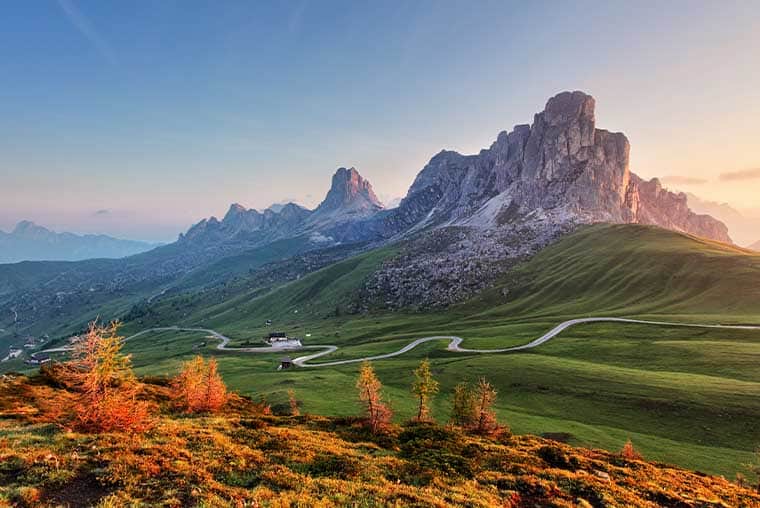
So, you want to visit the Dolomites but only have a few days. You need a short Dolomites itinerary for a day trip, weekend or visit up to 5 days which gives you ALL the best places in the most sensible order. You need to know what’s worth your time , what you can forget and where you should stay.
And here it is- the perfect Dolomites Itinerary for short road trips.
Our Dolomites travel blog posts cover most of our favourite places in more detail, but this is an overview of the routes and itinerary we took, along with driving distances and stops.
Grab a coffee and let’s get started.
*We work hard to make this the best motorhome travel blog and road trip website possible, full of helpful content for you. The website is supported by our readers, so if you buy through links on this site we may earn a commission- at no extra cost to you. All opinions remain our own .
If you find this post useful, you can also treat us to a coffee – we promise to enjoy it while creating more useful content like this- we might even indulge in a biscuit (or two!)
JUMP AHEAD TO...
Why visit the Dolomites?
The Dolomites are unlike anywhere else we have been. We’ve road-tripped around Europe for years- and this place took our breath away.
We’d always hurried past Northern Italy before, wanting to explore the Italian lakes, the Alps, or Slovenia- all of which are beautiful and totally worth a visit- but we REALLY wish we’d stopped at the Dolomites earlier.
It’s hard to explain the beauty of these mountains, or how they differ from the Alps or other European mountains we’ve seen. The combination of HUGE green meadows, jagged peaks, hiking trails and some of the most beautiful places we’ve ever seen- the whole package is captivating.
Dare we say it, but after 4 short days, we had completely fallen in love with this region- every corner is another ‘wow’ moment. And after Norway , our ‘wow’ meter is set pretty high.
The Dolomites are now firmly in our top 3 favourite places to road trip in Europe- they really are THAT impressive.
Convinced it’s somewhere you want to visit? Even if you only have a short break? Good- let’s plan your perfect Dolomites itinerary.
What is there to do in the Dolomites?
There are SO MANY THINGS to do in the Dolomites.
It’s a place for outdoor explorations, especially hiking, photography, dog walks, star-gazing, road trips, picnics and just feeling awe-struck at the beauty of nature. Seriously, it’s one of those places where you just want to be outdoors ALL. THE. TIME. Even when the weather isn’t at its best.
In winter, many of the towns become ski resorts, which would be a wonderful way to enjoy the views.
We didn’t have much time to spend in the area, so we didn’t add any of the big or best hikes into our Dolomites itinerary. If you’d like to know more about hiking to a glacial lake or which mountains are easiest/ most fun to hike, this book will tell you everything you need to know.

Also, make sure you know what to wear while hiking and dress for whatever the weather may have in store- these are big mountains and it’s easy to get sucked in by their beauty and forget the dangers of hiking if unprepared.
Instead, we focused on some of the most beautiful lakes which were just a short walk or short hike away, so we could see as much as possible in the short time we had.
Of course, you can do an all day hike if you wish, but that might not be the best option if you’re short on time.
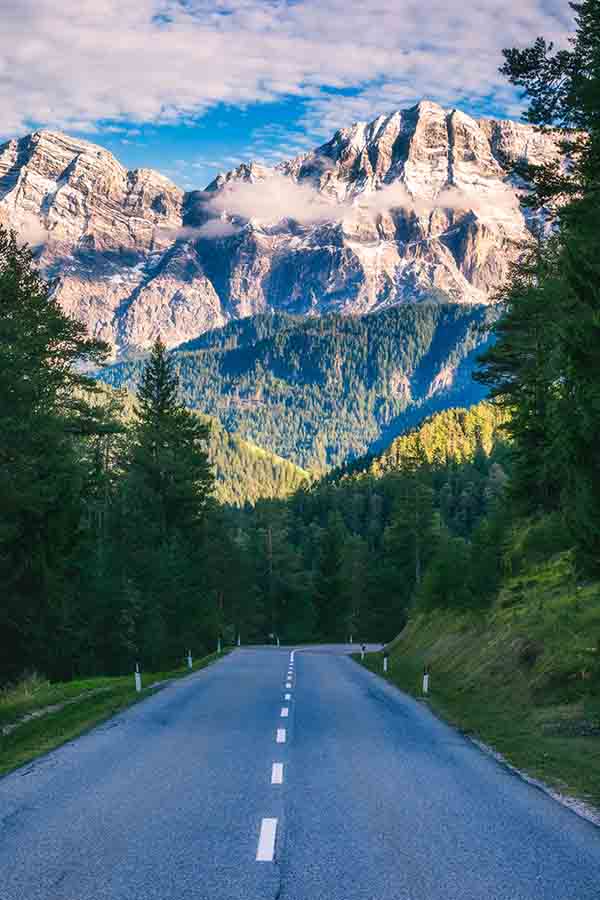
Must-Know Tips for your Dolomites Itinerary
Where are the dolomites.
The Dolomites are in northeastern Italy and one of the most beautiful mountain ranges I’ve ever experienced. As well as mountains, there are plenty of quaint towns and fantastic driving roads- making it one of the best road trips in Italy.
The area is protected as a Unesco World Heritage site due to the ‘series of highly distinctive mountain landscapes that are of exceptional natural beauty. Their dramatic vertical and pale coloured peaks in a variety of distinctive sculptural forms are extraordinary in a global context.’ (taken from the UNESCO website )
Why Is It Called ‘the Dolomites’?
The 250-million-year-old formation also known as the “Pale Mountains” took its name from the French geologist Dieudonné Dolomieu, who studied the region’s geology and dolomitic limestone formations in the 18th century.
When is the best time to visit the Dolomites?
I visited the Dolomites in early October and in my opinion that’s a great time to visit- much better than in high season (which is July and August).
What is the best way to explore the Dolomites?
Ideally, you want to explore the Dolomites in your own car or vehicle. We visited as part of our motorhome tour in Italy . Foolishly, because we were heading to Croatia, we didn’t take our motorcycles with us, but it’s a fantastic place to go motorcycle touring in Italy.
If you have a rental car, make sure you take time to add the Dolomites to your itinerary. If you’re only using public transportation, you can still explore the Dolomites, but services might not be as regular as you are used to, so you may wish to spend more than one day in the area.
The town of Ortisei or Cortina D’Ampezzo are the main towns to aim for, especially from Venice – it’s a beautiful drive at any time of year although the route has many hairpin turns and is not advised for those prone to motion sickness.
You can take the train to Bolzano and Val Gardena from Venice, Milan, or Verona.
Where is the closest airport to the Dolomites?
The closest airports to the Dolomites region are in Venice – Marco Polo and Treviso. You can reach Venice from most major hubs across Europe and the US.
Are the Dolomites Italian or German?
The Dolomites are a bit of both. The language is bilingual – and even trilingual in some places – so expect to find towns and villages sharing Austrian and Italian names, and sometimes even Ladin, the ancient Roman language passed down by the first valley inhabitants.
Almost everyone speaks Italian, German, Italian and English, but don’t be surprised if you find most Dolomites speaking the native Ladin.
What is the Currency in the Dolomites?
The currency in the Dolomites is the Euro, just like in most parts of Italy. All major debit and credit cards are widely accepted, but be prepared for those $5 withdrawal fees if you need to use an ATM for cash and plan for these expenses in advance.
What are the opening hours in the Dolomites?
Opening hours for the lifts, cable cars, and hotels in the Dolomites vary, but you can expect a standard 8:00 am to 7:00 pm timetable for most services. Restaurants hours extend until 10:00 pm or later.
A word of caution: make sure to check your hotel’s check in time carefully as some do not offer reception service after 5 p.m. in selected areas.
How Good is the Internet in the Dolomites?
The four major mobile networks in Italy are Vodafone, Windtre, TIM, and Iliad .
Some town provide free WiFi in the main squares and lift facilities, but if your smartphone supports it, you can have internet on the road with a regional Eurolink e-sim (prices start from $5).
Hiking in the Dolomites
The Dolomites and South Tyrol are a great place for those who love to hike in mountainous areas. The most popular hikes can get busy in summer, so you might wish to start in the early morning for longer day hikes in order to get the route to yourself as much as possible.
For even longer hikes, there are mountain huts (rifugio) all over the place which can be booked in advance and are a great option for multi-day hikes. One of the most popular of these is Rifugio Auronzo on Tre Cime, one of the favorite hikes for many visitors.
Dolomites for non-hikers
What we really liked was that you don’t HAVE to go for long hikes if you don’t want to ; many of the most popular locations and lots of the best lakes in the Dolomites are quite close to the road and easily accessible. So you can pick and choose exactly what you do or don’t want to see.
Driving in the Dolomites
In the Dolomites, you can enjoy a few of the most scenic routes Europe has to offer. Driving across the mountains might seem like an intimidating option, especially if it’s your first time in Italy, but driving in the Dolomites is actually way easier than you think!
Is it Safe to Drive in the Dolomites?
The roads are well maintained with road signs in both German, Italian and sometimes English. All passages through the mountains are fairly easy to cross, except for instances of heavy snowfall when you will find them usually closed.
In the Dolomites, people drive on the right side of the road just like in most other places in Europe. The speed limit is 50 km/h in towns and 90 km/h on country roads. As long as you keep an eye out for fuel signs and toll roads, you are sure to have a safe journey in the Dolomites.
NOTE: Be sure to watch out for cattle! They tend to cross the roads frequently in many farmed areas, often without warning signs.
Driver’s License & Autostrade (Toll Roads)
Toll Roads, or Autostrade are the common Italian highways, motorways, and freeways marked by easy-to-spot green signs. You’ll need a full driving license or international driving permit to travel on those by car, campervan, or trailer.
If you are traveling on a budget, you can avoid those by taking alternative, longer routes–just be sure your map is up to date.
How Many Days Do You Need in the Dolomites?
As many as you can- and it still won’t be long enough! In this guide, you will discover various options for experiencing the beauty of the Dolomites, whether it’s for a duration of a one day visit, a weekend/ two days or 3-5 days. Aim to spend at least five days if you enjoy hiking and plan to go on Alpine hikes or try a cycling trip.

How to plan YOUR perfect Dolomites Itinerary
Below, I’ll share our 3-day Dolomites itinerary, but before I do, I want to share a couple of quick tips to help you plan your own trip.
- Decide on what is important to you . With only 3 or 4 days in the Dolomites, you will not be able to see it all. Heck, you couldn’t see it all in an entire week! There are just too many things to do. So pick a few things which you REALLY want to see, and enjoy those.
- HIRE/ TAKE a vehicle. The Dolomites are MADE for road trips. They are perfect for picnics up mountains with incredible views, hiking, late-night photography and getting up early to see the sunrise. This itinerary is designed for road trips- taking public transport will take you much longer, but there are options for bus, train, and shuttle service.
- If you can, travel the Dolomites in a motorhome or campervan. That way, you can stay in some INCREDIBLE locations for much less money than the price of a Dolomites hotel. It’s definitely a more cost-effective option and campervanning in Italy is awesome anyway.
- Go out of season . Either May/ June or September/ October. We went at the beginning of October, and it was the PERFECT time- clear days, cool nights with bright stars and incredible foliage. The Dolomites in Autumn are breathtaking.
- Use Google Maps. We plotted all the things we wanted to do and see on Google Maps, and then drove between them. It’s definitely the best way to plan a trip. Learn how to use Google Maps to create an epic itinerary.
Our 3-4 day Dolomites road trip itinerary & highlights
We didn’t mean to go to the Dolomites at all; we detoured on the way to Slovenia without any plan at all.
Therefore, we didn’t really have a Dolomites itinerary planned and instead just crammed as much as we could into 3 days (technically, we were there for 4 days but we spent one full day camped at the top of Tre Cime- we’ll get to that shortly!)
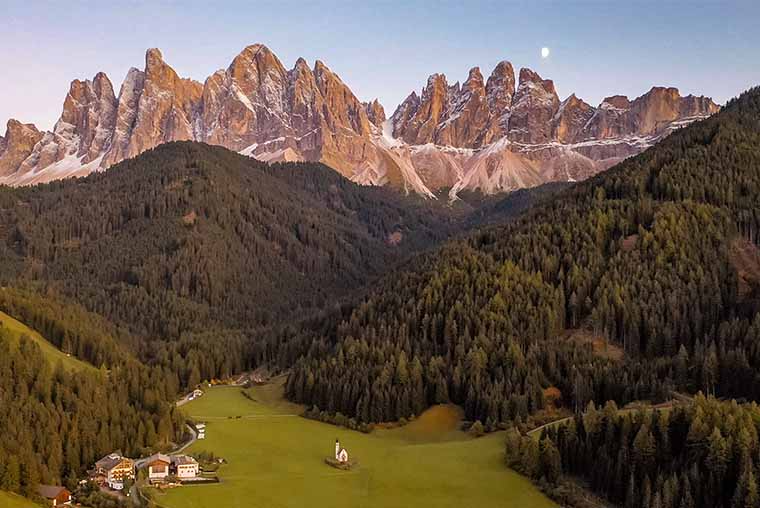
One of the most iconic shots in the Dolomites- but is it REALLY worth your time?
Italian Dolomites Itinerary Road map
Map of our dolomites road trip itinerary.
Here’s the route planner for our Dolomites itinerary. You can see the roads we took. Below, I’ll break it down into day-by-day and mileage/ stop points/ things to see in the Dolomites on the way.

Our starting point was Bolzano (A) and finished in Tre Cime (J). Of course, you can add and amend this itinerary or do it in reverse order if you wish.
NOTE- Not every point we stopped at is listed on the map above- Google Maps only allows you to plot up to 10 points at one time for a route map. But it shows all the roads we drove over the three days so you can use it as a Dolomites route planner for your own road trip.
Dolomites Route Planner

One day in the Dolomites itinerary- what to see, what to avoid and how to plan your route!
Day One (or One Day in the Dolomites Itinerary!)
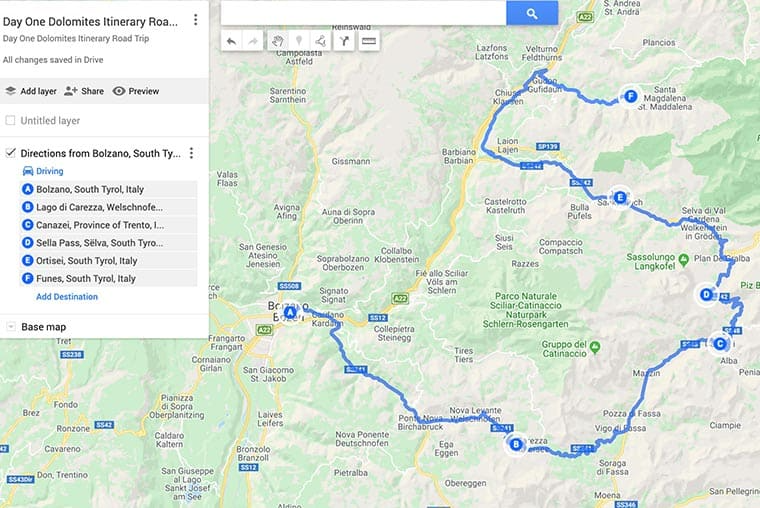
If you only have one day in the Dolomites, this is the route we would take- unless you go to Tre Cime!
Dolomites One Day Itinerary & Route Planner
Bolzano (A) to Val di Funes (F) • 170km • 5h 40 mins (including stops)
If you only have one day in the Dolomites, this is the itinerary I would pick. It showcases some of the best views, roads, lakes, mountains and more!
It’s a loop which is easily driveable in daylight hours (both in summer or winter) and is a fantastic introduction to these beautiful mountains. As a first day introduction to the area, it was incredible.
Day One Route & Highlights
- Driving the Great Dolomite Road (SS241) from Bolzano to Canazei- 2 hours • 76km (Point A- Point C) READ: 9 essential tips to drive the Great Dolomites road
- Stop at Lake Carezza (Lago di Carezza) en-route (Point B)- this is where we had a late breakfast (TOP TIP: get there early- even in October there were a lot of tour buses arriving.)
- Sella Pass towards Ortisei (SS48, becoming SS242) – 3 hours • 76km (Point D)- stopped for lunch near the top where you can see Alpe di Siusi- the largest alpine meadow in Europe
- Ortisei to Val di Funes, to see Santa Maddalena church (accurately called St Johanns Church)- the little chapel in the field and one of the most photographed churches in the world. Only a short drive at 40 mins and arrived late afternoon • 32 km (D to E)
- Stayed overnight near Santa Maddalena (see exactly where here )
Day Two- Dolomites Travel blog
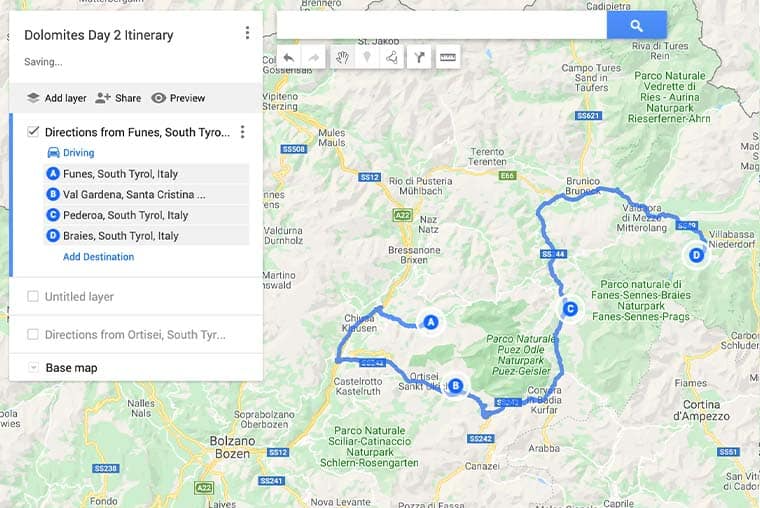
Map and route planner for Dolomites roadtrip planning for two days
Weekend/ Two Day Dolomites Road Trip Itinerary
If you’re visiting the Dolomites for a weekend or two days, I would do Day 1 and Day 2 to showcase some of the best spots in the region. It’s best to have an early start and get as much done as possible- it also means you can take advantage of spaces in the free parking lots.
Val di Funes (A) to Lago di Braies (Lake Braies) (D) on the map above • 130km • 2h 30 mins (NOT including stops)
- Val di Funes to Ortisel (Col Rainer or Seceda Cable Car) – 31 mins • 39km
- Gardena Pass (B/C) – 49 mins • 32km
- Lago di Braies for evening – 1h10 mins • 59km
This hotel at Lago di Braies is RIGHT ON THE SHORE of the lake and would be perfect to stay in if you don’t have a campervan.
If you stay nearby and it’s a clear night, getting up to photograph the stars over the lake is a great idea- it’s seriously beautiful.
Day Two – Highlights for where to visit in the Dolomites
- Val di Funes- St Johann’s Church/ Santa Maddalena- READ : Val di Funes perfect itinerary .
- Col Raiser/ Seceda/ Alpe di Siusi Cable car–visit the top of Seceda if you can, but motorhome parking at the cable car station is a NIGHTMARE, so Col Raiser is easier for vans to visit.
- An alternative option is to visit Alpe di Suisi (called Seiser Alm in German) on the opposite side- it’s the largest high-alpine pasture in Europe.
- Gardena Pass – this was breathtaking–well worth going this way instead of the quicker autoroute to Lake Braies.
- Lago di Braies – we arrived the night before and stayed overnight. If you’re not staying on site, get here REALLY early or you will be overrun by Instagram photo hunters… many in wedding dresses… #notevenkidding.
Day Three- Dolomites Travel blog
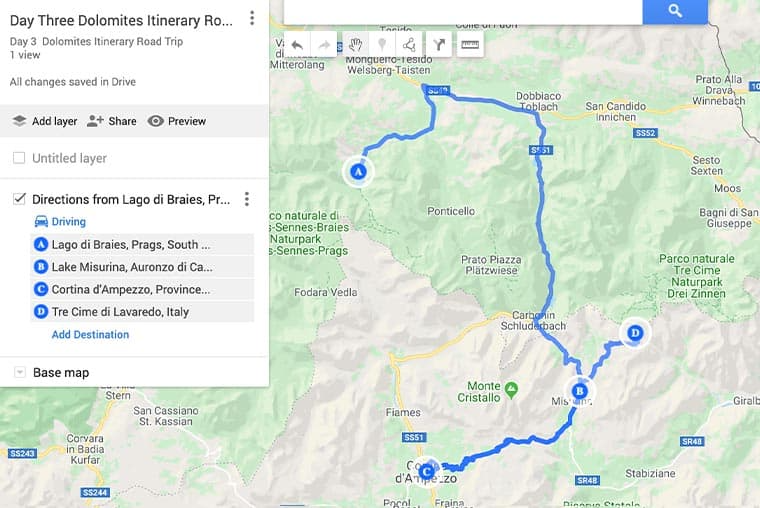
Day Three Dolomites Road Trip Itinerary
Lake Braies (A) to Tre Cime (D) • 73km • 2 hours
A shorter road trip route today, with plenty of pretty lakes and stunning views. Don’t miss Tre Cime di Lavaredo – despite the expense it was our favourite part of the Dolomites.
If you can, stay up there for the night, either in a camper or a tent or at a hostel. You won’t regret it!
Day Three Dolomites – Things to do and things to miss
- Next morning, get up EARLY to see Lago di Braies at sunrise for the best experience of this beautiful lake. The good news is you’ll see the sunrise and avoid the hundreds of Instagrammers!
- Lake Braies to Lake Misurina – 43 mins • 35km (you pass Lake Dobbiaco and Lake Landro on the way- both pretty and worth a stop)
- Lake Misurina to Cortina d’Ampezzo – 23 mins • 15km (missable- we only went for fuel and shopping)
- Cortina to Tre Cime – 42 mins • 23km
- Stay up Tre Cime for the evening so you can see sunset and sunrise. Both are stunning. We chose to spend two nights up here, but you don’t need to if you’re short on time.
If you can’t stay up Tre Cime itself (an extra cost, but worth it), this is one of the closest hotels to Tre Cime – the views are SPECTACULAR!!
Some common questions about the Dolomites:
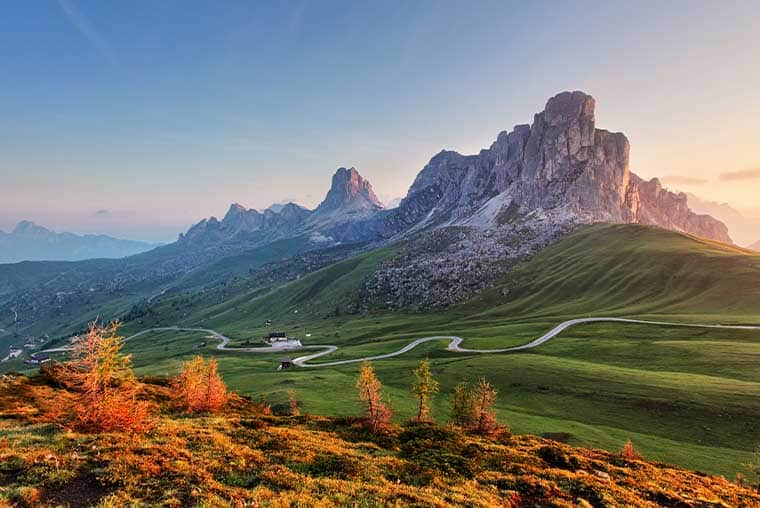
Dolomites Itinerary for non-hikers- do I HAVE to walk or hike?
We didn’t do many BIG hikes in our 3-day Dolomites itinerary. On the 4th day, we spent it hiking and exploring Tre Cime. But you can easily spend three or four days in the Dolomites and not hike at all if you don’t want to.
When Should I visit the Dolomites?
In our opinion, Autumn is perfect. It’s actually one of our favourite places to experience Autumn in Europe. The trees are a beautiful backdrop to the views, the weather is still warm enough to go outside and yet the visitor numbers are much fewer than in summer, which makes the whole experience much better.
September/ October is beautiful. Don’t come any later than mid-October as many of the cable cars/ mountain passes in the Dolomites will be closed and not re-opened until April-ish. Snow and ice can cause difficulties reaching many of the best things to do in the Dolomites during winter, so while it can be pretty, you may not see everything you want to. (Here are some more incredible places to enjoy in Europe in October )
If Autumn isn’t an option, try and visit May or June, which is a perfect time to enjoy the spring flowers on the alpine meadows. The weather will just be warming up, snow will be mostly melted, and you should get many opportunities to enjoy the spectacular views!
Where can I visit the Dolomites?
The Dolomites are in Northern Italy, about an hour north of Lake Garda.
How do you get to the Dolomites from Venice/ from Milan?
If you’re doing a Dolomites Road Trip Itinerary (which we highly recommend), you can easily get to the Dolomites from Venice or Milan.
Venice to Bolzano (the start of our Dolomites itinerary) will take you about 3 hours (267km)
Milan to Bolzano is about 3 and a half hours (278km)
How much does it cost to visit the Dolomites?
One of the advantages to visiting an area with a lot of hiking and photography spots is that it can be visited quite cheaply, especially out of season.
Our 4-day Dolomites itinerary didn’t cost us much at all:
- 4€ parking at Lake Carrezza, plus gifts and souvenir postcard (we collect them)= 25€
- Breakfast and bread for lunch from bakery = 6€
- Col Raiser Cable Car- 40€ for 2 adults and a dog (dog free)
- Cake and coffee at top of Col Raiser = 17€
- Overnight parking at Lake Braies = 8€ (15€ as of 2022)
- Gift shop at Lake Misurina = 35€ (bought amazing woolly slipper socks – worth it!)
- Tre Cime for 2 nights with a motorhome = 70€
- Fuel and LPG = 80€
- Not a thing- we were up Tre Cime! Although there is a restaurant and a shop there, we didn’t use it.
TOTAL costs for Dolomites road trip = 351€
This doesn’t include travel to or from the Dolomites, or food which we already had in our motorhome, but should give you an idea on what you could expect to spend on your own road trip.
Where to stay when you visit the Dolomites?
I’ve mentioned it a couple of times already, but we highly recommend visiting the Dolomites with a motorhome or campervan. That way, you can stay in campsites or use aires (called Sostas in Italy.)
You can either bring your own van, or hire one nearby.
If that’s not an option, hire a car and be prepared to move hotels each night, so you’re not wasting time returning to a hotel back where you started.
The hotels we recommend are:
- Val di Funes- hotel with a hot tub and views of the Dolomites? Yes please!
- Lago di Braies- right on the shores of the lake!
- Near Tre Cime- you won’t believe these views!
Travel Essentials for your Dolomites Itinerary
Whether it’s a surprise hailstorm in the middle of summer or a spontaneous hike, it doesn’t hurt to be ready to face the unexpected in the Dolomites. Read on and make a list of the essentials that will allow you to relish in the Alpine experience, rain or shine!
What to Wear in the Dolomites
A rain jacket – ideally lightweight and insulated to accompany you in every exploration.
Sun hat & Sunscreen – depending on when you visit. Dolomite summers are mild with average maximum temperatures in July and August rarely spiking over 25°C – but, let’s face it, an unexpected sunburn can really ruin a holiday so it’s best to be prepared.
Sturdy shoes or sandals – able to withstand spontaneous hikes and the tricky cobblestone streets of the scenic towns along your trip.
What to Pack for the Dolomites
A power bank, travel adaptor, hiking shoes, and your trusty reusable water bottle go a long way in any vacation and will prove essential in your outdoors adventures in the Dolomites. Visiting in May or during the summer months? You might want to pack your swimsuit, but only if you’re brave enough to try the cold waters in Lake Braies.
If you want to see more photos of the beautiful Dolomites, check out our Instagram.
There is so much to see in the area, it can be overwhelming trying to narrow it all down. Here are some of our favourite guides to help:
- Shorter walks in the Dolomites
- The best photo locations in the Dolomites
- Dolomites UNESCO tourist map
We hope you found those itinerary ideas for the Dolomites useful. You might find these posts helpful too:
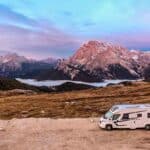
Kat never planned to buy a motorhome. She also never planned to quit her job as an air traffic controller, go touring around Europe in said motorhome, start one of the UK’s largest motorhome travel websites… or get a cocker spaniel.
Find out how she went from stuck in the rat race to being a digital nomad and inspiring thousands of people to have their own epic adventures here.
If you’d like to connect with Kat, send her an email or follow her adventures on social media.
Last update on 2024-09-17 / Affiliate links / Images from Amazon Product Advertising API
Sharing is caring!
Similar Posts
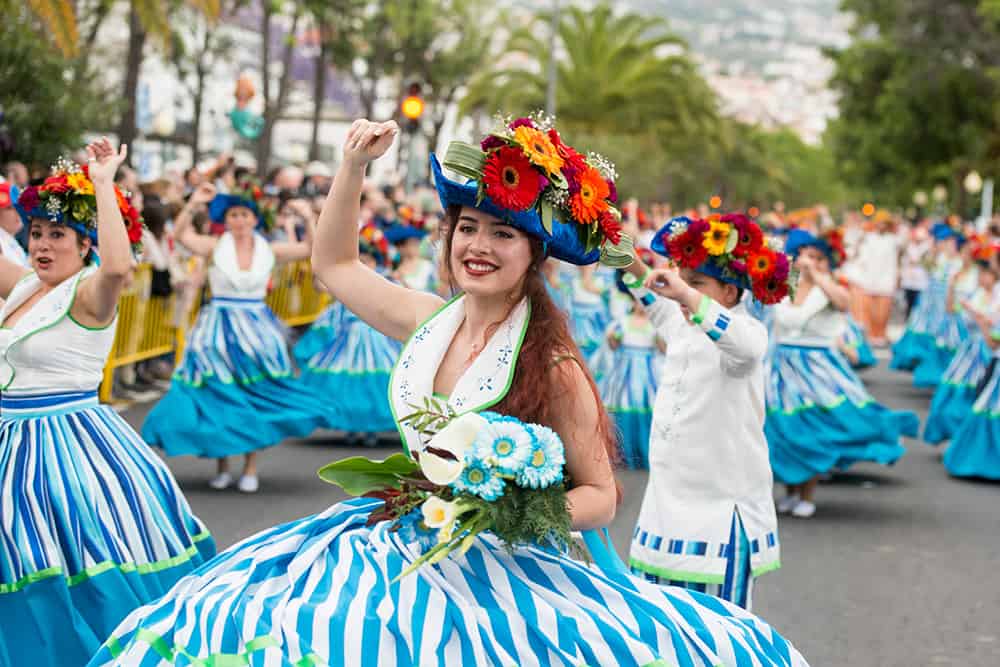
Visiting Europe in April or May? Don’t miss these incredible events!
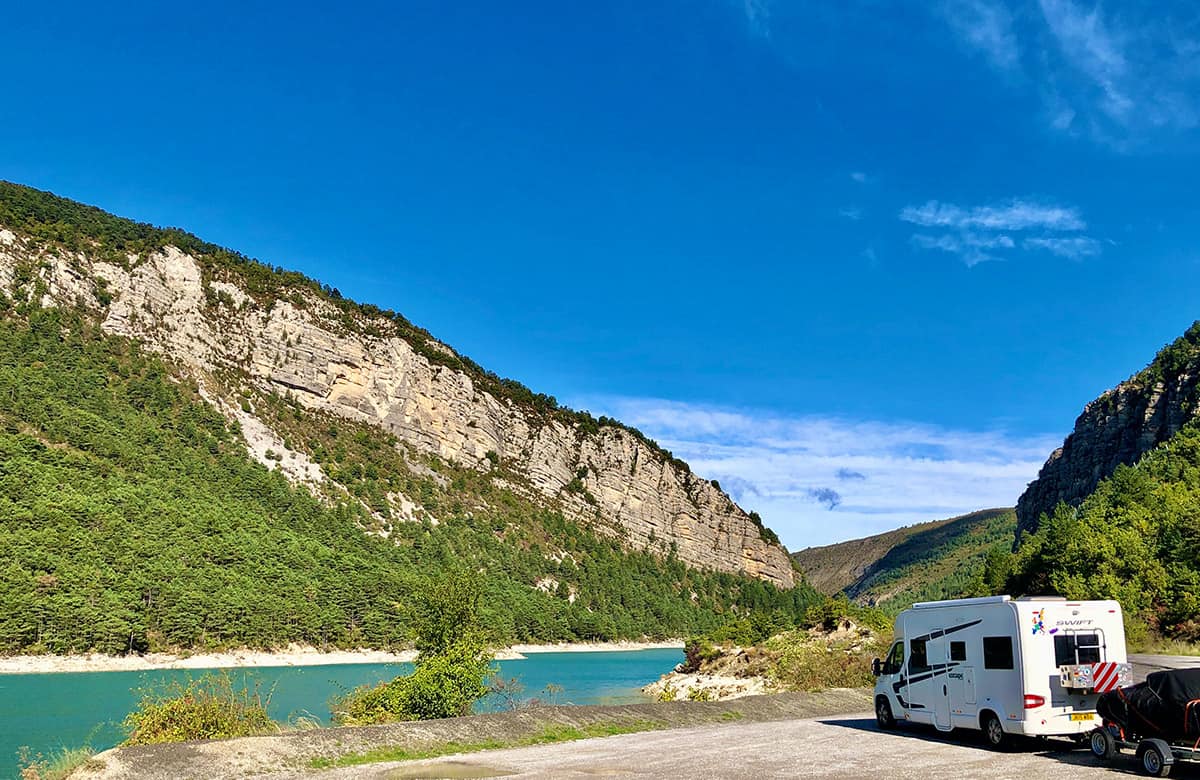
Gorges du Verdon with a motorhome (route & map)
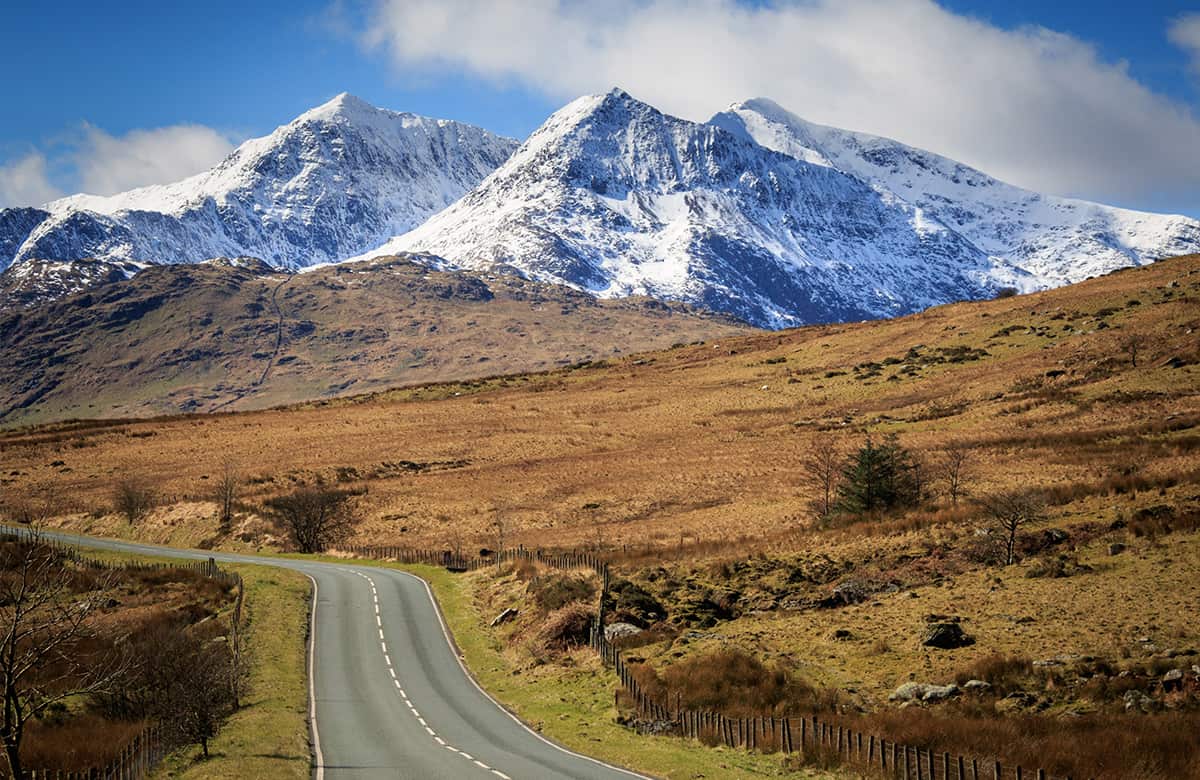
The Wales Way driving routes (visit breathtaking places in Wales)
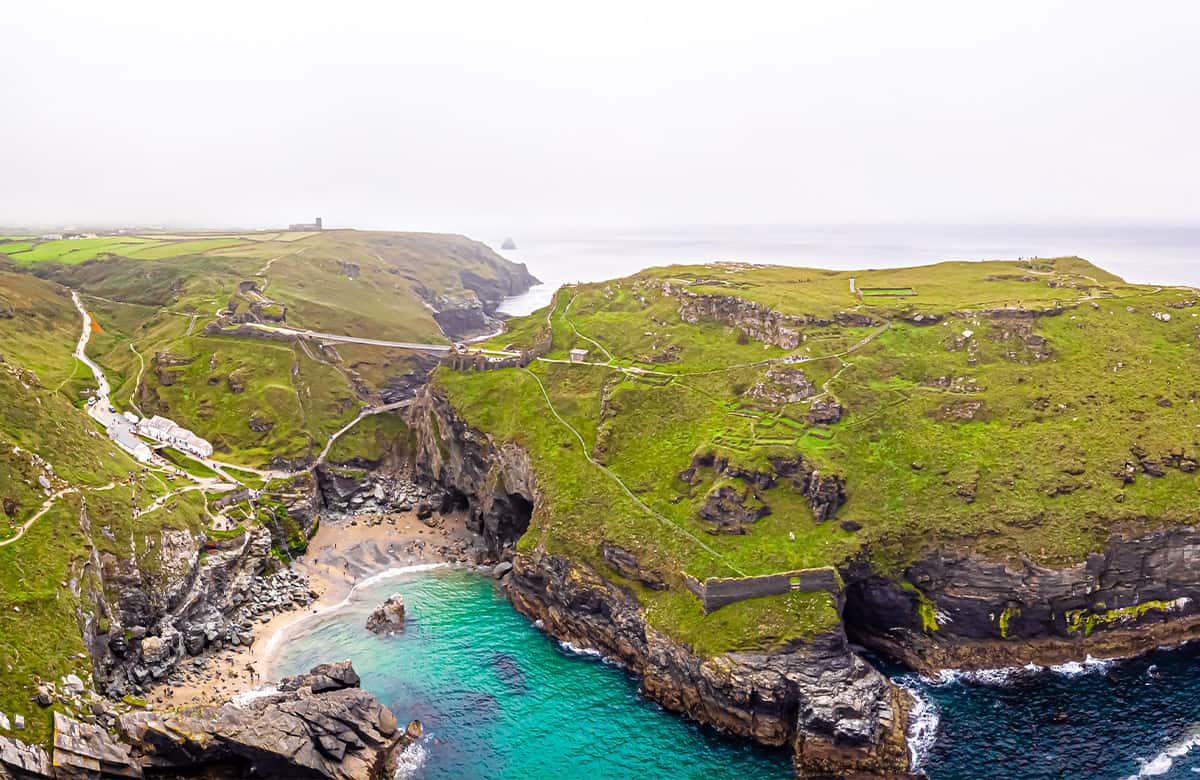
Tintagel Castle & Merlin’s Cave
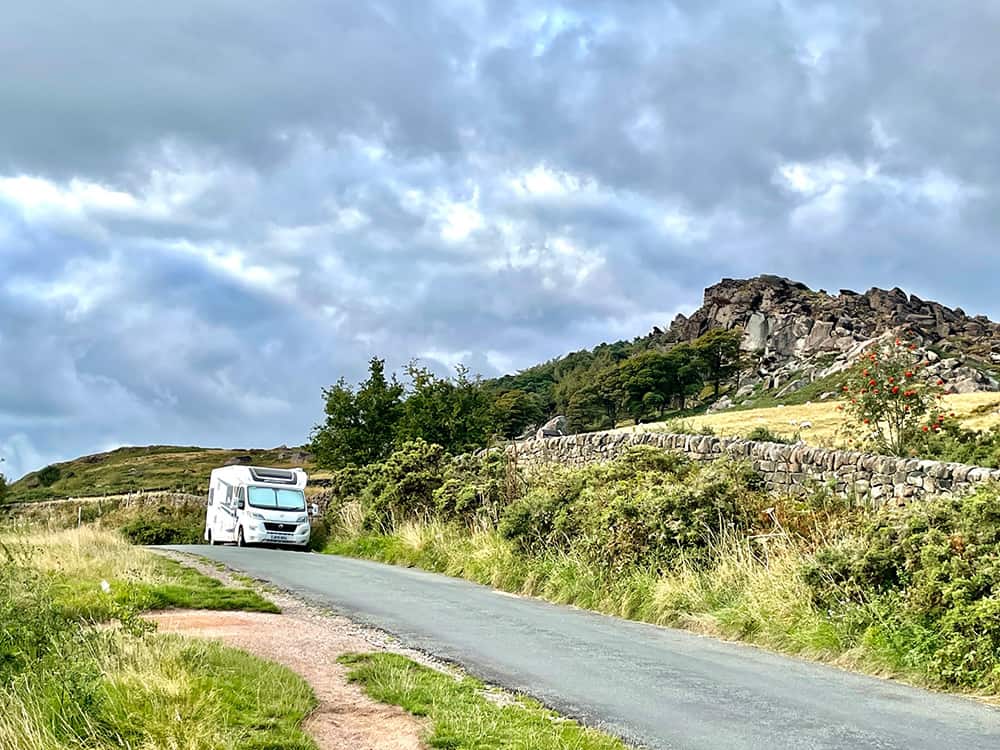
One Week in England- itinerary idea

10 essential tips to visit the REAL Disney castle in Germany- Neuschwanstein!
12 comments.
Do you have any suggestions on motorhome or camper van rentals in that are?
Love this blog post! I’m planning to go September or October and am inspired by your pictures! Thank you
Love this post! We’re in Bolzano now and about to embark on your 3 day roadtrip suggestion!! VERY excited.
Awesome!!! Let me know how it goes 🙂
The Dolomites are great for your camper I agree, but if you want to see the really dramatic sceneries, a hike is required don’t you think so?
Hikes are awesome, but not everyone is capable or has enough time. But yes- the higher you go, the better the scenery. That’s why we loved Tre Cime so much 🙂
Hi! How were the roads for large (8.5m) motorhomes?
Most of them you’ll be absolutely fine- just go early to avoid buses or other vans coming the other way. And maybe sound a horn before blind bends where you might swing out into the road.
can we do this road trip in a scooter ( vespa )
Absolutely- it would be fun on a scooter. Just remember the roads can be steep, so it would need enough power to get up them and you’ll need to make sure you have fuel.
What an amazing and detailed blog, must say you have shared some really good information. The ideal Dolomites itinerary.
Thank you. Hope you make it there one day. The Dolomites are beautiful.
Leave a Reply Cancel reply
Your email address will not be published. Required fields are marked *
Save my name, email, and website in this browser for the next time I comment.

16 BEST Places to Visit in the Dolomites, Italy (+ Map, Photos & Info)
By Author Jurga
Posted on Last updated: June 28, 2024
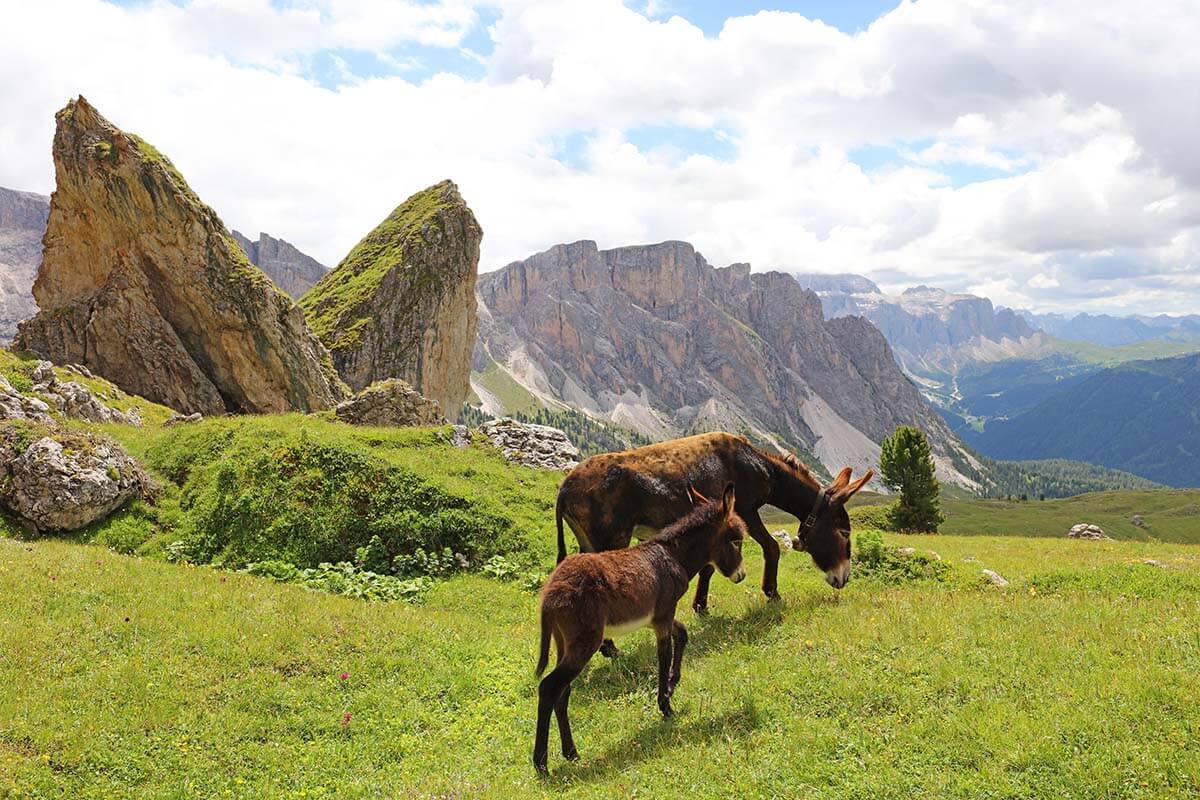
Are you planning a trip to the Italian Dolomites and wondering where exactly to go and what to see? In this guide, we cover some of the nicest places and the very best things to do in the Dolomites that are worth a trip even if you are traveling from the other side of the world. We also share our experience-based tips and suggestions that will help you plan a bucket list trip and enjoy the best that the Dolomites have to offer. Find out!
The Italian Dolomites have some of the most beautiful mountain scenery you can imagine. Stunning scenic roads and dazzling mountain passes, thousands of kilometers of hiking trails, picturesque mountain lakes, and countless charming towns and villages dotting the region…
However, with so many beautiful places in the Dolomites, it can get really overwhelming just trying to figure out where to go and what to see. Especially if this is your first visit and you want to see the very best in a limited time…
We had the same question before our first trip to the region – what are the most beautiful places in the Italian Dolomites that you really shouldn’t miss? And, since we travel with kids, we also had to make sure that these places would be relatively EASY TO VISIT .
We have been to the Dolomites several times and spent about three weeks exploring the region. In all that time, we haven’t come across one place that we didn’t love… But in this guide, I only share our absolute favorite places, top things to do in the Italian Dolomites that deserve a visit the most – the ultimate Dolomites bucket list .
TIP: To help you plan your trip, we also created a map indicating all the best places of the Dolomites mentioned in this article. You can also save this map to your phone and use it during the trip.
How to use this map: Use your computer mouse (or fingers) to zoom in or out. Click on the icons to get more information about each place. Click the arrow on the top left corner for the index. Click the star next to the map’s title to add it to your Google Maps account. To view the saved map on your smartphone or PC, open Google Maps, click the menu and go to ‘Your Places’/’Maps’. If you want to print the map or see it in a bigger window, click on ‘View larger map’ in the top right corner.
Good to know: Most of the places on this list are very easy to visit and only a few of them require hiking . Furthermore, all the hikes mentioned here are easy to moderate and we have done them all with our three kids.
Please keep in mind that this is a summer guide , from May-June to September-October! If you visit Dolomites in winter, you’ll still be able to see some of these beautiful places, but it will be a very different experience and you’ll have to do more research to see what’s open and how to get there.
Note on place names: There are three different languages spoken in the Dolomites: Italian, German, and Ladin (an ancient Rhaeto-Roman language). Therefore, many place names in the region have several different names. In this article, we use the names that are most commonly known among international tourists. In addition, we include the other names as well, so that you know that e.g. Lago di Braies is the same place as Pragser Wildsee and Tre Cime is the same as Drei Zinnen, etc.
And now that you know all the practicalities, scroll down for our ultimate Dolomites bucket list!
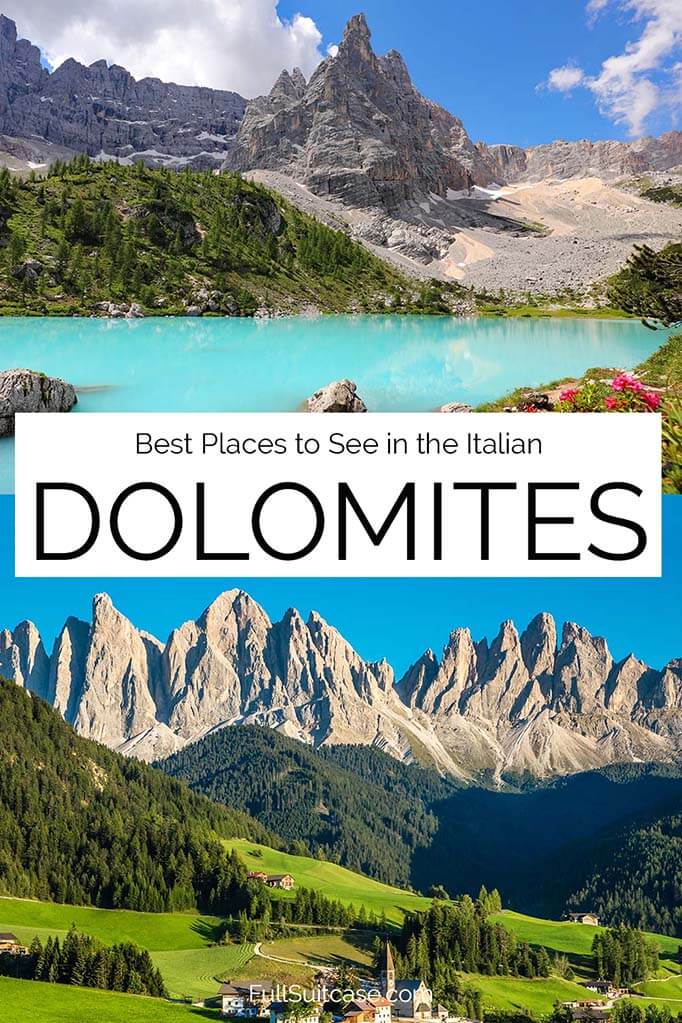
These are some of the very best places to see and things to do in the Dolomites:
1. Tre Cime di Lavaredo
Tre Cime di Lavaredo (aka Drei Zinnen) are the three iconic mountain peaks, the unmistakable symbol of the Dolomites. If there’s one place that everybody considers a must-see in the Dolomites, it’s definitely Tre Cime!
Hiking the Tre Cime di Lavaredo trail is by far the best way to enjoy the jaw-dropping scenery of the area. However, if the entire 10km loop around the base of these three peaks is too challenging for you, you can also just opt to walk the first part of the trail, to Forcella Lavaredo.
This hike to Forcella Lavaredo is easy at first, with a short climb to the viewpoint and it takes just 20-30 minutes one way. It offers some fantastic views from the start and a short climb is rewarded with a nice side view of the Tre Cime peaks.
LEARN MORE: Tre Cime di Lavaredo
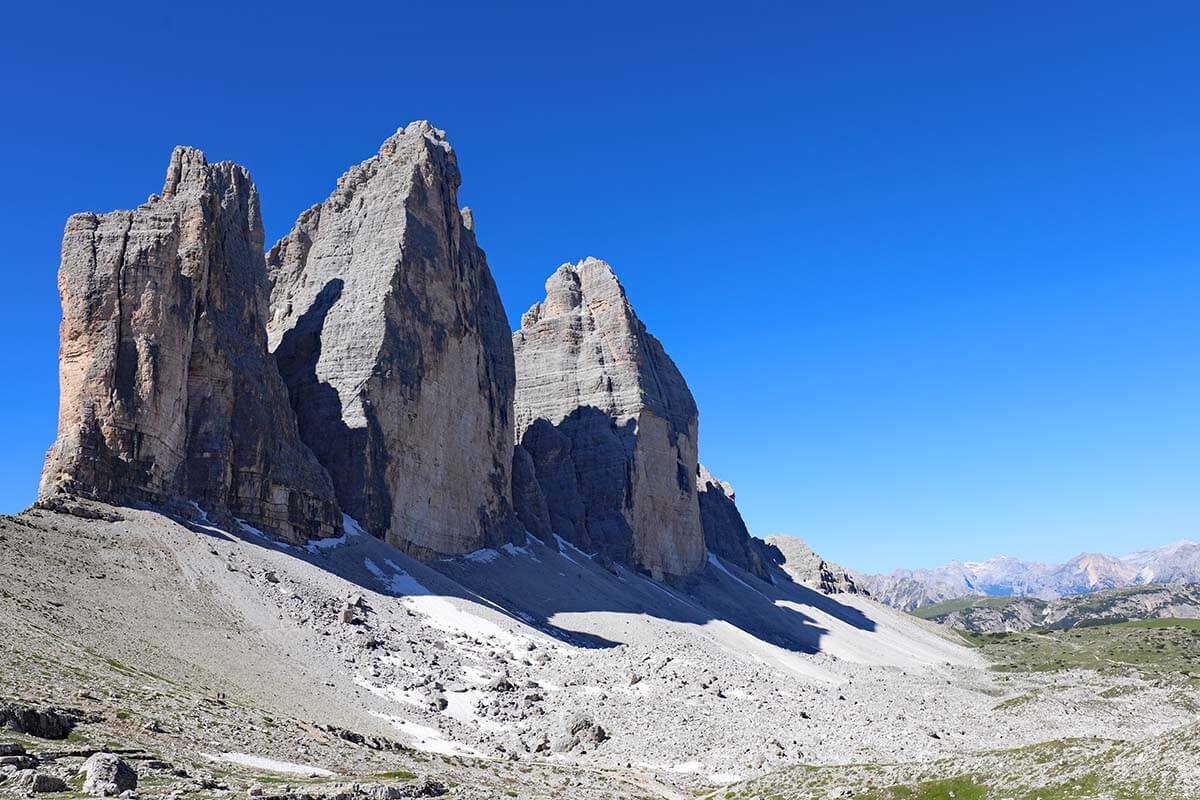
2. Lago di Braies
Another must-see place in the Dolomites is Lago di Braies (aka Pragser Wildsee). It’s one of the most beautiful mountain lakes in Italy, maybe even in Europe.
Located at the end of the Prags Valley, Lake Braies is surrounded by tall mountain peaks that make the scenery here picture-perfect. In summer, you can rent a boat and enjoy the beautiful views from the water. If you feel like, you can also take a short and easy loop hike, or even go swimming in the ice-cold waters of this glacier-fed lake.
The good thing is that Lago di Braies is easy to reach and you don’t have to walk far from the car in order to enjoy the best views. However, this is also the reason why it’s one of the most popular Dolomites landmarks, attracting big crowds of locals and tourists alike.
LEARN MORE: How to Visit Lago di Braies
TIP: Also the nearby Lago Di Dobbiaco is very picturesque, but it’s not as well known to tourists and is mostly visited by locals. Check it out if you’re looking for some lesser-known hidden gems of the Dolomites – it’s easy to visit and only takes a few minutes.

3. Val Gardena
Val Gardena is one of the best-known regions of the Italian Dolomites, and the place to be in summer and in winter. Val Gardena is home to three main towns – Selva, Santa Cristina, and Ortisei, that serve as a base for exploring the surrounding mountains. This area is extremely popular for skiing in winter. But also in summer, there’s so much to see and do in Val Gardena!
It’s not easy to mention just one or two highlights at Val Gardena since the entire area is absolutely stunning. The best thing to do when visiting in summer is to take one of the cable cars to the mountains and do some hiking. But also if you don’t hike, you can just find a seat with a view at one of the mountain restaurants and enjoy some phenomenal landscapes the easy way.
Some of the most beautiful scenery of Val Gardena can be found at Seceda (see also the featured image on top of this article – the one with the cute donkeys). The best way to visit is by taking the Ortisei – Furnes- Seceda cable car from Ortisei town and then (easy) hiking in the direction of Santa Christina. Or you can simply enjoy the area by exploring some shorter trails on top of the mountain and then taking the cable car back to the village.
We also loved the views in the area around Dantercepies – Jimmy’s Hutte that can be reached by cable car from Selva village or from Alta Badia. If you are looking for a longer hike in this area, check out the Rifugio Puez hike. It’s quite long, but the views are well worth it.
Another very popular place is Alpe di Siusi (aka Seiser Alm), Europe’s largest high-altitude Alpine meadow. There are some easy hikes here and this area is also popular with families.
LEARN MORE ABOUT SOME OF THESE PLACES: Best Hikes in the Dolomites
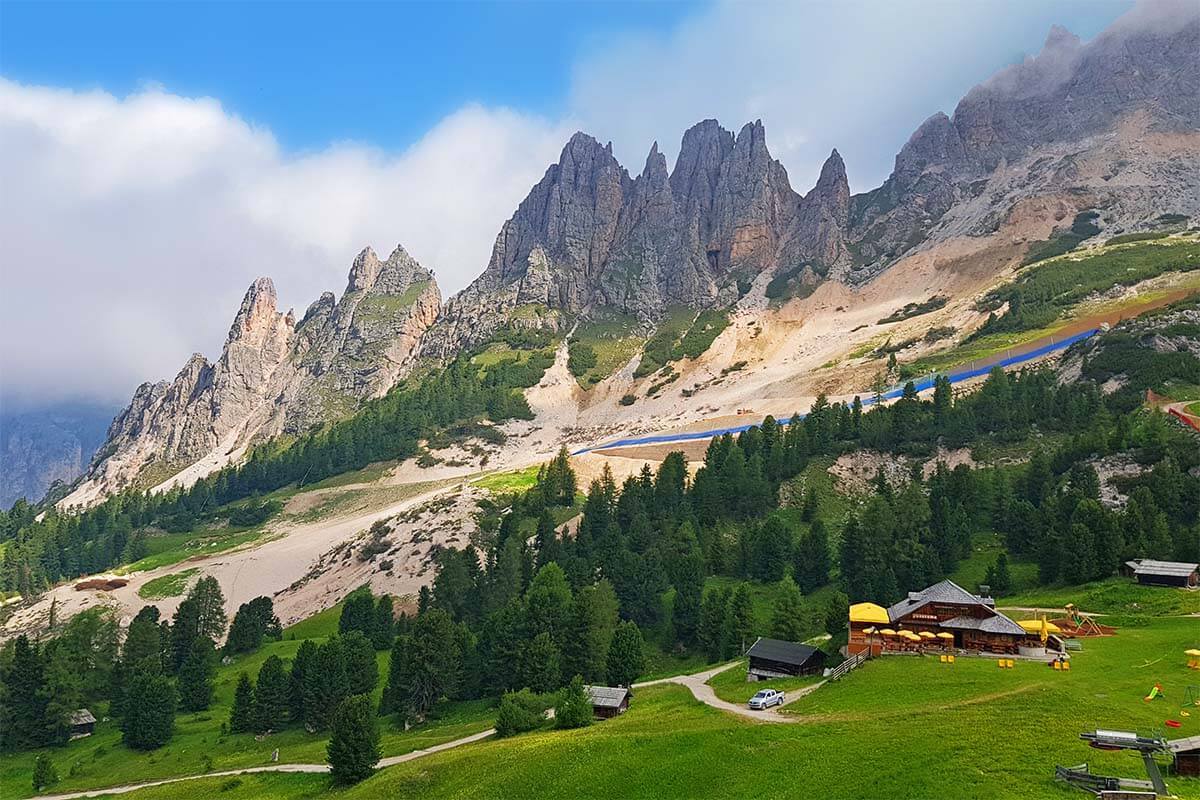
4. Val di Funes
Val di Funes (aka Villnöß) is a mountain valley known for the most iconic postcard view of the Dolomites – the little church of St. Magdalena against the impressive backdrop of the Puez-Odle massif.
If you want to take the same picture as in all those famous photographs, it’s quite easy to get to this viewpoint (also indicated it on our map above). You can get there by driving or on foot from St. Magdalena village. The road here is really narrow, however, and you can’t park at the viewpoint, so it’s easier to leave your car in the village and walk up there.
Another highlight of the Villnöss Valley are the stunning mountains of the Puez-Odle natural park and the picture-perfect mountain huts. The nicest mountain hut with the most beautiful view is Geisler Alm and there are a few others.
You can reach Geisler Alm by taking a short hike from one of the car parks in the area. However, we recommend that you take a slightly longer route by hiking the Adolf Munkel Trail . It’s an easy circular hike of about 3 hours in total, and the views are absolutely amazing! You can read all about this hike in our Dolomites hiking guide .
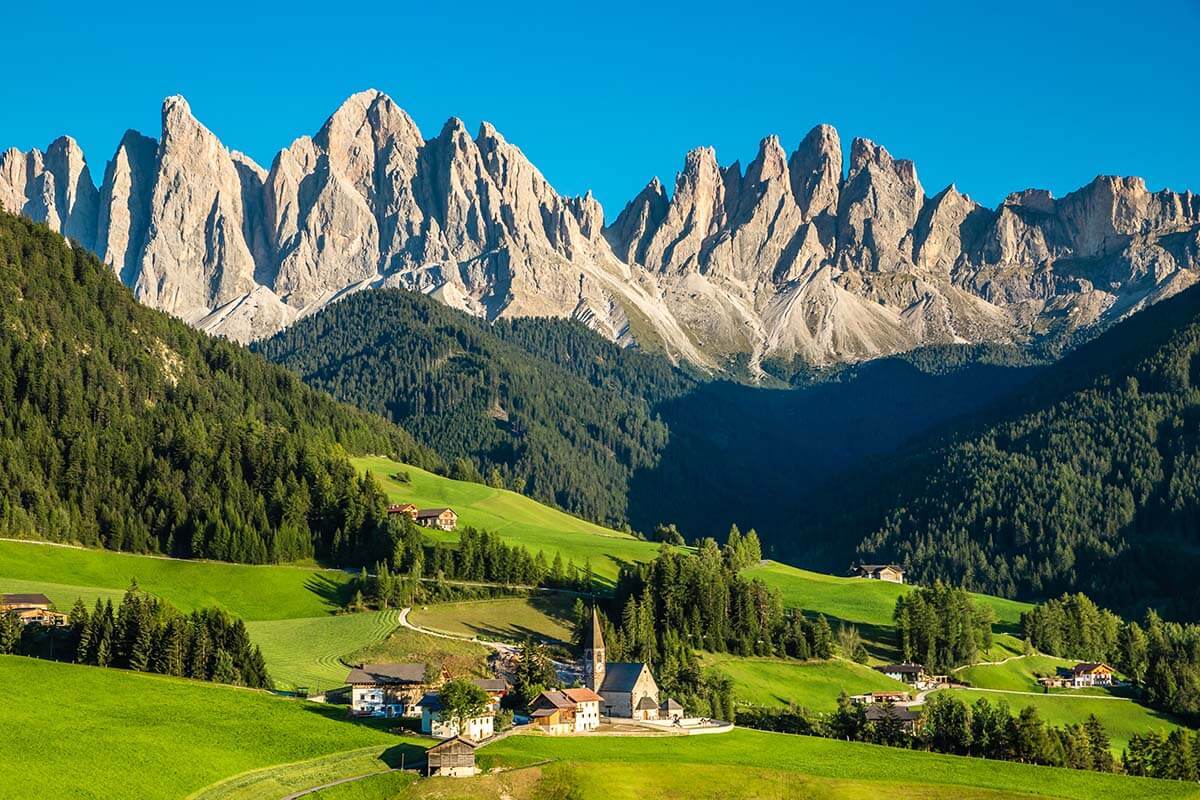
5. Lago di Sorapis
Lake Sorapis is another stunning mountain lake and definitely deserves a mention on any list of the best places in the Dolomites. This lake and the surrounding scenery is totally different than the landscapes at Lago di Braies, but many people would argue that it’s even more beautiful.
The glacial waters of Lago di Sorapis have a very distinctive milky-blue color that looks too beautiful to be real. If you visit on a sunny day, the color of the lake is absolutely incredible. Add to that the colorful wildflowers, deep blue sky, surrounding mountains with a distinctive pinnacle called God’s Finger, and you feel like you stepped into a real-life painting!
However, there’s just one tiny issue and that is that Lago di Sorapis is not as easy to visit as most other beautiful places in the Dolomites. So you’ll only be able to see this lake if you hike. Furthermore, it’s not an easy walk in the park, but a moderate 2-hour uphill hike with some challenging sections that involve stairs, ladders, and narrow passages with metal chains for support.
Having said all this, don’t get discouraged – it’s a hike most people should be able to do (and we did it with our three kids). You simply should know what to expect and take your time so that you can truly enjoy it (count 4-5 hours for the entire hike).
LEARN MORE: Lago di Sorapis Hike
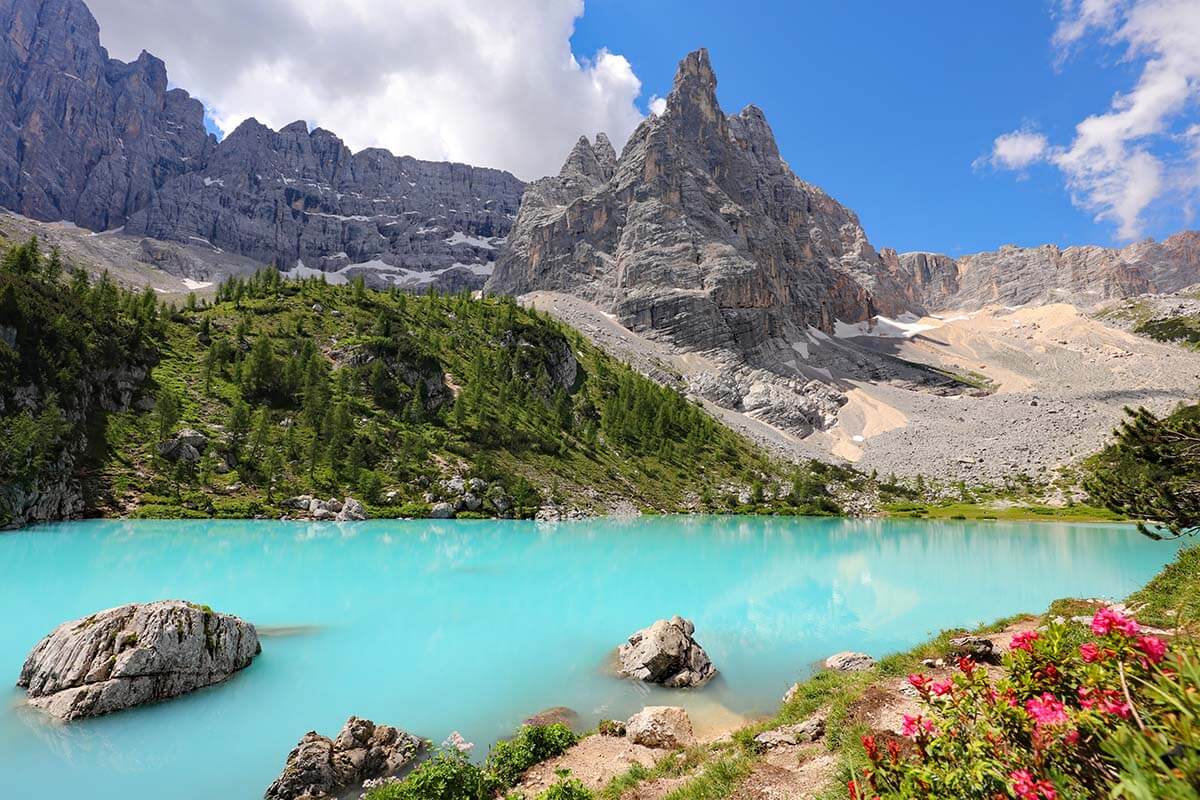
6. Marmolada
No list of the Dolomites best places would be complete without mentioning the highest mountain in the region, Marmolada . Also known as the Queen of the Dolomites , Marmolada is a very unique place where you will not only find some of the best far views over the Dolomite mountains but also fascinating Great War history.
With 3,265 m (10,712 ft) height, Marmolada offers incredible 360° views of the entire Dolomites region and you can even see as far as the mountains of Austrian Tyrol . In addition, you can visit the Museum Marmolada Great War 3000m, a WWI fortress (at 3km height!), and Grotto of the Madonna. For the more adventurous, there are also a couple of via ferratas and other activities here.
Despite its altitude, Marmolada is very easy to visit by taking a series of cable cars, and it doesn’t take longer than a few hours. So if you find yourself in the heart of the Dolomites region and are looking for something nice to do, definitely check it out!
Good to know: Because of the altitude, there’s always snow at Marmolada. Be sure to take a sweater and a rain jacket with you – even if it’s very warm in the valley.
LEARN MORE: How to Visit Marmolada
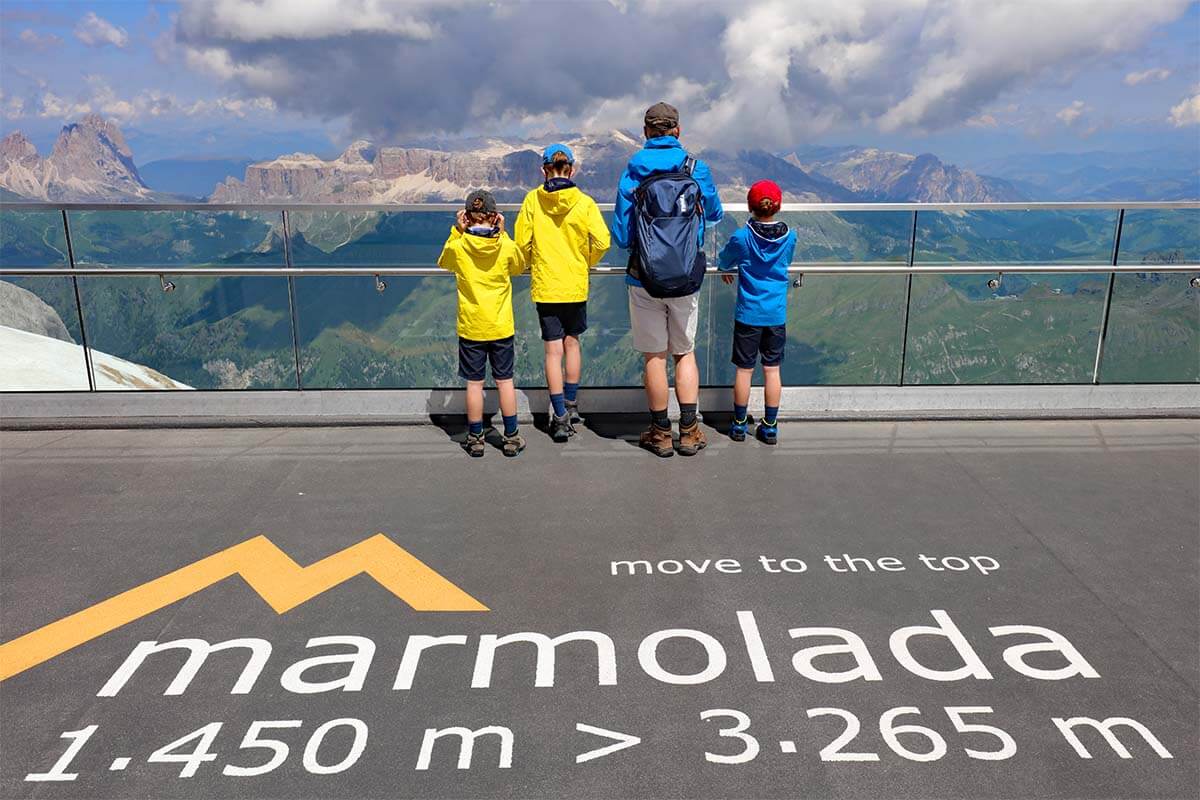
7. Passo Gardena
Passo Gardena (aka Grödner Joch) is an absolutely beautiful mountain pass and one of the must-drive roads in the Dolomites. The first time we visited the region, we reached Val Gardena via this mountain pass at around sunset. What a scenery, what a landscape! It was love at first sight!
Since then, we have driven this pass multiple times, in different weather, and it remains one of my personal favorite scenic drives in the Dolomites.
Gardena Pass isn’t nearly as difficult to negotiate as most other mountain passes in the region, it’s usually not as busy, and the landscapes are breathtaking. Furthermore, it’s the quickest route between Val Gardena and Lago di Braies – two of the most popular places in the Dolomites.
So even if you only have limited time in the region and have to be very selective about where to go, I highly recommend driving the Gardena Pass.
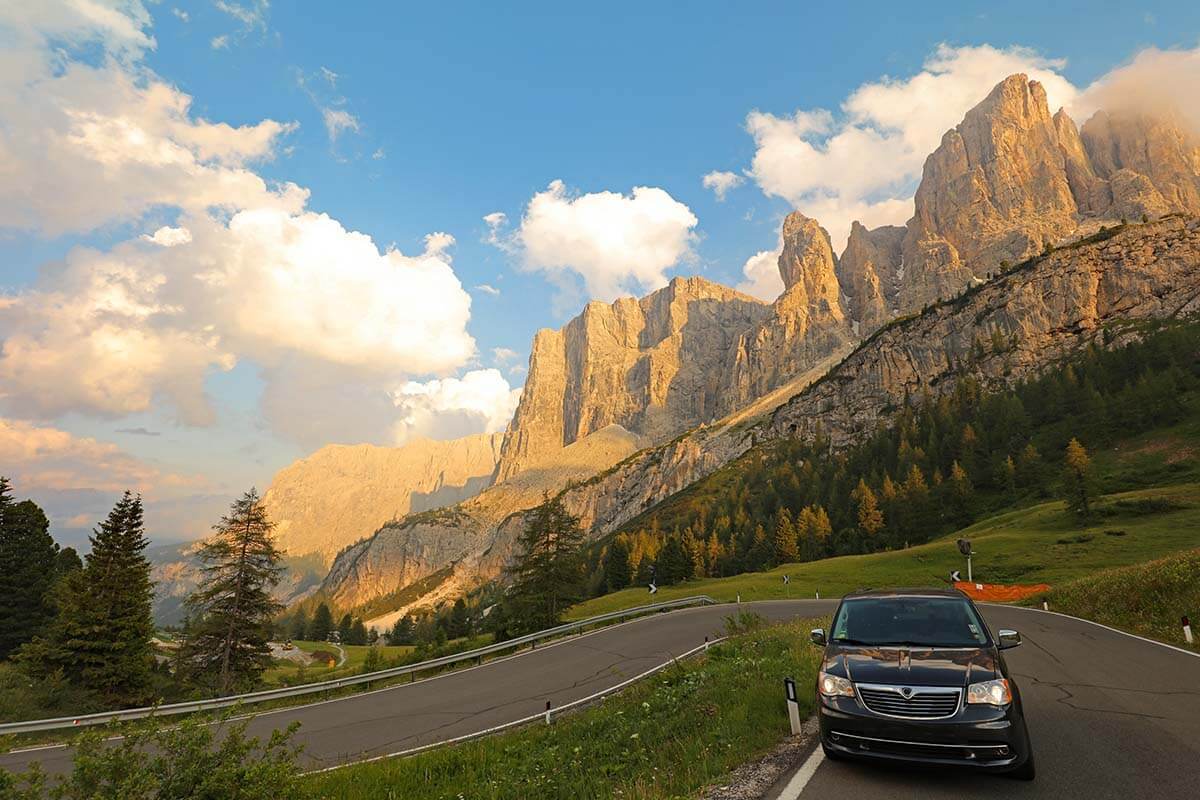
8. Passo Pordoi & Piz Boè
With 2,239 m (7,346 ft) altitude, Passo Pordoi is the highest road in the Dolomites. With its 28 hairpin bends, this is one of the roads that will definitely make your head turn! The roads in this part of the Dolomites are absolutely insane and driving here is an experience in itself. It’s not the best road to take if you are just passing by and are in a hurry….
Probably the most touristy of all the mountain passes in the Dolomites, Passo Pordoi is more than just a road with nice scenery. It’s one of the most popular Dolomites destinations, with many people coming here to enjoy the views from Forcella Pordoi and hike to the nearby Piz Boè .
With 3,152 m (10,341 ft), Piz Boè is one of the highest mountain peaks that you can hike to in the Dolomites. It’s quite a serious climb if you start at Passo Pordoi, but you can also take Sass Pordoi cable car for the biggest part of the journey. It will still be a serious uphill walk and there are some exposed sections and ladders, but it’s doable for most people, and that’s what makes it quite popular.
Good to know: Wear good hiking shoes and layers of clothing. A rain jacket and a sweater are a must when hiking at this altitude. If you can, visit on a sunny day, and definitely avoid stormy afternoons!
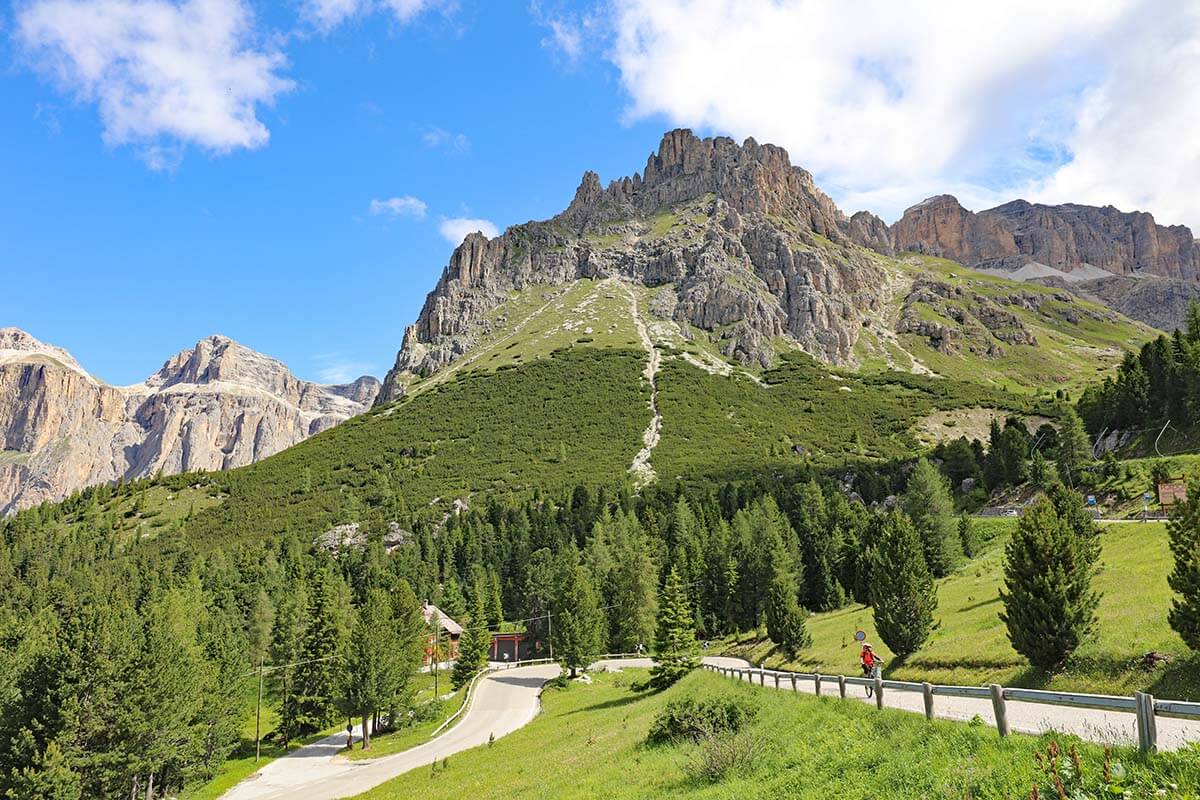

9. Passo Giau
Giau Pass is just one of the many stunning mountain passes in the Dolomites. Be prepared for some sharp hairpin turns when driving here, but it’s well worth it. The scenery around Passo Giau is extraordinary!
But what makes a visit here really worthwhile is the beautiful landscapes at the pass itself and the fact that you don’t even have to walk far from the car to see some jaw-dropping scenery. One of the best views – see the picture below – can be found right at the main car park/ bus stop at Passo di Giau.
If you do hike, there are some fantastic hikes that start here. Some of the best options are hiking north in the direction of Falzarego Pass / Cinque Torri or to the east in the direction of Lago Federa/ Cortina d’Ampezzo (more about these places further below).
We did this hike from Passo di Giau to Lago Federa , but even if you just opt to walk a small part of any trail and back, the scenery is amazing and it will be well worth it.

10. Cortina d’Ampezzo
Cortina d’Ampezzo is probably the most popular mountain resort of the Italian Dolomites (the other place is the earlier-mentioned Val Gardena). Cortina is a small town surrounded by some of the best mountain scenery and offering easy access to some of the most beautiful places in the region.
Cortina is one of the most popular places to stay in the Dolomites, with countless hotels, holiday homes, shops, and restaurants. It’s also one of the most expensive places and you won’t find many locals staying here. That being said, the location is great for sightseeing and various day trips, without spending hours and hours in the car, and we found it worth the price.
The majority of Cortina d’Ampezzo attractions are actually not in town but in the surrounding mountains. However, the town itself is worth checking out as well – even if just for a leisurely stroll through the main pedestrian street, some (window) shopping, or a nice dinner in the evening. We recently spent more than a week in Cortina and we loved the atmosphere in town in the evenings. We heard that Cortina really comes to life in winter – it’s one of the most popular places for skiing in the Dolomites.
Good to know: There are several cable cars in town that bring you to different sides of the mountains from Cortina. If you don’t have much time and/or don’t hike, this might be a great way to see some of the nicest mountain scenery in the area. The best views can be found at the top of Tondi di Faloria and also Tofana di Mezzo .
TIP: Families with kids or teens will love Parco Avventura , the adventure park with some fun and challenging routes in the trees. We spent quite some time here and – as far as our kids are concerned – this is one of the absolute best things to do in the Dolomites! 🙂
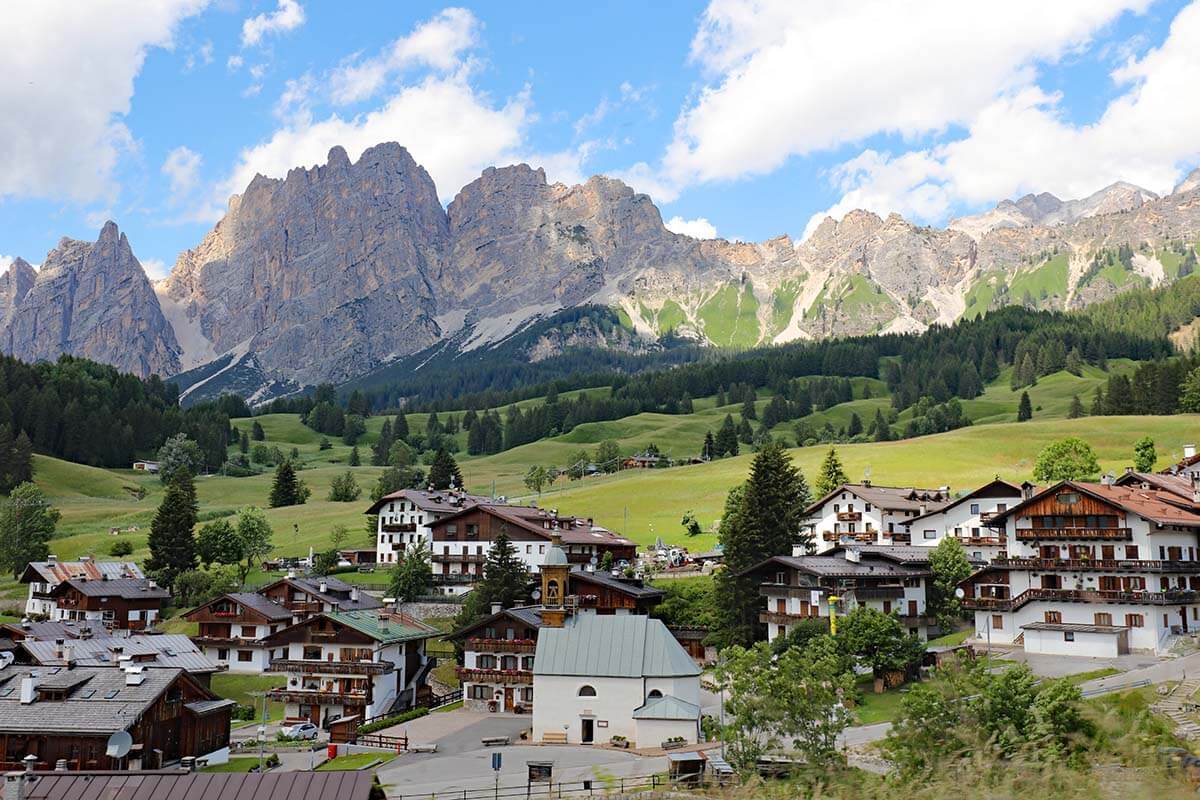
11. Cinque Torri
Cinque Torri (aka the Five Towers) is another popular mountain destination that you’ll often see mentioned among the best places to see in the Dolomites. But nobody tells you what it’s really about…
When researching information for our trips, we saw many pictures of the 5 towers and some recommendations to visit. But while it looked very beautiful, it just didn’t seem to have that ‘extra’ something that would make it worth visiting more than the other popular Dolomites destinations. And who has the time for all these places anyway… So we never made it here during our first trip.
However, on our second visit, we were staying in the nearby Cortina for a longer time, and so one day we decided to check it out. And we were so glad we did – Cinque Torri is so much more than its famous towers that you see in all the pictures!
The scenery here is absolutely AMAZING, with jaw-dropping views that will leave you speechless. In addition, there is a sort of an open-air museum, where you can walk through a series of restored WWI trenches and bunkers , which makes this place even more interesting and well worth visiting.
I’m not really a history fan, but this unique combination of war history and some of the most beautiful mountain scenery you can imagine, makes Cinque Torri one of my personal favorite places in the Dolomites! It’s also very easy and simple to visit, with minimal hiking if you don’t want to, but also plenty of hiking possibilities if you do have some extra time and energy. Highly recommended!
LEARN MORE: How to Visit Cinque Torri + Best Short Hike
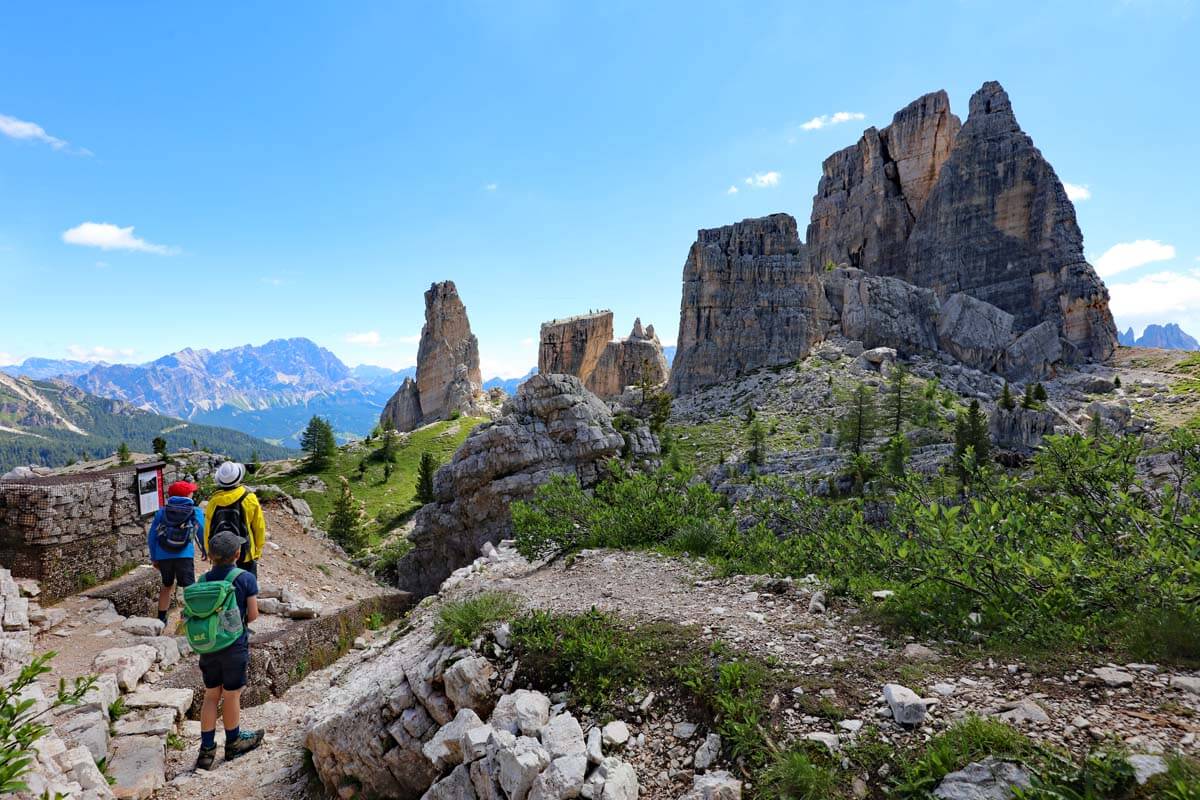
12. Passo di Falzarego / Mt Lagazuoi / Forte Tre Sassi
Falzarego Pass is another special place that is well worth visiting in the Dolomites. Also here, you’ll find some of the most beautiful mountain scenery, but also WWI history. So whether you are into nature and hiking, war sites and history, or both – it’s well worth coming here.
There are several places you can visit at Falzarego Pass and many ways to do it. The easiest to visit is the Forte Tre Sassi Museum which is located just next to the road, between Falzarego Pass and Armentarola. It’s open from mid-June to the end of September and is a great place to learn more about the gruels of the Great War and the history of the Italian Dolomites. For more information, please see the museum website .
Another popular place to visit are the Lagazuoi tunnels . You can reach them by taking a cable car from Passo di Falzarego and then hiking on top. Be sure to bring a flashlight! There are various hiking routes here.
Also if you don’t care about war sites, you can just come here for the scenery. The views from and around Rifugio Lagazuoi (at the top of the cable car) are unbelievable! You can also hike to Lago di Lagazuoi , and there are many more hikes here.
TIP: If you are looking for a short easy hike in this area, consider Lago di Limides .
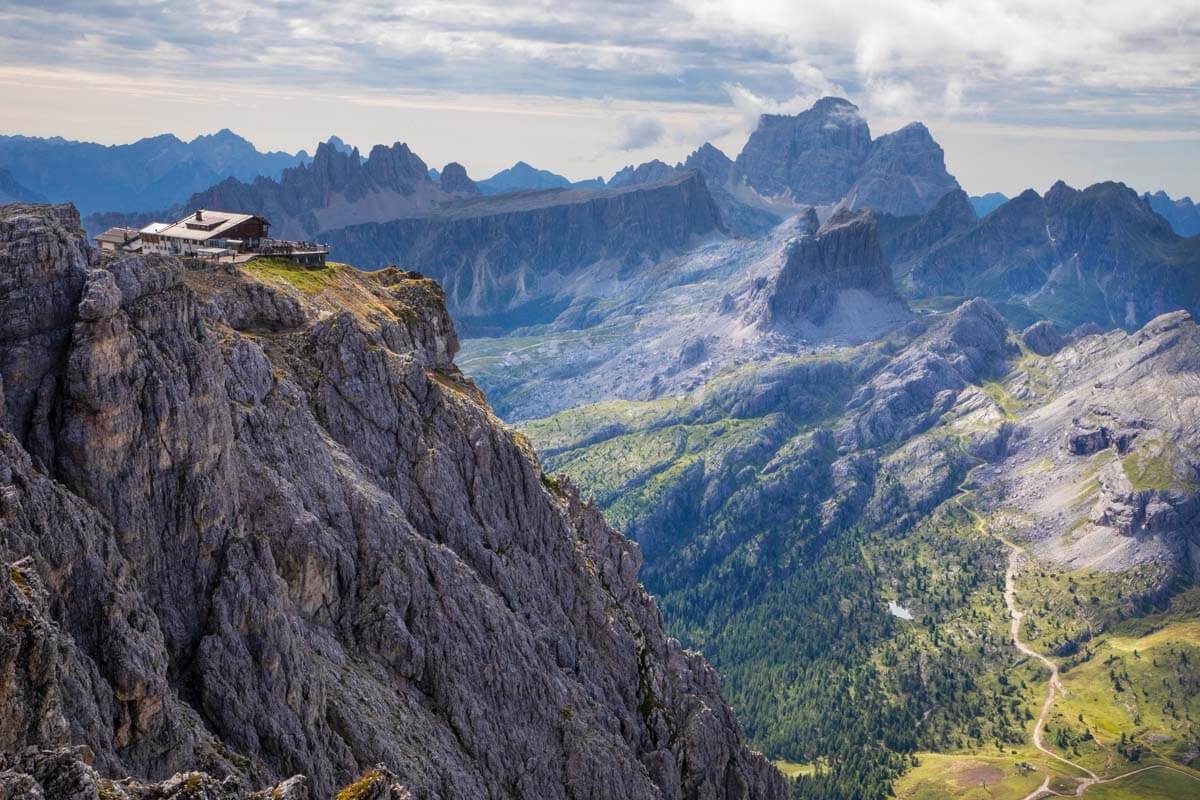
13. Lago di Misurina
Lake Misurina is one of the most beautiful lakes of the Dolomites and it’s also a place that you can easily visit when touring the region. The scenery here is wonderful and the views are great in any direction. When there is little wind, you also have beautiful reflections on the lake – picture-perfect!
In summer, you can walk all around the lake (count about 45 minutes if you do the entire loop), but there is also a nice boardwalk where you can just explore one side of the lake. You can also rent paddle boats at Lake Misurina. There are several hotels, restaurants, and a very good supermarket here as well.
Located just next to the road and very close to the famous Tre Cime di Lavaredo, there is really no excuse not to stop at Lake Misurina. And while you won’t be alone here, every time we visited, it was unbelievably quiet here comparing to Tre Cime… Furthermore, Lake Misurina is also one of the nicest places in the Dolomites that you can visit at any time of the year.
TIP: This would be a great place to stay for a night or two. Not only can you easily get to Tre Cime di Lavaredo from here (and beat the crowds by going very early in the morning), but it’s also a beautiful place to be in the evening when all the day tourists have left.
Check out the iconic Grand Hotel Misurina (it’s like sleeping inside a postcard!). Hotel Sorapiss and Hotel Miralago are also located here (overlooking the postcard-view) and offer good value for the price/location.
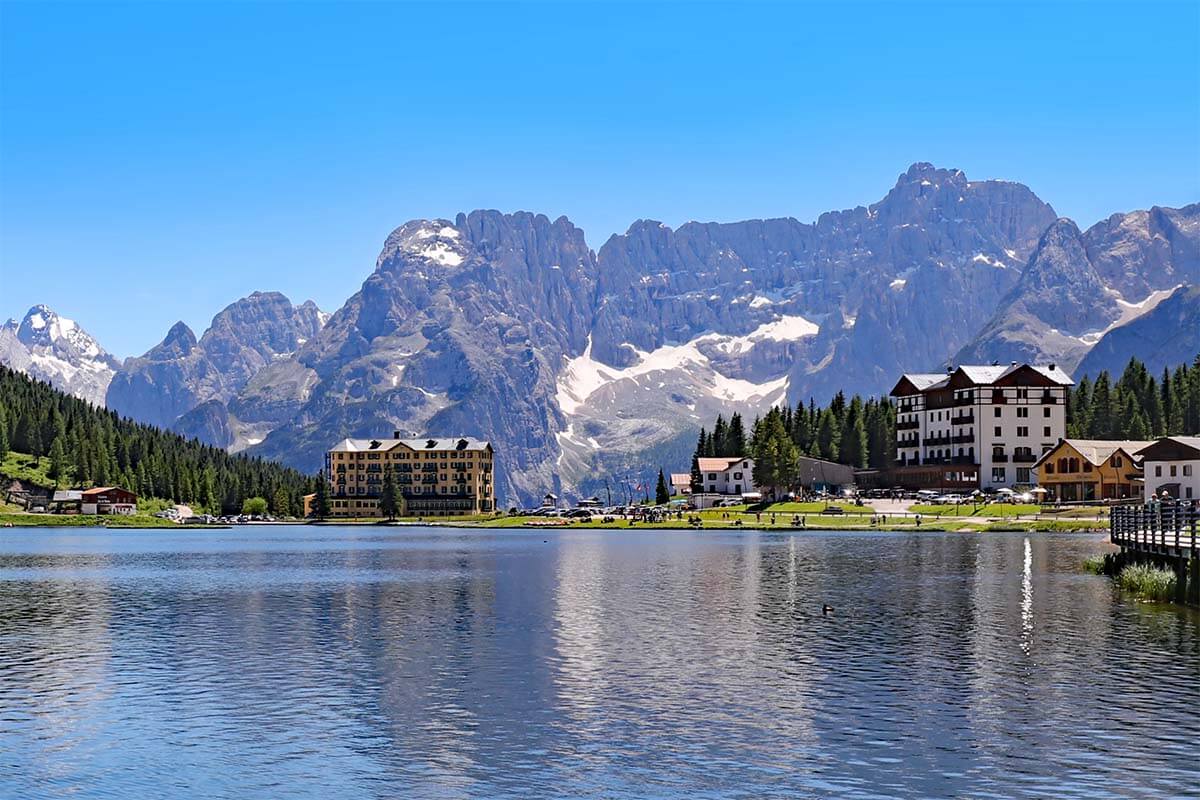
14. Passo Sella
Passo Sella is a mountain pass that connects Val Gardena with Val di Fassa (Canazei town) and is another of the must-do scenic drives in the Dolomites. Here, you have great views over the Sella group, Sasso Lungo, and Marmolada.
This road is very popular with cyclists and motorbikes, furthermore, there are lots of local and tour buses, camper vans, and cars… Let’s just say, you won’t be able to drive fast here most of the time. But this gives you plenty of time to enjoy the scenery (if not for the driver, then at least for the passengers).
There are lots of gondolas here and countless hiking trails. Sella Pass is also the perfect starting point if you want to explore the area around the famous Sassolungo (aka Langkofel) peaks.
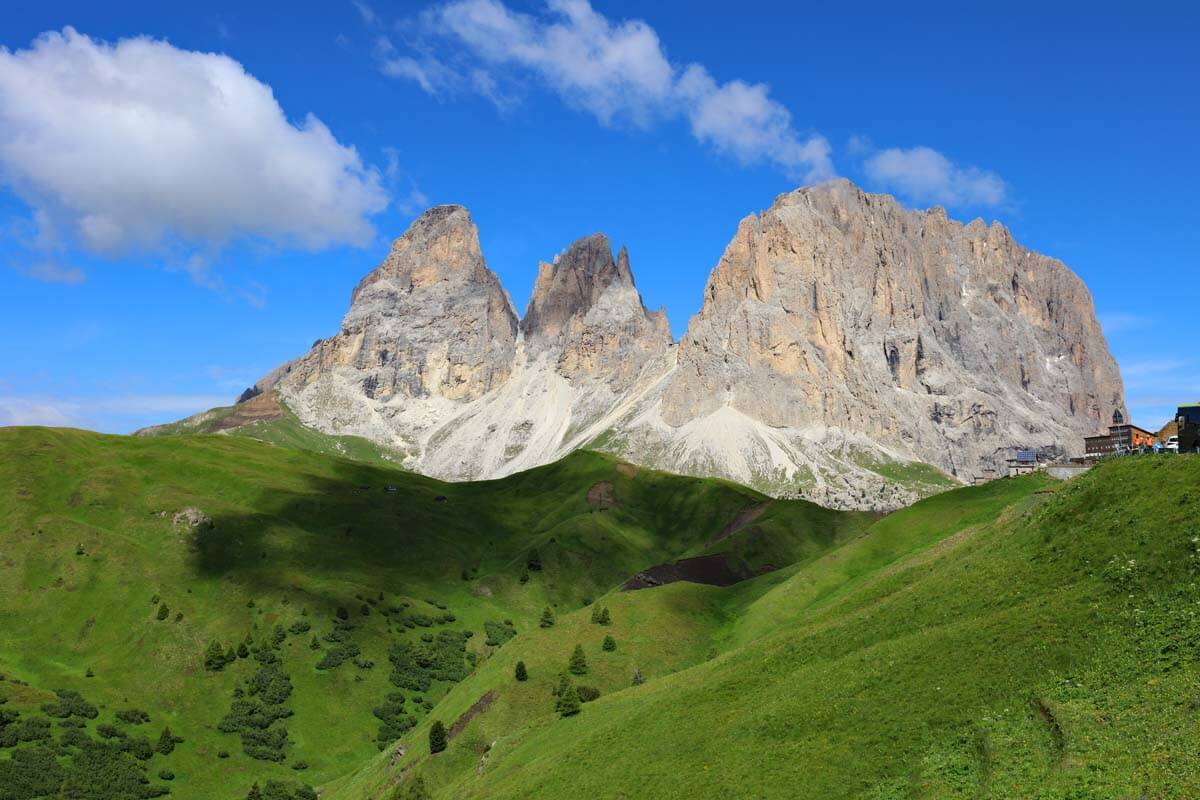
15. Lago di Carezza
If you are looking for fantastic views with little effort, check out the tiny mountain lake Lago di Carezza (aka Karersee or Lake of Caress). It’s one of the most picturesque lakes in the Italian Dolomites, and also one of the easiest to visit, so well worth a quick stop if you find yourself in this part of the Dolomites.
Because this lake is located right next to the road, has easy parking, and it only takes about 30 minutes to walk all around it (if you choose to), it’s a very popular spot attracting lots of people. For the best experience, visit here early in the morning – that’s also when the reflections are usually at their best.
Good to know: Swimming is not allowed in Lago di Carezza.
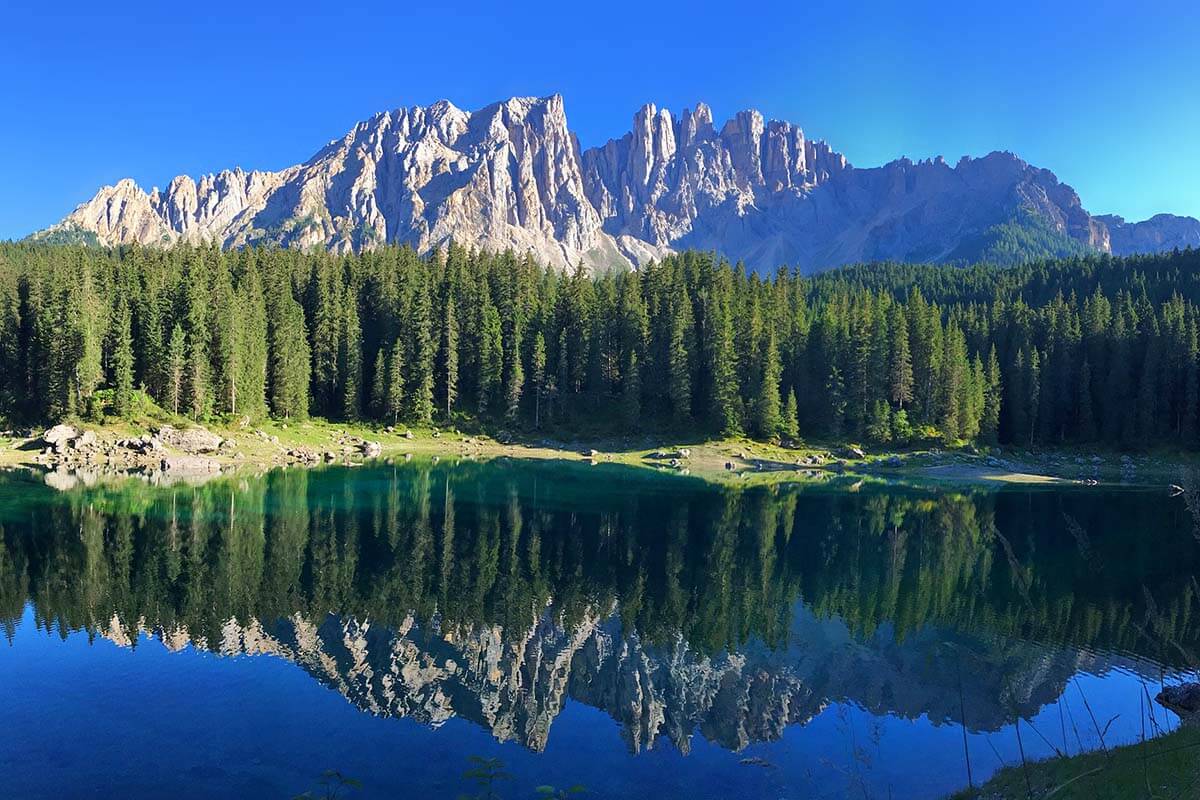
16. Lago di Federa
If you just can’t get enough of the beautiful mountain lakes in the Dolomites, you may also want to check out Lago di Federa . Located between Cortina and Falzarego Pass, this tiny lake is also a very popular place to visit in this part of the Dolomites.
I have to say, however, that this is one of those places that look better in the pictures than in reality. Furthermore, it’s not an easy visit as you can only get here by hiking… So I was a bit hesitant whether to include it in this list of the best places to see in the Dolomites or not…
The reason I decided to mention it is because of the amazing scenery of the area. So if you can visit Lago di Federa in combination with Forcella Ambrizola and also the area around Forcella Giau – Passo Giau, then it’s absolutely worth it!
However, if you are short on time and have to be more selective with how many places you can squeeze into your itinerary, then I wouldn’t come here just for this lake. The earlier-mentioned Lake Misurina, Lake Carezza, Lake Limides , and also Lake Dobbiaco are so much easier and simpler to visit and – in my opinion – are worth your time more.
If you decide to visit here, check out our guide to the amazingly beautiful hike we did in the Lago di Federa area! It’s a wonderful hike, not too busy, and well worth it if you are looking to do something a bit less touristy than most other places mentioned on this list.
LEARN MORE: Lago di Federa Hike from Passo Giau
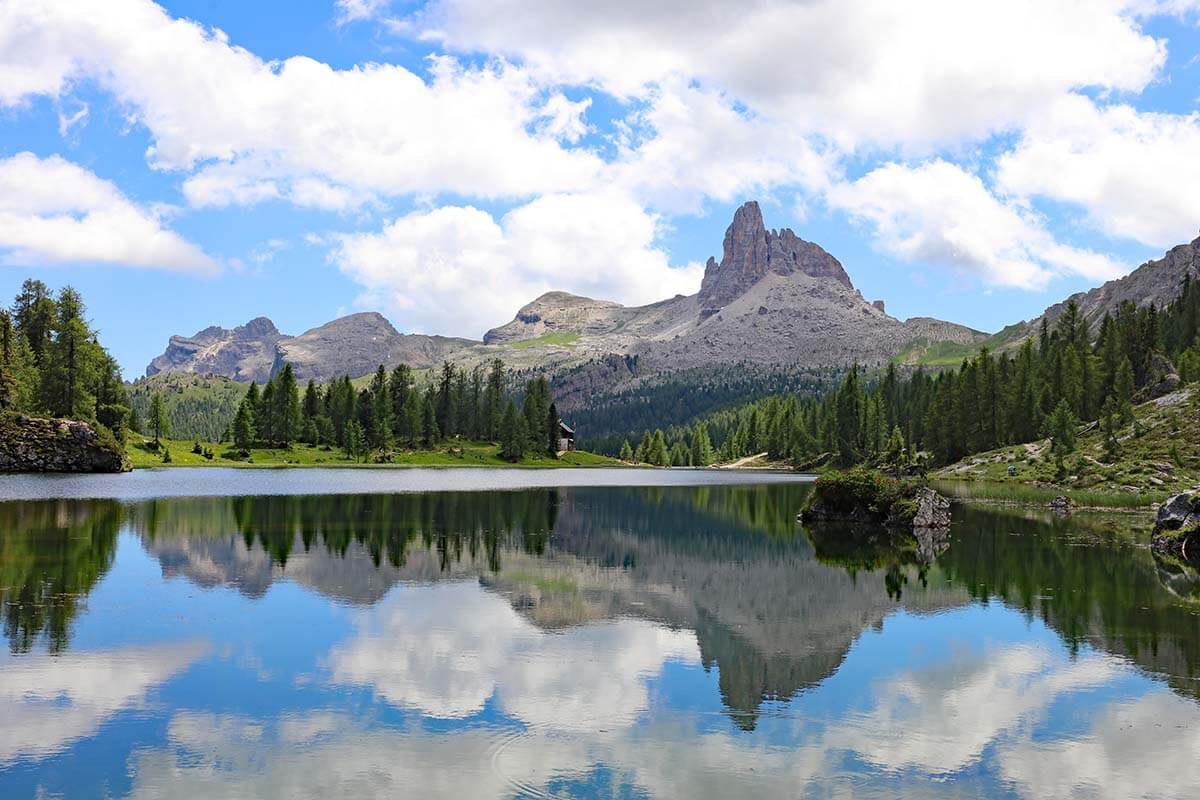
So, this is our selection of some of the best things to do in the Dolomites, Italy. And no, this is in no way a complete guide to ALL the best places in the Italian Dolomites – you would need several months for that… For starters, you may want to also read our guide to the most beautiful lakes in the Dolomites .
But if you are visiting the Dolomites for the first time and want to experience the very best that this stunning region has to offer, then this list should give you a good idea of where to go and what’s worth your time the most.
TIP: If you are wondering how to best plan a trip covering as many of these places as possible, please see our Dolomites itinerary suggestions . It contains sample itineraries for any trip from 1 day up to a week and more. Check it out!
Below, you can also find some frequently asked questions for planning your visit to the Dolomites . Check it out!
Dolomites FAQ
The Dolomites is a very big mountain region in Northern Italy stretching through three Italian regions: Veneto, Trentino-Alto Adige (South Tyrol), and Friuli Venezia Giulia. The Dolomites region is about 2 hours drive north of Venice or from Lake Garda , and about 1.5 hours south of Innsbruck (Austria).
The easiest way to get to the Dolomites is by car or by arranging a private shuttle. Some areas also have good connections by public transport, but it really depends on where exactly you are traveling to/from. You can also visit the Dolomites with an organized tour from various locations including Venice, Lake Garda, or Bolzano.
To make the most of a trip to the Dolomites, you’ll definitely need a car. While in high season there are buses between some of the major tourist areas in the Dolomites, they usually only run a few times a day and aren’t always very reliable. Public transport is doable for some places, but if you want to explore the Dolomites to the fullest, it’s best to visit by car. You can easily rent a car at any bigger city or airport and car hire prices are very reasonable in Italy. We use this website to find the best deals for car rental for our trips.
While you can visit some of the nicest places in the Dolomites in one or two days, you should really plan at least 5-6 days if you want to explore the region somewhat deeper. This will allow you to quickly see most of the Dolomites best places mentioned in this list and do a few of the best hikes. If you want to drive all the scenic roads, do all the hikes, and visit all the places mentioned in this article, you’ll need at least 2 weeks and they will be packed. My advice is not to try to see ‘everything’, but to choose a few places and take your time to enjoy the scenery!
The best time to visit the Dolomites depends on your interests. Summer months are best for hiking, amazing scenery, and to be able to access all the best places in the mountains. Whereas winter is a wonderful time for skiing and other winter activities. The shoulder season (Oct-Nov and April-beginning of May) is probably the least good time to visit Italian Dolomites.
There are many airports where you can fly to for the Dolomites. The closest airports are Venice Treviso, Venice Marco Polo, or Bolzano regional airport. Also Innsbruck airport (Austria) is a good option and even Milan or Munich (Germany) can be good options with good intercontinental connections as well.
The best place to stay in the Dolomites depends a lot on what you want to see. If you want to visit all the best places in Dolomites, I highly recommend that you stay at a few different locations for a few days each as that will save you a lot of driving. Staying in Val Gardena or Cortina d’Ampezzo are the best options for exploring the Dolomites. Don’t get fooled by seemingly close distances! The roads here are crazy (and busy), so it’s really not ideal to stay in one place if you want to see all the best places in the Dolomites.
LEARN MORE: Where to Stay in the Dolomites
More inspiration for visiting Italy:
- Best Cities to See in Italy
- Best Places to Visit in Italy
- Italy Itinerary for 2 Weeks
- Best of Lake Como
- Best of Lake Garda
- Best Things to Do in Venice
- 1 Day in Venice
- 3 Days in Venice
- How to Visit Venice by Car
- Tips for Venice Gondola Ride
- Doge’s Palace
- Venice with Young Kids
- Best Things to Do in Rome
- Hidden Gems of Rome
- Colosseum Levels & Tickets Explained
- 1 Day in Rome
- 2 Days in Rome
- 4 Days in Rome
- Tips for Visiting Rome
- Best Area to Stay in Rome
- Rome Airport Transfers
- Rome Street Food Tour
… for more travel inspiration and info on a big variety of popular destinations in Italy, please see our Italy travel guide .
If you found this post helpful, don’t forget to bookmark it and share it with your friends. Are you on Pinterest? Pin these images!
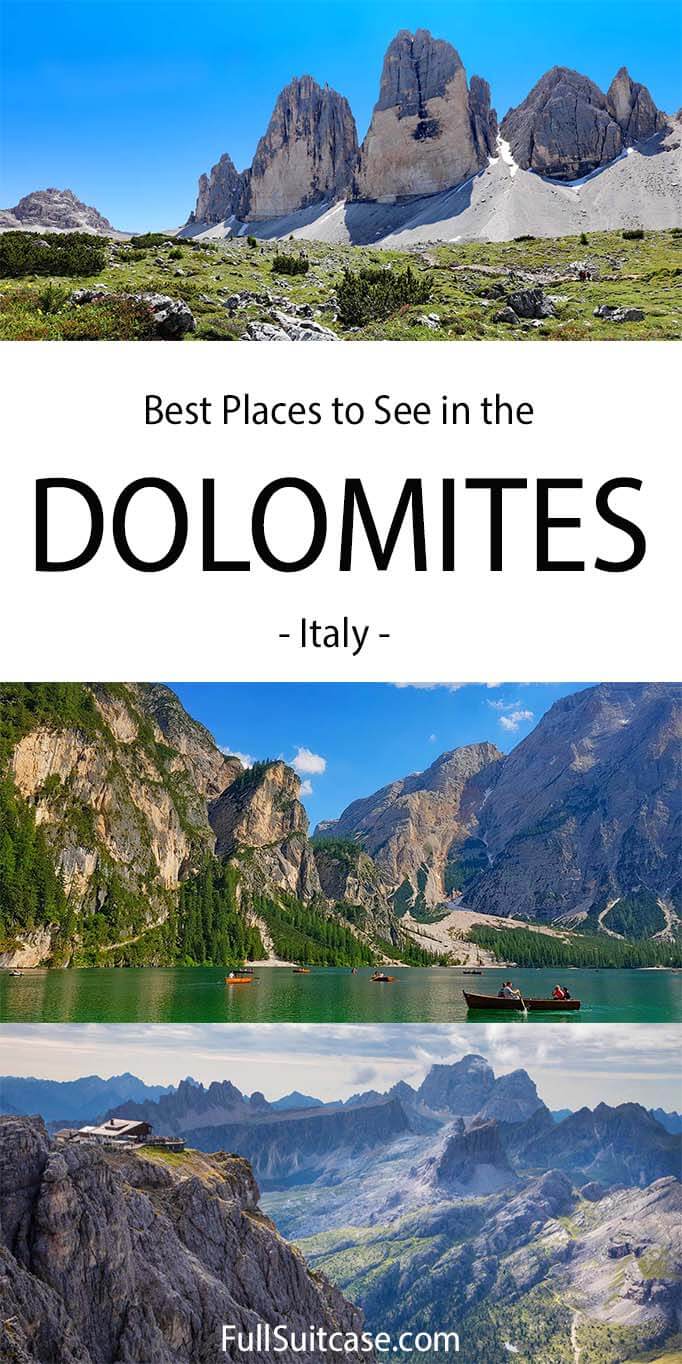
This site uses Akismet to reduce spam. Learn how your comment data is processed .
Saturday 20th of April 2024
This is the best and most useful Dolomites resource I've found online. It has really helped with planning my trip. Your list is very inspiring, we can't wait to visit the Dolomites! Thank you!
Monday 22nd of April 2024
Thank you for your kind feedback, Sarah. Have a great trip to the Dolomites!
Tuesday 28th of February 2023
What if I only can be in the Dolomites for three day...where do I stay? Do I hit your 1-3 suggestions?
As I am rereading this, I think I'm all set. I see your suggestions for Cortena and then Val Gardena. Wonderful blog!
Tuesday 31st of January 2023
Hello! I've been studying your blog for a family trip I am planning this summer (my kids are college aged).
We are either going to go to Switzerland and see the areas around Interlaken for a few days and then a few days hikes in the Apenzell area.
However, the Dolomites look beautiful too and I'm struggling at deciding which to visit. We want to hike (nothing very intense) but we are good for average hikes. We don't want to camp and would prefer an airbnb or hotel.
I'd love your opinion on which you would choose if you only went to one.
Wednesday 1st of February 2023
Hi Katherine, both are really beautiful destinations and you really can't go wrong with either. The scenery is amazing in both areas, but in Switzerland, you have more snowy peaks and green Alpine pastures, whereas in the Dolomites, the mountains are 'rockier'. Summer will be very busy at both destinations. There are a few major differences though: First, in Switzerland, you can usually get a ticket for a train/gondola to the mountains and hike around at the top or hike downhill. Whereas in the Dolomites, for most places, you just arrive and start to hike. Some areas have gondolas, but not that many. So depending on which hikes you choose, it can be easier or tougher. Also, even if you have to take gondolas in the Dolomites, it's incomparably cheaper than in Switzerland. That being said, in Switzerland, if you stay in one area for a few days, you can usually get regional cards which make it much more affordable compared to buying day tickets. Still, it will be much more expensive than anything you do in the Dolomites. And finally, accommodation costs can be quite expensive in both places, but food and transportation is also much cheaper in Italy. Hope this helps a bit. Whatever you choose, I'm sure you'll love it! PS If you are looking for some inspiration for hiking around Interlaken, check out Schynige Platte. It's stunning! Also Oeschinensee is a wonderful place to hike. For the Dolomites, check out this guide to our favorite hikes.
Thursday 26th of January 2023
This is such an incredible, thoughtful resource as I plan my first trip to the Dolomites. I especially appreciate how you've tagged all the photos with the spot they were each taken. Thank you so much!
Friday 27th of January 2023
Glad to help, Eki. Have a great trip!
Preyta Hang
Wednesday 30th of November 2022
hello! we're planning a trip this summer, will probably stay in val gardena area for a few days using one of your itinerary. i'm not sure if i will be comfortable to drive. do you think we can still see some amazing places w/out a car?
Friday 2nd of December 2022
Hi Preyta, Val Gardena has a bus service (free with a card that you get when staying in most of the local hotels) that can bring you to some nice places nearby. You won't be able to see a lot of the Dolomites that way, but you can see most of the Val Gardena region, and the scenery there is stunning. You could spend a few weeks there and have a great time even without a car. But if you want to visit most of the places mentioned in this article, then you'll definitely need to rent a car (and ideally not stay in Val Gardena all the time, but spend a few days in the area around Cortina d'Ampezzo). Hope this helps!

How to Get to the Dolomites: Ultimate Guide on Transportation
Some of the links may be affiliate links , and at no cost to you, I earn a small commission if you make a purchase. I only recommend stuff I love and use, and the income goes back into making this little blog successful!
The Dolomites are my favorite mountain range in northeastern Italy. Although they are less famous than the Swiss Alps, they are no less stunning. While getting to the Dolomites is a bit more difficult than most areas, there are a few options—some better than others, as you’ll soon find out!
From spending multiple summers hiking, via ferrata’ing, and hut-to-hutting in these mountains, here’s what I’ve learned:
- There is no airport that goes directly to the Dolomites 🙈, but several good options are nearby in Venice, Milan, Innsbruck, and Munich.
- While the bus and train systems can take you from the airport to a few of the bigger towns in the Dolomites, the BEST way to get to the Dolomites is by flying into a nearby airport and renting a car for your trip.
- The Dolomites are very well connected by the Italian highway system. This means two lanes one way, two lanes the other – sometimes only one lane in each direction deep in the mountains.
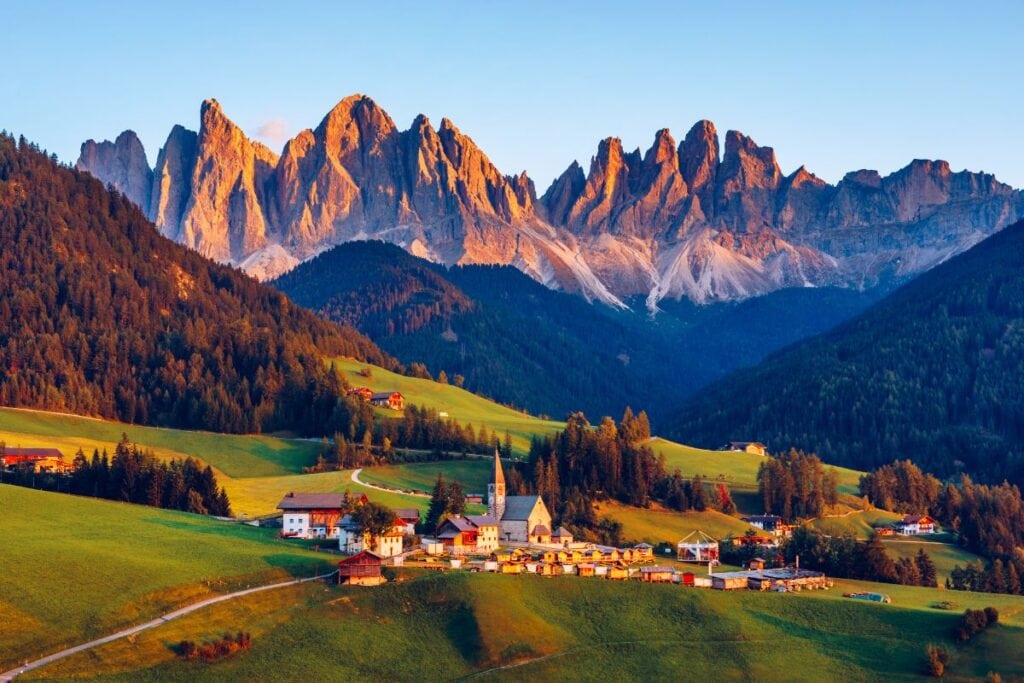
LODGING TIP: My favorite towns to home base in are Cortina d’Ampezzo on the east side of the mountains and Ortisei or Bolzano on the west side of the mountains. If the prices are too crazy during the summer and fall season, look at the little towns near those.
I’ll go into all the options of how to get to the Dolomites, the pros and cons, and my recommendation, but whichever way you choose to explore these majestic rocks, you’re gonna love them – I promise!
Table of Contents
The Best Way to Get to the Dolomites
Surprise, Surprise! There is no Dolomites Airport at our convenience, but there are plenty of airports within a 2-5 hour driving distance from the mountains. The best way to get to the Dolomites is to fly into one of these airports and rent a car to start your Dolomites adventure.
⭐️ Fly To A Nearby Airport & Rent A Car
If you are budget-conscious with your money and time, then selecting an airport to fly into is the second most important decision outside of selecting your home base. In my experience, flying to Venice Airport is the best option , then renting a car to explore from there.
➡️ I use DISCOVER CARS to check car rental prices! ⬅️
Note : There will be a fee if you take the rental car out of the country you rented it. It’s also cheaper to rent & return in the same location.
✈️ What is the closest airport to the Dolomites?
There are quite a few airports close to different parts of the Dolomites, but Venice Airport is the closest one to the main towns like Cortina and Bolzano, so it’s your best bet.
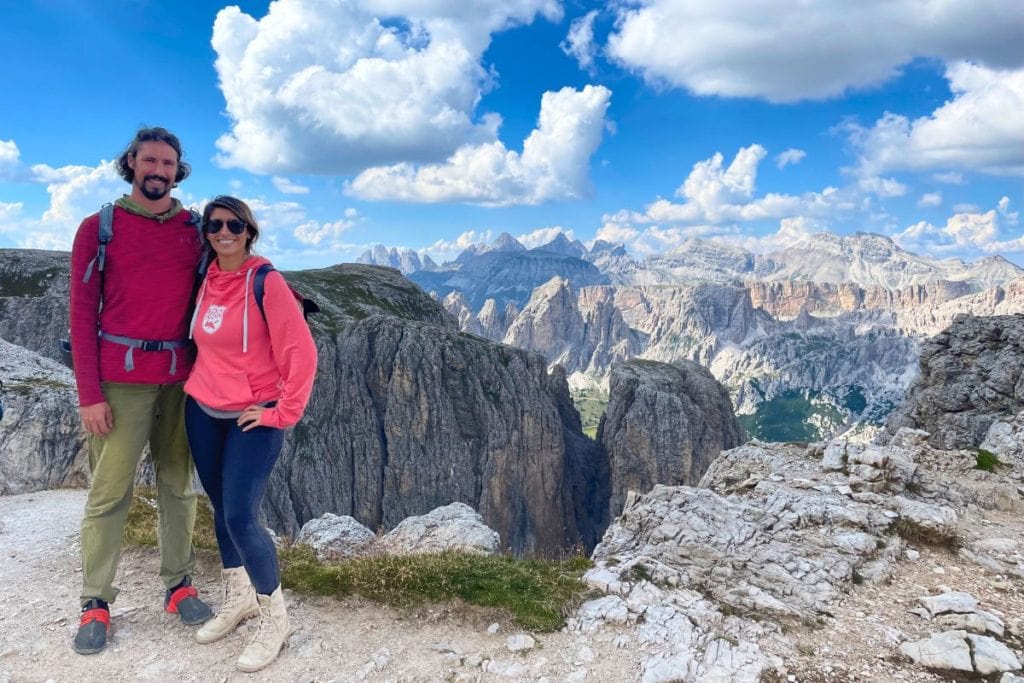
I’ve included estimated drive times from each nearby airport to both Bolzano, the capital of the region on the west side of the mountains, and Cortina d’Ampezzo in the west because there are a ton of amazing hikes there. This way, you can have an estimation of how long it will take you to get to the Dolomites once you land.
- 2 hours, 45 minutes to Bolzano
- 2 hours to Cortina d’Ampezzo
- 1 hour, 40 minutes to Bolzano
- 3 hours, 30 minutes to Cortina d’Ampezzo
- 3 hours to Bolzano
- 3 hours, 30 minutes to Bolzano
- 5 hours to Cortina d’Ampezzo
- 1 hour, 45 minutes to Bolzano
- 2 hours, 30 minutes to Cortina d’Ampezzo
- 4 hours, 30 minutes to Cortina d’Ampezzo
- 4 hours, 45 minutes to Bolzano
- 5 hours, 30 minutes to Cortina d’Ampezzo
PRO TIP : The airport dictates how long you will have to transit to your home base in the Dolomites (via bus, car, or train) and how much your rental car will be, so play with the options.
I recommend flying into the Venice Airport and renting a car there for a few reasons:
- It’s a bigger international airport compared to Bologna & Verona, so there are more connecting flights from the bigger airport hubs.
- It’s the closest driving time to the Dolomites compared to the other Italian cities like Milan.
- Renting a car from Austria, Germany, or Switzerland may be ‘cheaper’ up front, but there is a standard ~€100 fee for crossing country borders , which is paid upon pickup and therefore not reflected on rental car websites.
Check Prices for Rental Cars to the Dolomites here: ▶️ DISCOVER CARS ◀️
PRO TIP : Be careful of distances on mountain roads , as they are deceiving! You should map out each airport to your home base to see how long it will take because it usually takes longer than you think. It once took me 1 hour to drive 10 km because of the winding serpentine roads, no joke!
Before you hit the road, make sure you review Renting a Car in Italy: Common Mistakes & Tips , where I go into a few unique road rules, documentation requirements, and experience driving through the land of Dolce Vita.
How To Get To The Dolomites Without a Car
If renting a car is not your vibe for whatever reason, the Dolomites has an amazing public transportation system of buses, trains, and cable cars. This website was immensely helpful even though we had a car: SudTirol Mobility .
🚌 Public Transportation: BUS
Busses are pretty good in the Dolomites, and well connected to major towns and popular hikes, but you do lose some of that flexibility.
I’m a bit wary of taking buses because I tend to get a bit carsick on the windy roads, and if you’ve ever seen an Italian bus driver navigate mountain roads – well, they are skilled, but holy shit, I get Final Destination vibes.
MY BEST ADVICE: Fly into Venice Airport and take the Express Shuttle from Venice Airport to Cortina . The bus will take you directly to Cortina d’Ampezzo for about €10, and the ride is about 2 hours. Cortina is a good starting point town for exploring the Dolomites.
🚂 Public Transportation: TRAIN
Most trains arriving from North Europe will go through the Brenner pass, stopping at hubs such as Bressanone , Bolzano , and Trentino . This includes the daily trains from Munich and Innsbruck or Vienna. From these hubs, you can catch regional buses to your home base in the mountains, but also major towns and hikes.
NOTE : Cortina does not have a train station , but there is a good bus connection to the nearest railway station at Calalzo.
If you’re traveling from the west or south, trains and buses will take you from almost anywhere in Italy to either Verona or Venice Mestre train station , and then on to the main towns in the Dolomites by bus. When booking tickets to the Dolomites, do it early so you get a better deal!
PRO TIP: SudTirol Mobility is the best to navigate and book tickets to trains and buses around the Dolomites. You can buy a 1, 3, and 5-day pass at tourist info spots or any hotel. There are also little ticket stations. Either way, it’s cheap and effective!
How Do I Get To The Dolomites From…
How do i get to the dolomites from venice.
- Rent a Car and drive ~2 hours to your destination in the Dolomites.
- By Train: Venice Mestre Train Station to Bolzano Train Station ( 1 Transfer at Verona ) Time: 3 hrs, 30 min | Get Tickets
How do I get to the Dolomites from Munich?
- Rent a Car and drive ~4 hrs to your destination.
- By Train: Munich Hbf Train Station to Bolzano Train Station ( Direct ) Time: 4 hrs | Get Tickets
How do I get to the Dolomites from Milan?
- Rent a Car and drive ~5 hrs to your destination.
- By Train: Milan Centrale Train Station to Bolzano Train Station ( 1 Transfer in Verona ) Time: 4 hrs | Get Tickets
How do I get to the Dolomites from Zurich?
- Fly to Venice. Then Rent a Car and drive ~3 hours to your destination.
- By Train: Zurich HB Train Station to Bolzano Train Station ( 1 Transfer in Verona ) Time: 7 hours | Get Tickets
How do I get to the Dolomites from the UK?
- Fly to Venice . Then Rent a Car and drive ~3 hours to your destination.
- Fly to Venice. Take a train to Bolzano Train Station. Get Tickets here.
Where to Stay in the Dolomites
There are a few towns I recommend looking to get lodging in, each close to certain iconic trails and hikes. During the peak summer and fall season, I recommend booking early, and expecting a minimum of 2-3 night mandatory stay. I’ve seen prices average about $300 a night, including breakfast.
✅ Cortina d’Ampezzo is ideal for Cortina town and everything around it, like Lago di Sorapis, Tre Cime di Lavaredo, Cadini di Misurina hike, Cinque Torri, and Croda da Lago. A few” hut-to-hut” excursions start here, too, and there are a bunch of via Ferratas around as well!
✅ Ortisei – Val Gardena was where I’ve lodged a few times and is ideal for Alpe di Suisi hikes, Seceda peaks, Sella Massif, Gran Cir, and Passo Gardena. It’s a cute area with lots to offer and my first choice of lodging in the Dolomites.
✅ Santa Magdalena – Val di Funes is another hub (smaller) I’ve stayed in and is best for the Adolf Munkel hikes and Geisler Alm, some of the most iconic hikes in the Dolomites.
✅ Bolzano is obviously great for Bolzano town, Strada del Vino, and Merano. I think it’s a bit far from a few of the more iconic hikes, but a lovely spot nonetheless.
If it’s your first time heading into the Dolomites, check out some of my favorite hikes , and decide what town speaks to you.
Adolf Munkel Hike to Geisler Alm – stay in Ortisei Cadini di Misurina Ridge Hike – Stay in Cortina Seceda Ridgeline Hike – Stay in Ortisei Tri Cime di Lavaredo – Stay in Cortina
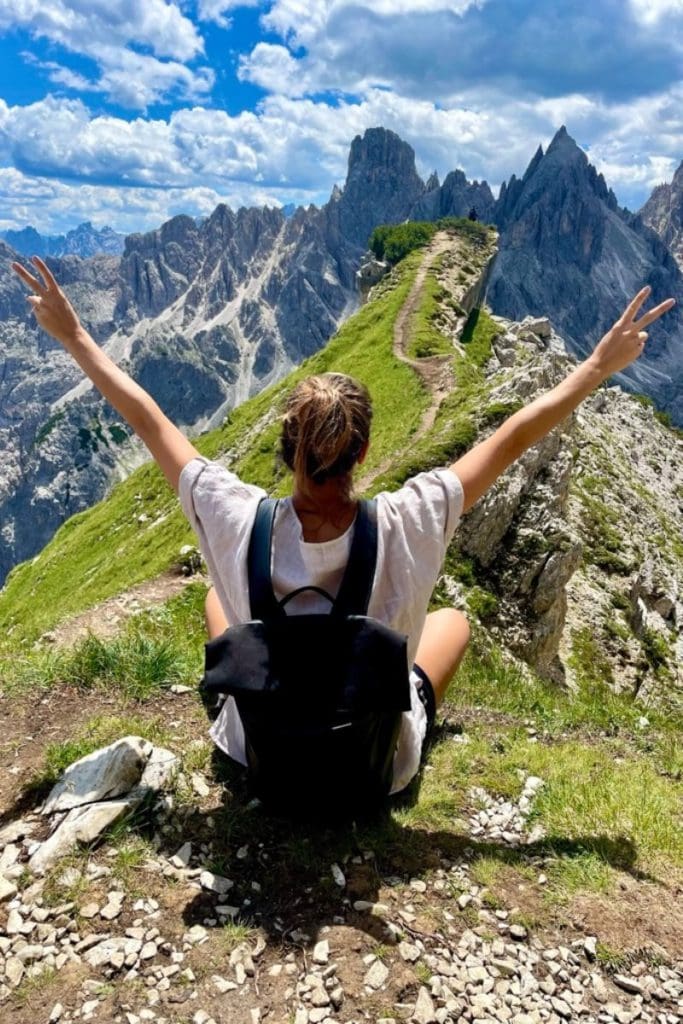
Travel Tips for the Dolomites
Here are some lessons learned and travel tips for planning your trip to the Dolomites.
Are the Dolomites worth visiting?
A thousand times, yes, the Dolomites are worth visiting!
Over the years, I’ve fallen in love with Italy because it’s so damn charming and diverse in what each region has to offer; it has mountains, plains, hills, coasts, islands, you name it. The food is great, the wine is fantastic, the prices are lower than most other European destinations, and the locals are friendly and cute!
All that said, the Dolomite Mountains are my favorite spot in Italy. It’s unique and gorgeous in all seasons, the food is excellent, nature is at its best and showing off every day, and the air is filled with adventure. I lived my healthiest and simplest vacation life in the Dolomites, and that is what makes it worth it for me!
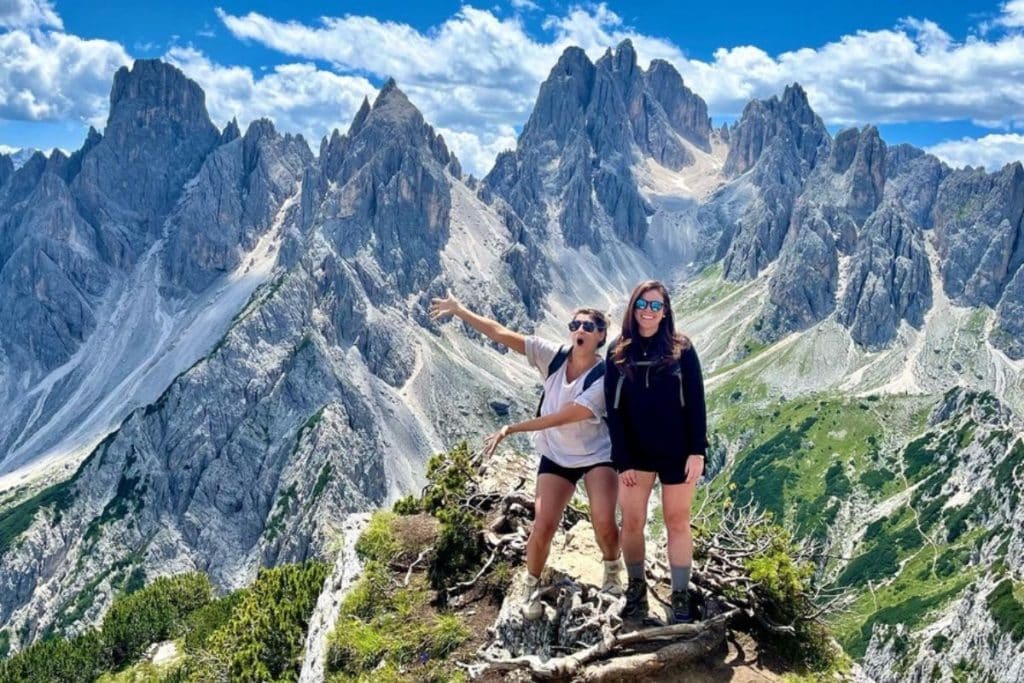
2 Week Road Trip in Italy & Switzerland
This is one of my favorite road trips in the summer because we spent one week in the Dolomites and another week in the Swiss Alps. The best of both worlds is achievable!
Do I need travel insurance when visiting the Dolomites?
Yes, anytime you travel outside of your country, you need to cover your @ss. It’s quite cheap and offers protection in case of emergencies – because those happen. Plus, it’s super cheap and you can call 24/7 and talk to fellow travelers like yourself to get info and help as you need it.
This is what I use: Safety Wing Insurance
Note: You can buy it while you’re traveling as well, like that one time I decided to go up a via Ferrata in the Dolomites and it was my second time attempting such a feat! Yea, it’s a no-brainer on the travel insurance!
When is the best time to visit the Dolomites?
I think the summer and early fall (July to September) are the best to go into the Dolomites because you have wonderful weather, flowers blooming, great hiking, paragliding, swimming, etc. All the summer sports are available to you and all the rifugios, huts, and restaurants are open.
For the lower tourist season and the thrill of snow and winter sports, the winter and spring season will be best. Here are in-depth Season-to-Season Pros and Cons and Things To Do in The Dolomites .
How many days do you need in the Dolomites?
I recommend at least five days to really see some of the best the mountains offer. Traveling to the Dolomites takes half a day, and each day only allows time for one big hike—two hikes if they’re close to each other and short enough.
Are the Dolomites expensive?
No, and costs also fluctuate with the time of year you go, summer being the most expensive. Season aside, the most expensive parts will be lodging.
Here is a rough outline based on some of my road trips to the area during the peak summer season.
- Flight : Credit Card & Airline points!!
- Car Rental : €50 per day ( Renting a Car in Italy: Common Mistakes )
- Lodging : €300 per night
- Funiculars/Gondolas: €30-50 per gondola, per person
- Most lodgings included a hearty breakfast
- We ate out half the time and cooked in / snacked the other half
- Nature in Your Life : Priceless!
Wrap Up: Is it Hard to Get to the Dolomites?
Compared to most other places, I would say yes. That said, the Dolomites are very well connected by the Italian highway systems. Not only that, there are several airports nearby with shuttles to the mountains.
And while the bus and train systems can get you to the main towns, the best way to navigate these roads for fresh air and adventure is by flying to the nearest airport, renting a car , and exploring at your own pace.
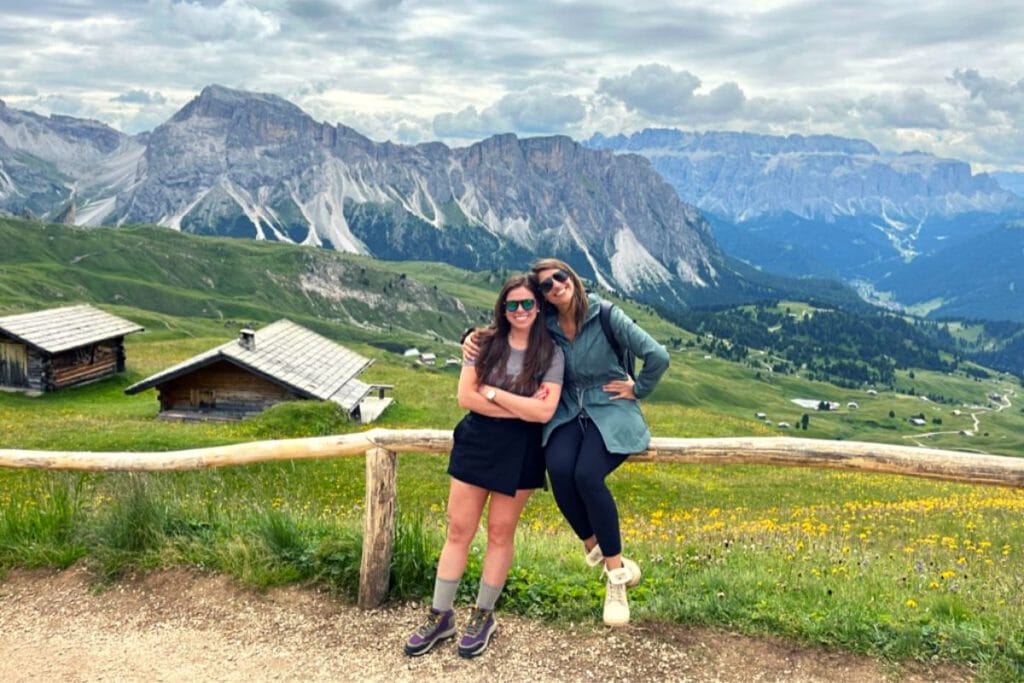
Mariana Barbuceanu is the owner and author of the Road Trip EuroGuide, a blog that inspires fellow travelers to explore Europe more authentically through slower travel and digging deeper into the culture of a place. When she isn't writing about her adventures, she is planning trips for her community and coaching people on how to take that next step towards a much-needed sabbatical.

How to Travel the Dolomites: A Beginner’s Guide to Planning Your Trip
To travel to the Dolomites, plan early starts for the best light. Explore Lago di Braies and other popular spots. Rent a car from Venice or Milan for easy access. Use bus services for local travel. Focus on 2-4 bases in your itinerary to enjoy hiking, skiing, and stunning views while receiving helpful travel tips.
Consider transportation options. Renting a car provides flexibility, while public transport is available but may require more planning. Create a list of hikes and viewpoints you want to explore. The Tre Cime di Lavaredo and Lago di Braies are must-see destinations.
Pack appropriately for varying weather. Layered clothing is essential for changing temperatures in the mountains. Don’t forget comfortable hiking shoes and a quality camera to capture the stunning landscapes.
As you plan your journey, understanding local customs and basic Italian phrases can enhance your experience. Now that you’re equipped with essential tips for traveling the Dolomites, let’s examine the best hiking routes and activities to immerse yourself fully in this breathtaking region.
Table of Contents
What Are the Dolomites and Why Are They a Must-Visit Destination?
The Dolomites are a mountain range located in northeastern Italy and are renowned for their stunning landscapes, unique rock formations, and outdoor activities. They are a must-visit destination for their natural beauty, diverse recreational opportunities, and cultural richness.
- Natural Beauty
- Outdoor Activities
- Cultural Heritage
- Unique Geology
- Accessibility
The Dolomites are notable for several key factors that contribute to their appeal.
Natural Beauty : The Dolomites boast breathtaking scenery, characterized by dramatic peaks and lush valleys. The UNESCO World Heritage Site designation highlights their global significance. According to the UNESCO website, this area is recognized for its extraordinary beauty, rich biodiversity, and unique biodiversity.
Outdoor Activities : The Dolomites offer a wide range of outdoor activities. These include hiking, skiing, rock climbing, and mountain biking. For example, the Alta Via 1 is a famous hiking trail that attracts enthusiasts from around the world. The Visit Dolomites website reports that nearly 1.8 million visitors engage in outdoor sports every year.
Cultural Heritage : The region is rich in cultural heritage, with a blend of Italian and Ladin influences. Traditional customs, architecture, and cuisine reflect this unique mix. Travelers can explore historical towns like Cortina d’Ampezzo and experience local festivals.
Unique Geology : The Dolomites’ distinctive geology includes pale limestone formations that are rare worldwide. This unique geological makeup offers insights into Earth’s history. Geologists like ltaly’s University of Bologna professor Enrico Bonifacio have studied these formations to understand the region’s climatic evolution over millions of years.
Accessibility : The Dolomites are easily accessible from major cities like Venice and Bolzano. Well-developed transport links, including highways and public transport, make exploration convenient. According to the Dolomiti Superski website, the region sees over 3 million tourists annually, showcasing its popularity and accessibility.
In summary, the Dolomites are a captivating destination due to their natural beauty, recreational activities, cultural richness, unique geology, and accessibility.
When Is the Best Time to Travel to the Dolomites for Ideal Weather and Activities?
The best time to travel to the Dolomites for ideal weather and activities is during the summer months, from late June to mid-September. During this period, temperatures range from 20°C to 30°C (68°F to 86°F), which is comfortable for outdoor activities. The weather is generally stable, with plenty of sunshine, making it perfect for hiking, biking, and exploring the scenic landscapes. Additionally, summer offers a wide range of festivals and events, enhancing your travel experience. Alternatively, early autumn, particularly September and early October, also provides pleasant weather for outdoor enthusiasts. This time features fewer crowds and stunning autumn foliage, offering a unique experience. Winter, from late December to March, is ideal for skiing and snowboarding, attracting winter sports enthusiasts.
How Do You Get to the Dolomites?
To reach the Dolomites, you can travel by train, car, or plane, each offering unique advantages based on your starting location and preferences.
Traveling by train: – Trains offer a scenic and relaxing option. Major train stations, such as Bolzano, Innsbruck, and Venice, connect to various parts of Italy and Central Europe. – From Bolzano, you can reach the Dolomites via regional buses or car rentals.
Driving a car: – Renting a car provides flexibility and convenience. The Dolomites are accessible via well-maintained roads from cities like Venice, Bolzano, and Verona. – The drive from Venice to Cortina d’Ampezzo, for example, takes about 2 hours and 30 minutes over approximately 160 kilometers (100 miles).
Flying to a nearby airport: – The nearest major airports include Venice Marco Polo Airport, Treviso Airport, and Verona Airport. – From these airports, you can rent a car or take shuttle services to the Dolomites. For example, a drive from Venice Marco Polo Airport to the Dolomites typically takes around 2 to 3 hours.
Regardless of your chosen method, planning ahead will enhance your journey to this picturesque region.
Which Airports Are Closest to the Dolomites for International Travelers?
The closest airports for international travelers visiting the Dolomites are as follows:
- Bolzano Airport (BZO)
- Treviso Airport (TSF)
- Venice Marco Polo Airport (VCE)
- Innsbruck Airport (INN)
- Verona Villafranca Airport (VRN)
These airports offer various travel routes and conveniences for visitors. Some travelers prefer smaller airports for quick access, while others choose larger ones for more flight options.
Bolzano Airport (BZO): Bolzano Airport, located in South Tyrol, is the closest airport to the Dolomites. It primarily serves regional flights. The airport focuses on local connections, making it convenient for travelers heading straight to the mountains. While it has fewer international options, travelers can easily connect via larger hubs.
Treviso Airport (TSF): Treviso Airport is situated near Venice. It caters to budget airlines, providing affordable flight options. Travelers can rent cars or use public transport to reach the Dolomites. However, the airport is smaller and may have fewer services compared to larger airports.
Venice Marco Polo Airport (VCE): Venice Marco Polo Airport is a major international hub. It offers a wide range of flights and connections. Travelers enjoy various amenities like shops and restaurants. The airport provides excellent access to the Dolomites, but it is located further away than some other options.
Innsbruck Airport (INN): Innsbruck Airport is located in Austria. It is a popular choice for travelers heading to the Dolomites. The airport features several international flights, particularly from Europe. Travelers can experience beautiful mountain views, but they may need to navigate different transport systems when crossing the border.
Verona Villafranca Airport (VRN): Verona Villafranca Airport supports several international flights. It is reasonably connected and offers multiple transport options to reach the Dolomites. The airport might be further away than other options; nevertheless, it provides travelers with various flight choices.
In summary, travelers have multiple airport options to consider when visiting the Dolomites. Each airport provides unique benefits and potential drawbacks based on flight availability and proximity.
What Are the Best Transportation Options for Getting Around the Dolomites?
The best transportation options for getting around the Dolomites include buses, trains, cars, bicycles, and cable cars.
The Dolomites offer varied transportation methods, each with unique advantages.
Buses: Buses in the Dolomites provide an affordable and convenient way to traverse the region. The local bus network connects many towns and key attractions. For instance, in summer, the Dolomiti Bus service operates routes linking popular hiking trails and ski areas. According to the South Tyrol transport authority, public buses offer an eco-friendly alternative and reduce vehicle congestion.
Trains: Trains serve as an efficient means to reach the Dolomites from major cities. Trains connect with buses at stations near the mountains, such as Fortezza and Olang. The journey from Venice to Bolzano takes approximately 3 hours, providing beautiful views along the ride. Research by the Italian State Railways indicates that train travel has become increasingly popular for eco-conscious travelers.
Cars: Renting a car offers flexibility and convenience for exploring remote areas. The Dolomites feature scenic drives, such as the Great Dolomites Road. This option allows travelers to stop at various attractions at their leisure. However, parking can be challenging during peak seasons, particularly at popular tourist sites. As noted in a 2021 report by the Dolomiti UNESCO World Heritage Site, personal vehicles contribute to traffic congestion.
Bicycles: Bicycling is another popular way to get around the Dolomites. The region features extensive cycling paths, catering to both road and mountain cyclists. The Alpe di Siusi and Sella Ronda circuit are popular cycling routes. According to a study by the European Cyclists’ Federation, cycling promotes sustainable tourism and allows for a unique way to experience the natural environment.
Cable Cars: Cable cars provide access to some of the most breathtaking views in the Dolomites. They connect valleys with high-altitude areas, facilitating access to skiing and hiking trails. For example, the Seceda cable car transports visitors from Ortisei up to panoramic hiking trails. Visitors often prefer this option for its efficiency and stunning scenery, as highlighted in a 2020 study by the South Tyrol Tourism Board, which noted a 25% increase in cable car usage over a five-year period.
What Are the Top Must-See Attractions in the Dolomites?
The top must-see attractions in the Dolomites include breathtaking natural landscapes and unique cultural sites.
- Tre Cime di Lavaredo
- Alpe di Siusi (Seiser Alm)
- Lago di Braies
- Cortina d’Ampezzo
To appreciate these attractions, it is essential to understand their unique features and appeal. Each of these places showcases different aspects of the Dolomites, from their stunning natural beauty to cultural significance.
Tre Cime di Lavaredo : Tre Cime di Lavaredo is one of the most iconic mountain ranges in the Dolomites. These three distinctive peaks rise sharply and are favored by hikers and photographers. The best time to visit is in the summer, when trails open up for hiking. According to a 2021 survey by the Italian Tourism Board, over 200,000 visitors hike in this area annually, highlighting its popularity.
Seceda : Seceda is known for its panoramic views and unique, flat-topped mountain. It serves as a starting point for various hiking trails and skiing activities in winter. Visitors can access Seceda by gondola from the village of Ortisei. A study from the South Tyrol Tourism Agency noted that Seceda draws in over 150,000 visitors each year during peak seasons.
Alpe di Siusi (Seiser Alm) : Alpe di Siusi is the largest high-altitude meadow in Europe. It is famous for its lush landscapes and breathtaking views of the surrounding peaks. This destination is popular for both skiing in the winter and hiking in the summer, attracting a diverse range of outdoor enthusiasts. The area received recognition from UNESCO as a World Heritage site due to its exceptional natural beauty.
Lago di Braies : Lago di Braies is a picturesque lake known for its emerald waters and stunning mountain backdrop. It is a popular spot for kayaking and photography. According to a 2020 report by the Dolomites UNESCO site, Lago di Braies welcomed over 300,000 tourists in a single summer, showcasing its appeal as a must-visit location in the region.
Sella Pass : Sella Pass is famous for being a scenic mountain road that connects various valleys. It offers spectacular views and access to numerous hiking trails. Visitors often drive through for breathtaking views, especially during autumn when the foliage turns vibrant colors. A local tourism report revealed that Sella Pass sees around 400,000 vehicles annually, illustrating its popularity among drivers and cyclists alike.
Cortina d’Ampezzo : Cortina d’Ampezzo is a renowned ski resort town. It attracts tourists year-round for skiing in the winter and hiking in the summer. This town has a vibrant social scene, making it a favorite among travelers. According to a tourism study in 2022, Cortina received over 1 million visitors, which positions it among the top destinations in the Dolomites.
Marmolada : Marmolada is known as the “Queen of the Dolomites” due to its majestic glaciers and towering peak. It is popular among climbers and offers ski slopes. The Marmolada glacier is notable for being the only ski area that remains open all year. Reports indicate that the resort attracts 300,000 visitors annually, making it a significant attraction in the region.
These attractions collectively contribute to the allure of the Dolomites, offering both natural and cultural experiences. Each location provides unique perspectives and activities for various visitor types, ensuring everyone can find something to enjoy.
What Outdoor Activities Should Beginners Try in the Dolomites?
Beginners should try a variety of outdoor activities in the Dolomites, as the region offers stunning landscapes and diverse options for exploration.
- Climbing (Easy Routes)
- Via Ferrata (Iron Paths)
- Skiing (Winter Activities)
- Paragliding
- Nature Walks
- Sightseeing Tours
These activities provide opportunities for enjoyment and connection with nature, making them suitable for beginners and those seeking moderate adventure.
1. Hiking : Hiking in the Dolomites involves walking along marked trails that vary in difficulty. Beginners can choose easy paths like the Val di Funes trail, which showcases breathtaking views of the mountains without requiring advanced skills. Well-maintained trails and clear signage, often highlighted in resources such as the Dolomites Hiking Guide by Telefónica (2020), enhance the hiking experience.
2. Biking : Biking in the Dolomites includes both mountain biking and leisurely cycling. Beginners can explore the bike paths in the Val Gardena area. Paths like the Alpe di Siusi route offer spectacular views and gentle slopes. According to the Cycling Association of the Dolomites, biking is accessible from spring through autumn, catering to various skill levels.
3. Climbing (Easy Routes) : Climbing for beginners in the Dolomites is characterized by easy routes suited for novices. The area offers numerous guided climbing sessions. The well-known Civetta region, with its beginner-friendly climbs, is often recommended. According to climbing expert Carla Rocco (2019), these sessions promote safety and skill development.
4. Via Ferrata (Iron Paths) : The Dolomites are famous for Via Ferrata, a climbing route equipped with fixed anchors, cables, and ladders. Beginners can safely try routes such as the “Infiesto” in the Sella group. The International Federation of Mountain Guides Associations notes that specific training occurs before engaging in Via Ferrata to ensure safety.
5. Skiing (Winter Activities) : Skiing in the Dolomites offers a variety of slopes for all levels. Beginners may enjoy the Folgarida-Marilleva area, known for its gentle slopes. The World Ski Awards (2021) highlighted this area for its family-friendly facilities and classes tailored for novice skiers.
6. Paragliding : Paragliding in the Dolomites offers a unique aerial perspective. Beginners can start with tandem flights, accompanied by experienced pilots. Experts recommend locations like Corvara for stunning views. According to a survey by Outdoor Adventure Magazine (2022), this activity has gained popularity among users looking for a thrilling experience without prior skills.
7. Nature Walks : Nature walks involve exploring the stunning flora and fauna of the Dolomites at a relaxed pace. Organized walks led by local guides provide educational insights about the region’s ecosystem. Organizations such as the Dolomites Environmental Center conduct guided walks in various trails, fostering an appreciation for nature.
8. Sightseeing Tours : Sightseeing tours in the Dolomites cover key attractions, such as the Tre Cime di Lavaredo and the Lago di Braies. The tours often include transportation and guides, making them beginner-friendly. The Dolomites Tourism Board emphasizes the accessibility of seeing the regions’ highlights without strenuous activities.
These activities cater to different interests, ensuring that beginners can choose what suits them best while enjoying the scenic beauty of the Dolomites.
Which Hiking Trails Are Best for Beginners in the Dolomites?
The best hiking trails for beginners in the Dolomites include the following:
- Lago di Braies Trail
- Alpe di Siusi Loop
- Val di Funes Trail
- Tre Cime di Lavaredo Path
- Civetta Trail
Many beginners appreciate popular trails for their beauty and ease. However, some may argue that less-known paths offer a more intimate experience. Preferences vary based on physical fitness, scenic appreciation, and experience with altitude.
Lago di Braies Trail: The Lago di Braies Trail is an accessible route that circles the stunning Braies Lake. This trail measures approximately 4 kilometers and presents minimal elevation gain. The trail allows hikers to enjoy breathtaking views of the surrounding mountain peaks and emerald waters.
Alpe di Siusi Loop: The Alpe di Siusi Loop features gentle slopes and expansive meadows. This hike spans about 10 kilometers, making it perfect for beginners. Hikers will witness diverse flora and fauna, along with panoramic views of the Dolomites. The area is also known for its iconic wooden huts.
Val di Funes Trail: The Val di Funes Trail is a family-friendly option that extends around 8 kilometers. It showcases the stunning peaks of the Odle Group. This trail is well-marked and offers numerous rest stops. Hikers can enjoy the tranquil landscape and picturesque villages along the way.
Tre Cime di Lavaredo Path: The Tre Cime di Lavaredo Path is a moderate, circular trail of approximately 10 kilometers. It provides hikers with views of the famous Tre Cime rock formations. While the path may challenge some beginners, many find it manageable due to its wide trails and gradual ascents.
Civetta Trail: The Civetta Trail is about 6 kilometers long and features relatively flat terrain. This trail offers great views of the surrounding mountains and is suitable for beginners. The path is well-defined and has several resting points. Many hikers enjoy the opportunity to photograph the stunning landscapes.
The Dolomites offer diverse trails that cater to various fitness levels. Beginners should choose paths based on personal preferences, interests, and experiences.
What Other Adventure Sports Are Available in the Dolomites?
The Dolomites offer a diverse array of adventure sports suitable for thrill-seekers and nature enthusiasts alike.
- Rock Climbing
- Mountain Biking
- Via Ferrata
- Skiing and Snowboarding
- Hiking and Trekking
- Ice Climbing
Adventure sports in the Dolomites encompass various activities, appealing to different skill levels and preferences.
Rock Climbing : Rock climbing in the Dolomites provides challenging routes suited for all skill levels. The region features vertical cliffs and crags that attract climbers globally. According to a report from the Climbing Magazine in 2021, the Dolomites have over 2,000 routes, with some popular sites including the Tofana di Rozes and the Cinque Torri. Climbers can experience breathtaking views while testing their skills on the rugged terrain.
Mountain Biking : Mountain biking offers exciting trails that traverse stunning landscapes. The Dolomiti Supersummer area boasts over 1,200 kilometers of mountain biking trails. Riders can enjoy scenic views of valleys and peaks while experiencing varied terrain. A study by the European Cyclists’ Federation in 2020 noted that mountain biking tourism significantly contributes to local economies, drawing visitors year-round.
Via Ferrata : Via Ferrata routes combine climbing and hiking experiences, often equipped with cables and rungs for safety. This sport allows participants to explore otherwise inaccessible areas of the mountains. The Dolomites are home to some iconic Via Ferrata routes, including the Ferrata Brigata Tridentina. Research from the International Journal of Outdoor and Adventure Education indicates that Via Ferrata grows in popularity due to its accessibility.
Skiing and Snowboarding : During winter, skiing and snowboarding become prominent activities in the Dolomites. The region features numerous ski resorts, such as Cortina d’Ampezzo. Skiers enjoy well-groomed slopes with varying levels of difficulty. The Dolomiti Superski area offers over 1,200 kilometers of ski slopes. According to statistics from the Italian National Tourist Board, winter sports attract millions of visitors annually.
Paragliding : Paragliding offers a unique perspective of the Dolomites from above. Participants can soar through the air and experience the beauty of the surrounding mountains. Organizations like Dolomite School of Paragliding provide training and tandem flights for beginners. A report by the Adventure Travel Trade Association in 2019 identified paragliding in the Dolomites as a top adventure activity favored for its stunning landscapes.
Hiking and Trekking : Hiking and trekking are popular for those who prefer exploring at a more leisurely pace. The Dolomites feature extensive trails, like the Alta Via 1 and 2, offering breathtaking views and diverse flora and fauna. According to the Dolomites Hiking Association, trails vary from easy walks to multi-day treks, catering to all abilities.
Canyoning : Canyoning involves navigating through canyons using techniques like climbing, jumping, and swimming. The Dolomites have several locations, such as the Rio delle Foglie. Participants can enjoy thrilling descents in striking natural settings. A study by Adventure Tourism Research in 2020 highlighted that canyoning is popular among adventure sports enthusiasts seeking unique experiences.
Ice Climbing : Ice climbing is prevalent during the winter months when waterfalls freeze, creating ideal climbing conditions. The Dolomites feature routes suitable for various skill levels. A guide from the International Ice Climbing Festival noted that the region provides training experiences for novices and challenges for experts.
In summary, the Dolomites present an exciting range of adventure sports that cater to various preferences and skill levels. Visitors can find activities suitable for both exhilarating experiences and serene explorations in these breathtaking mountains.
How Do You Find Affordable Accommodations in the Dolomites?
To find affordable accommodations in the Dolomites, consider utilizing online booking platforms, staying in hostels or guesthouses, choosing the off-season, and exploring alternative lodging options like vacation rentals or agriturismos.
Online booking platforms: Websites like Booking.com, Airbnb, and Expedia enable travelers to compare prices easily. These platforms often feature user reviews, which can help identify budget-friendly options while ensuring quality.
Hostels or guesthouses: These types of accommodations typically offer lower prices compared to hotels. Hostels provide shared rooms, which can significantly reduce nightly rates. Guesthouses offer a more personal touch with the potential for home-cooked meals and local tips.
Off-season travel: Visiting the Dolomites outside of the peak tourist seasons, such as summer and winter holidays, can lead to substantial savings. Prices often drop during the shoulder seasons of spring and fall, making it easier to find affordable accommodation.
Alternative lodging options: Agriturismos, which are rural accommodations that often provide meals made with local ingredients, can be another cost-effective choice. These establishments allow travelers to experience local culture while enjoying lower rates compared to traditional hotels.
By applying these strategies, travelers can discover comfortable and affordable lodging options in the picturesque Dolomites, enhancing their experience without breaking the bank.
What Essential Packing Tips Should You Know for Your Trip to the Dolomites?
The essential packing tips for your trip to the Dolomites include planning for diverse weather, selecting proper footwear, and managing weight effectively in your luggage.
- Plan for diverse weather conditions
- Select proper footwear
- Carry a daypack
- Include outdoor gear
- Pack personal items wisely
- Consider local culture for clothing
- Manage luggage weight
- Prepare for altitude effects
To ensure a comfortable and enjoyable experience, let’s explore each packing tip in detail.
Plan for diverse weather conditions : Planning for diverse weather conditions is crucial when visiting the Dolomites. The weather can change rapidly, with sunny skies giving way to rain or even snow. Pack layers that include moisture-wicking base layers, insulating mid-layers, and waterproof outer layers. According to a weather study from 2021, temperatures can vary by more than 20°C within a single day, highlighting the importance of versatility in clothing.
Select proper footwear : Selecting proper footwear is essential for hiking and walking in the Dolomites. Sturdy, waterproof hiking boots provide the best support and traction. A report by the Outdoor Industry Association indicates that 68% of hiking injuries stem from inadequate footwear. Therefore, invest in well-fitted shoes that offer both comfort and safety.
Carry a daypack : Carrying a daypack allows you to bring essential items for day hikes. This should include water, snacks, a first-aid kit, a map, and sunscreen. The American Hiking Society emphasizes the importance of hydration and nutrition during outdoor activities, noting that carrying adequate supplies can enhance performance and safety.
Include outdoor gear : Including appropriate outdoor gear improves your experience. This may involve trekking poles, a headlamp for early morning or evening excursions, and a lightweight rain jacket. A study by the Journal of Outdoor Recreation and Tourism found that hikers with proper gear reported higher satisfaction levels and lower fatigue.
Pack personal items wisely : Packing personal items wisely keeps luggage manageable. Bring travel-sized toiletries and any necessary medications. The World Health Organization recommended having a basic medical kit that addresses common ailments experienced during travel.
Consider local culture for clothing : Considering the local culture for clothing respects traditions and customs. The Dolomites, part of Italy, may have specific dress norms in villages. A 2020 travel article by Lonely Planet highlights that dressing modestly can enhance interactions and show appreciation for local culture.
Manage luggage weight : Managing luggage weight ensures you can move easily, especially on hikes and public transport. A travel study from 2022 indicated that travelers who packed light experienced less stress and greater mobility. Use lightweight luggage and pack multifunctional items to conserve weight.
Prepare for altitude effects : Preparing for altitude effects helps you acclimatize better. The Dolomites feature peaks over 3,300 meters. According to the Lake Louise AMS, symptoms of altitude sickness can manifest above 2,400 meters. Staying hydrated and including rehydration solutions in your pack can mitigate risks.
By adhering to these packing tips, you can enhance your experience while exploring the beautiful Dolomites.
- How to travel with cats
- How to travel comfortably on long flights
- How to travel cheaply
- How to travel cheap to florida
- How to travel business class for cheap

- The Perfect Dolomites Road Trip Itinerary for 5 Days
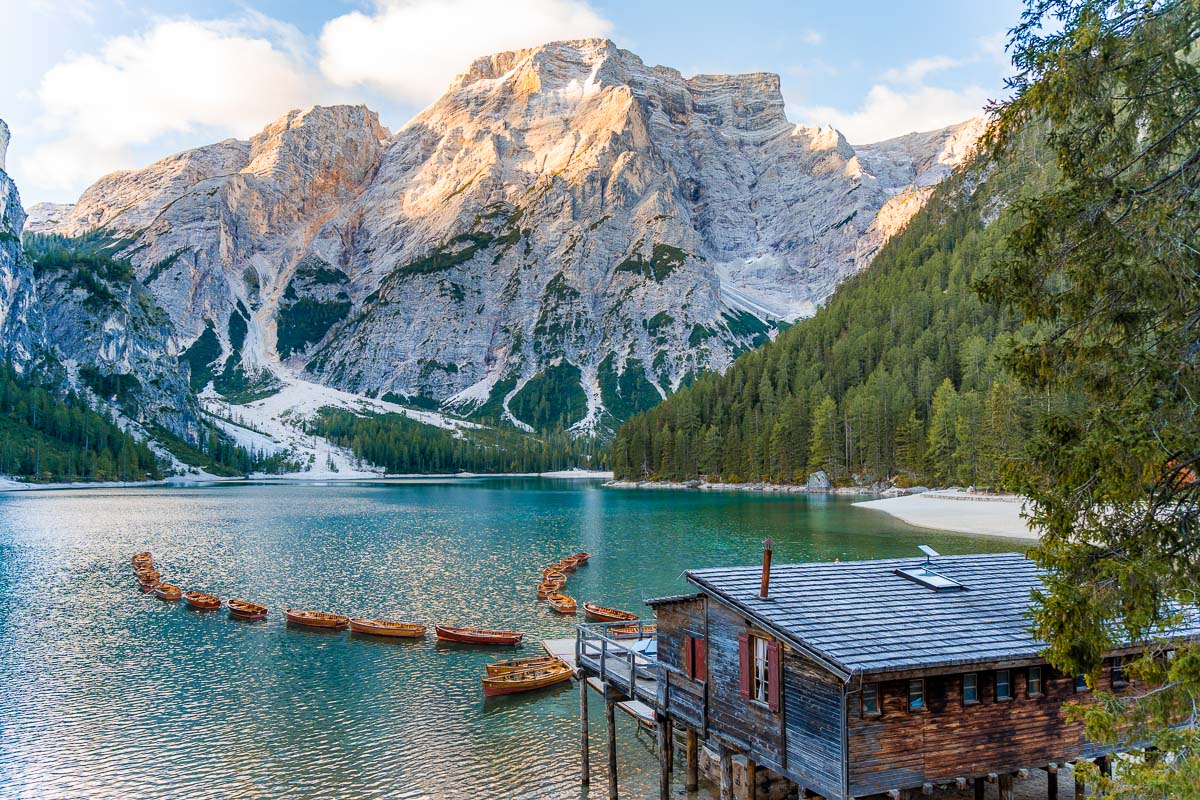
The Italian Dolomites are not only one of the most beautiful places in Italy but they are one of the most stunning mountain destinations in the whole world.
Jagged peaks, breathtaking viewpoints, emerald alpine lakes, fairy tale towns, amazing hikes, and delicious food – you can have it all in the Dolomites!
This 5 day long Dolomites road trip itinerary will be perfect for you if you want to discover all the beauty the Italian Dolomites have to offer in a short period of time.
* Disclosure: This post contains a few affiliate links, which means I may receive a small commission, at no cost to you, if you make a purchase through my link. *
Table of Contents
Overview of Your 5 Day Dolomites Itinerary
Below you can see an overview of your Dolomites itinerary with the highlights that you should visit on each day. For the first two nights, you will stay in Ortisei and you’re going to visit Lago di Carezza, Val di Funes, Alpe di Siusi, and the Seceda ridgeline.
La Villa or Cortina d’Ampezzo will be your base for the second part of your Dolomites road trip, from where you can visit some amazing alpine lakes such as Lago di Braies and Lago di Limides and you can also visit Tre Cime di Lavaredo.
Breakdown of your Dolomites itinerary
- Day 1 : Lago di Carezza, Ortisei
- Day 2 : Val di Funes, Alpe di Siusi
- Day 3 : Seceda ridgeline, Passo Gardena, La Villa or Cortina d’Ampezzo
- Day 4 : Lago di Braies, Lago di Limides, Lago di Valparola
- Day 5 : Tre Cime di Lavaredo, Cadini di Misurina
Map for your Dolomites road trip
Below you can find a customized map that includes all the locations you will need for this Dolomites itinerary. Nearby airports, parking spots, interesting sights, viewpoints, literally everything!
How to use this map: This map is fully interactive, so you can move around, zoom in/zoom out, and click on the icons. If you want to see a larger map, click on the bracket in the upper right corner. To see more details and the different layers, click on the tab in the upper left corner. If you want to save it for later, click on the star icon next to the name of the map. Then simply open Google Maps either on your desktop or phone, go to ‘Saved’/’Maps’, and open the map whenever you need it.
Day 1 of Your Dolomites Road Trip
The first day of your Dolomites road trip itinerary is all about arriving at the Dolomites and settling in your chosen accommodation in Ortisei/St. Ulrich, which is going to be your base for the next few days.
Fun fact: Did you know that there are three official languages spoken in the Dolomites? That’s the reason why you see multiple names for one place!
Usually, every place has a name in Italian and in German (even on the road signs and maps), and sometimes in Ladin. That’s why you will see names like Ortisei/St. Ulrich, Alpe di Siusi/Seiser Alm, Lago di Braies/Pragser Wildsee and so on. But back to the main topic!
If you’re planning to arrive in Italy by plane, it can take you anywhere from 1.5 hours to 4 hours to get to the Dolomites, depending on which airport you arrive at. However, if you’re driving from another European country, such as Germany or Austria, it might take you even longer to arrive at the Dolomites.
For more details about how to get to the Dolomites, please refer back to the beginning of the article!
Since you can arrive early in the morning or late in the afternoon, for the sake of this Dolomites itinerary we’re gonna take the first day easy and you will only have one stop before arriving at your hotel.
Of course, if you have more time, feel free to add some additional stops to the first day of your Dolomites road trip itinerary!
Lago di Carezza
Instead of heading straight to your hotel in Ortisei/St. Ulrich, first make a stop at Lago di Carezza/Karersee!
If you’re coming from either Venice or Bergamo, it’s only an extra 30 minutes (23 km) to get to the lake but if you’re coming from Innsbruck or Munich, you will need to drive an extra hour (45 km) to arrive at Lago di Carezza.
Nestled in the Val d’Ega valley, Lago di Carezza is often referred to as the ‘Rainbow Lake’ thanks to its impressive colors. Legend has it that once upon a time, there was a beautiful mermaid living the lake with whom a wizard deeply fall in love but the mermaid was impossible to win over.
In order to seduce her, with the help of a local witch, the wizard came up with a plan to throw a rainbow from the mountains to the lake and disguise himself as a jewelry salesman.
The wizard indeed stretched a rainbow but he forgot to dress up so the mermaid immediately recognized him and disappeared into the water forever.
The wizard got so angry that he ended up smashing the rainbow into million pieces and throwing it into the lake, where they still continue to shine to this day. Interesting story, right?
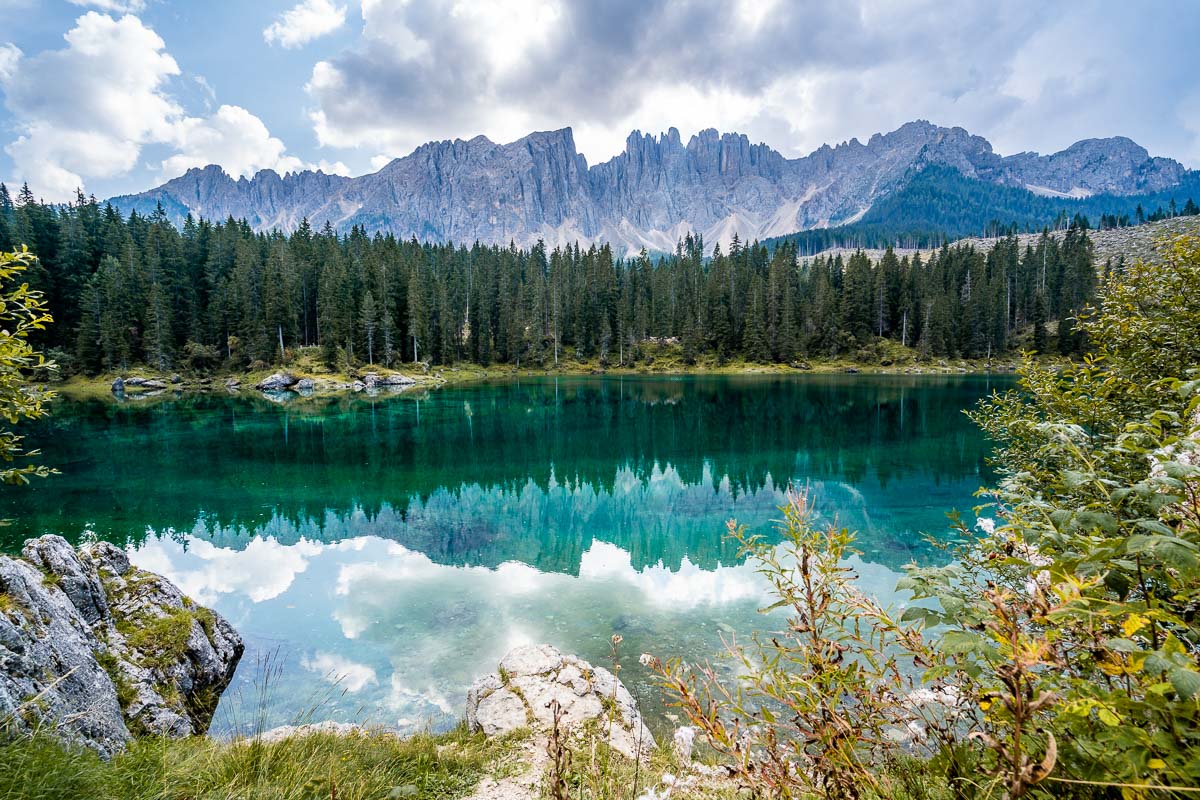
Rainbow colors or not, the emerald green alpine lake is undoubtedly one of the most beautiful lakes in the Dolomites and since it’s easily accessible, it’s a must-stop on everyone’s Dolomites itinerary.
There is a parking lot close to the lake where you can leave the car and then walk a few minutes to get to the lake. Parking is free for the first 15 minutes, then it’s €1 for 1 hour, €2 for 2 hours, and €4 for 6 hours.
There is a wooden viewing platform at the entrance of the lake where you can also learn more about the history of the lake, such as the destructive storm that struck in 2018, destroying more than 5,000 hectares of forest just in the South Tyrol region alone.
After that you can walk along the loop trail that goes around the lake, it takes around 20-25 minutes to complete it.
Although it’s undoubtedly one of the best photography spots in the Dolomites, it’s important to know that the whole lake is fenced off and it’s not possible to get close to the water.
That being said, I still keep seeing many photos on Instagram where people are standing or sitting on a rock, right by the lake.
Please be respectful and don’t break the rules just for the sake of a photo, you can take amazing photos by staying out of the fenced area as well!
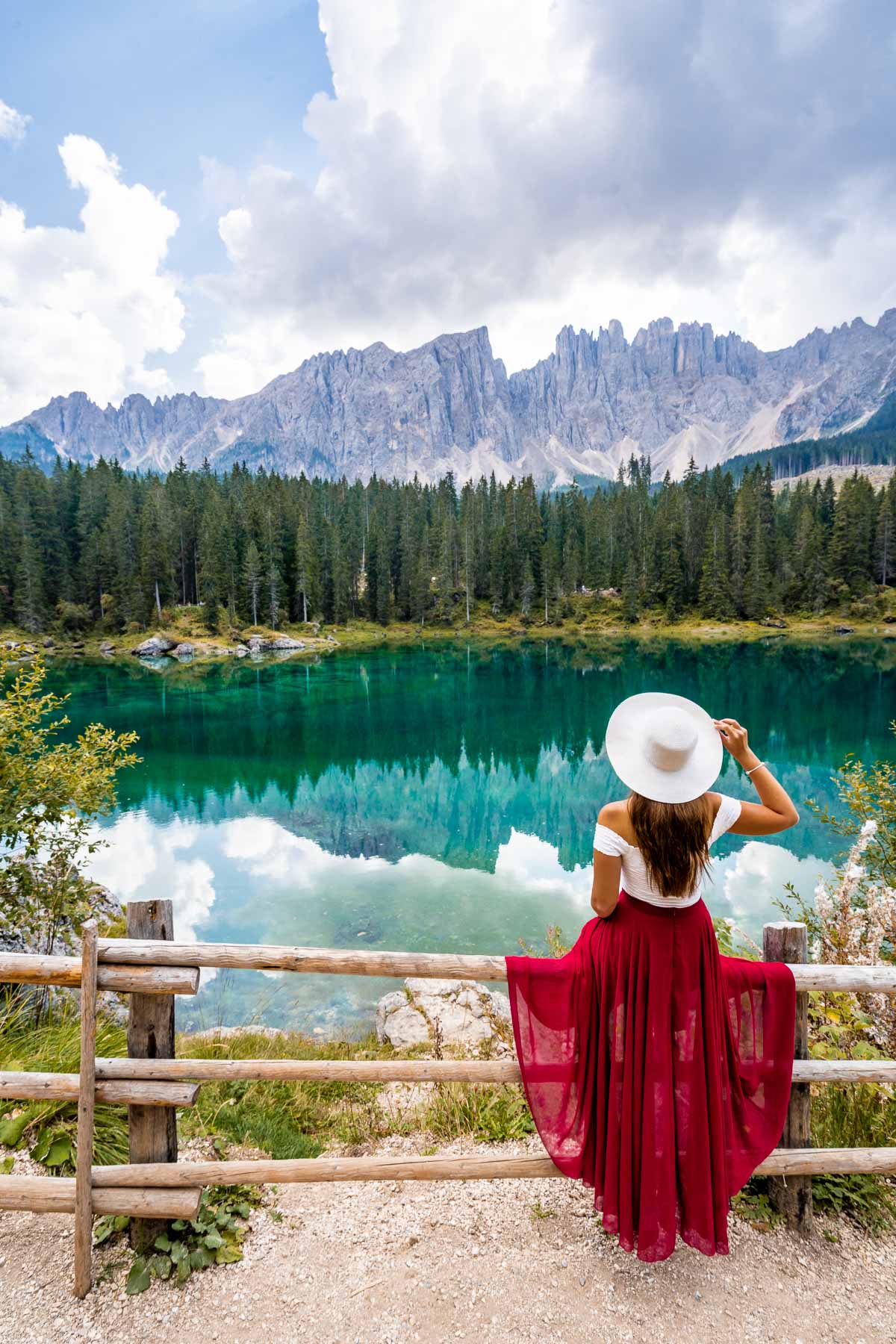
Arriving to Ortisei
After visiting Lago di Carezza and taking a million photos of the beautiful scenery, it’s time to head to Ortisei/St. Ulrich that will be your base for the following days. From Lago di Carezza, it takes around 1 hour (55 km) to reach Ortisei at a normal pace.
Located right in the center of Dolomites Val Gardena, the charming little town of Ortisei is mostly famous for its hand-made wooden sculptures. The local woodcarver families kept the tradition alive to this very day!
Ortisei is one of the best places to stay in the Dolomites and hence very popular among travelers, thanks to being super close to the Seceda ridgeline and Alpe di Siusi/Seiser Alm. More about them later!
If you have some more time on the first day of your Dolomites road trip, it’s worth taking a stroll in the town and seeing the traditional hotels and gorgeous residential buildings.
A must-visit place is the pedestrian area between the chapel of Saint Ulrich and the Antonius Church which is often described as the most beautiful shopping street in the Dolomites.
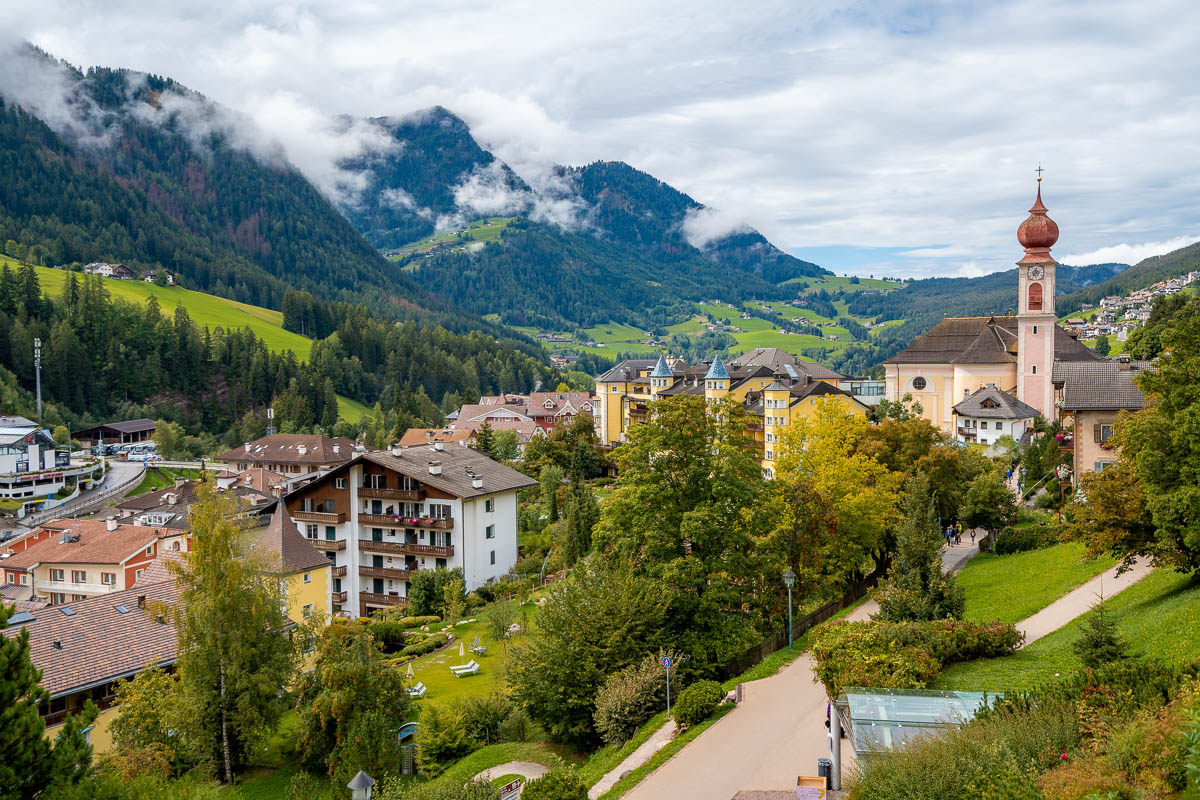
In order to follow this Dolomites road trip itinerary, I recommend spending your first 2 nights in Ortisei. We personally stayed at Hotel Angelo Engel which is a 4-star family-run hotel with a large private garden, an indoor and outdoor pool, and an excellent SPA & beauty farm (pictured below).
We had an amazing time there and I can totally recommend this hotel for anyone! You can check the prices and availability here.
If you’re looking for something else or there is no availability at the hotel on your preferred dates, you can find some more recommendations below.
- Luxury: Adler Spa Resort Dolomiti | Alpin Garden Luxury Maison
- Mid-range: Hotel Pinei | Apartments Villa Venezia Luxury
- Budget: Villa Moroder | Sule Hof Agriturismo
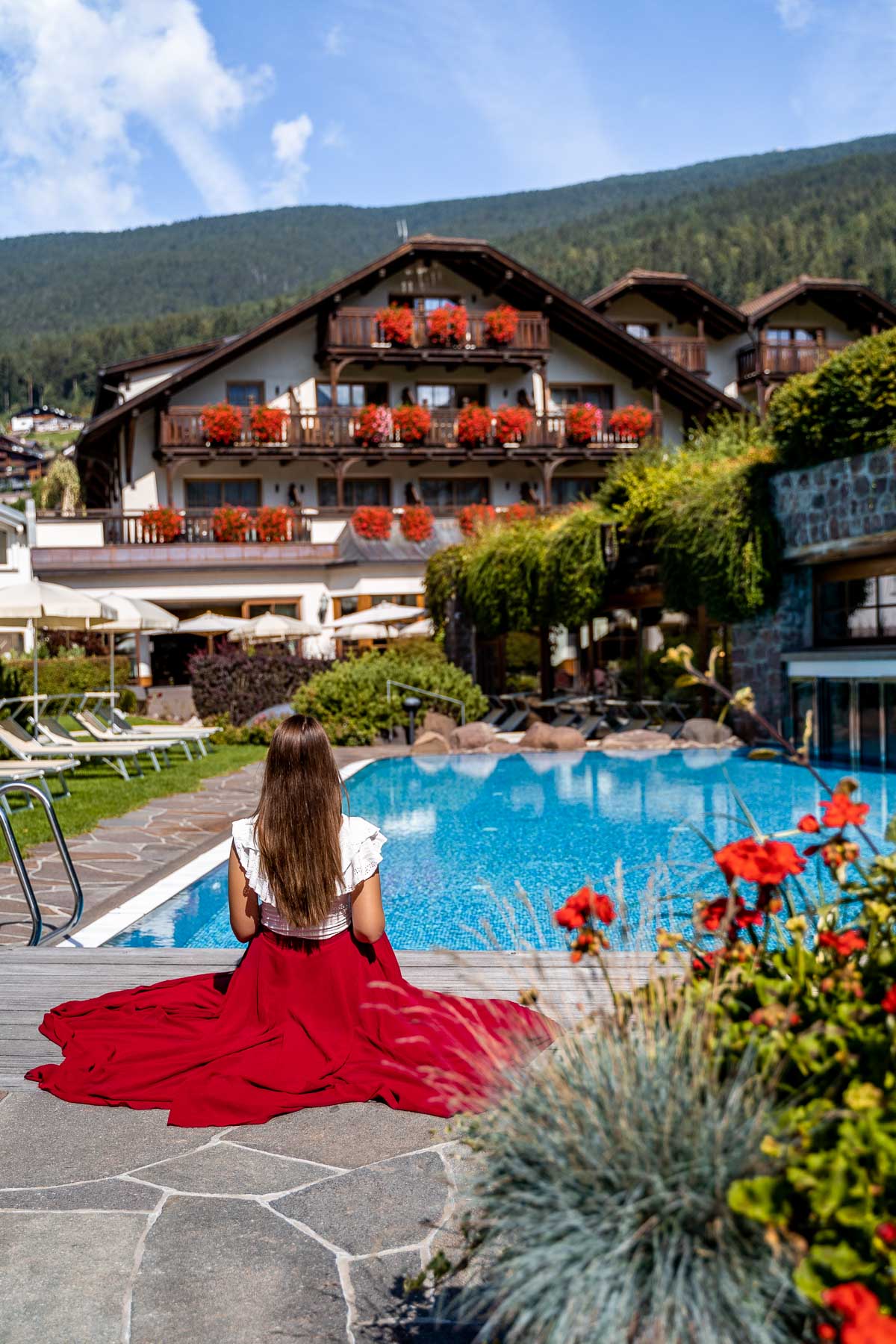
Day 2 of Your Dolomites Road Trip
Santa maddalena church.
On the second day of your Dolomites road trip head over to Val di Funes in the morning where you can visit two of the most beautiful churches in the Dolomites.
It takes around 45 minutes (35 km) to reach the town of Santa Maddalena from Ortisei and the first church of your day will be the Santa Maddalena church.
This picturesque little church with the Odle mountains in the background is the symbol of Val di Funes and it’s one of the most photographed places in the entire Dolomites.
It’s important to know that you can’t drive up to the church so you need to park your car in the center of the town. There are multiple parking spots in the city, I marked them on the map I shared at the beginning of the article so please refer back for the exact locations!
In order to get to the famous viewpoint, you need to hike for around 20 minutes but it’s a very easy hike, basically, you just need to walk up to the hill across the church.
Search for ‘ Panchina Panoramica ‘ on Google Maps and I’m sure you will find it easily! After that you can visit the church inside if you want, it’s open daily and it features a beautiful Baroque style altar and interesting wall paintings.
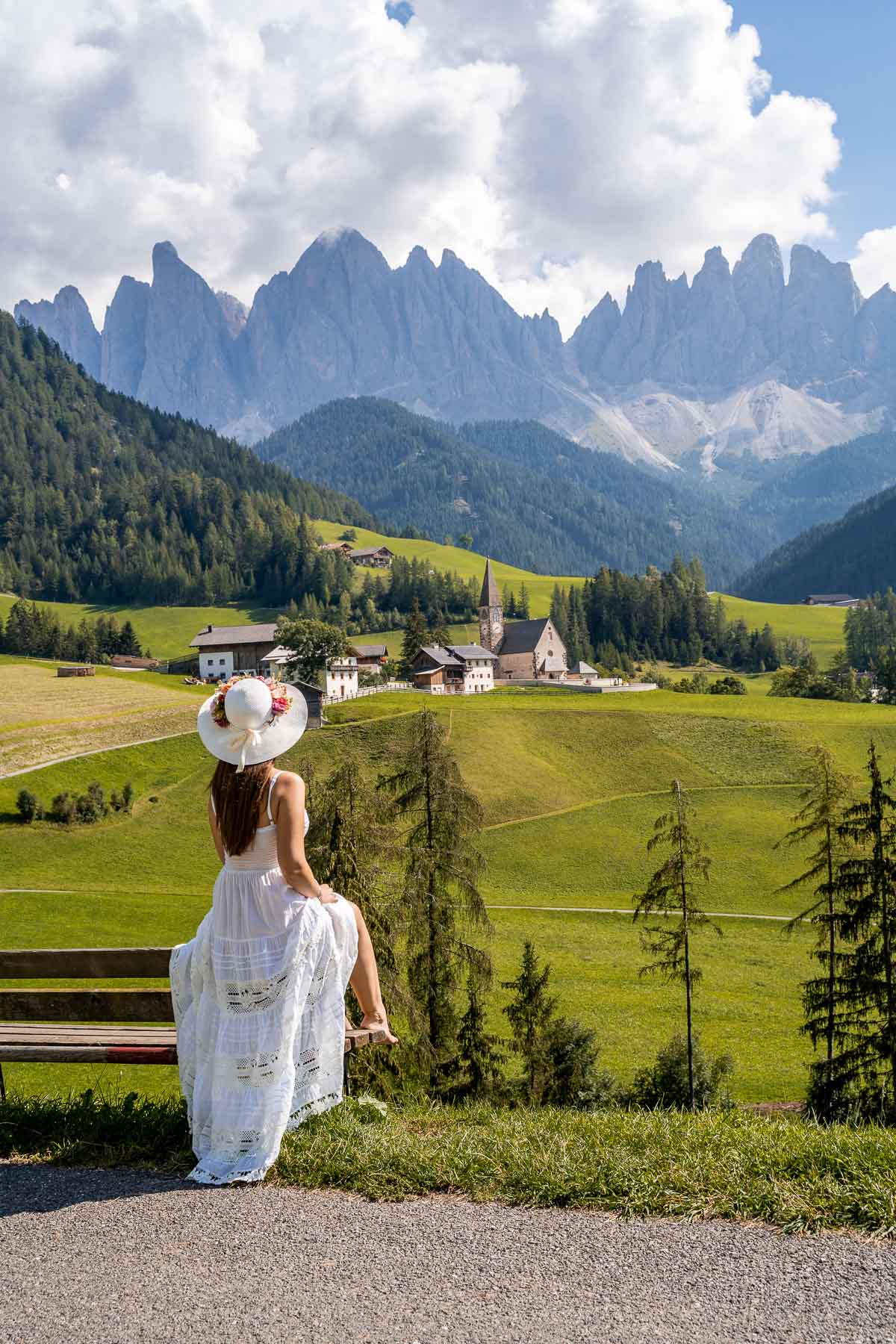
Church of St. John in Ranui
The second church of the day is the church of St. John in Ranui, which is another small little Baroque church with an insanely beautiful background.
It takes around 30 minutes to reach it from Santa Maddalena on foot, but if you’re feeling lazy you can go back to your car first and park in a closer parking spot from where you only need to walk 5-10 minutes to get to the church.
There is a built wooden viewing platform close to the parking lot and it’s an amazing place to take photos of the church with the mountains in the background.
The church itself can be also visited for €4 per person and it can be booked for small events and weddings as well.
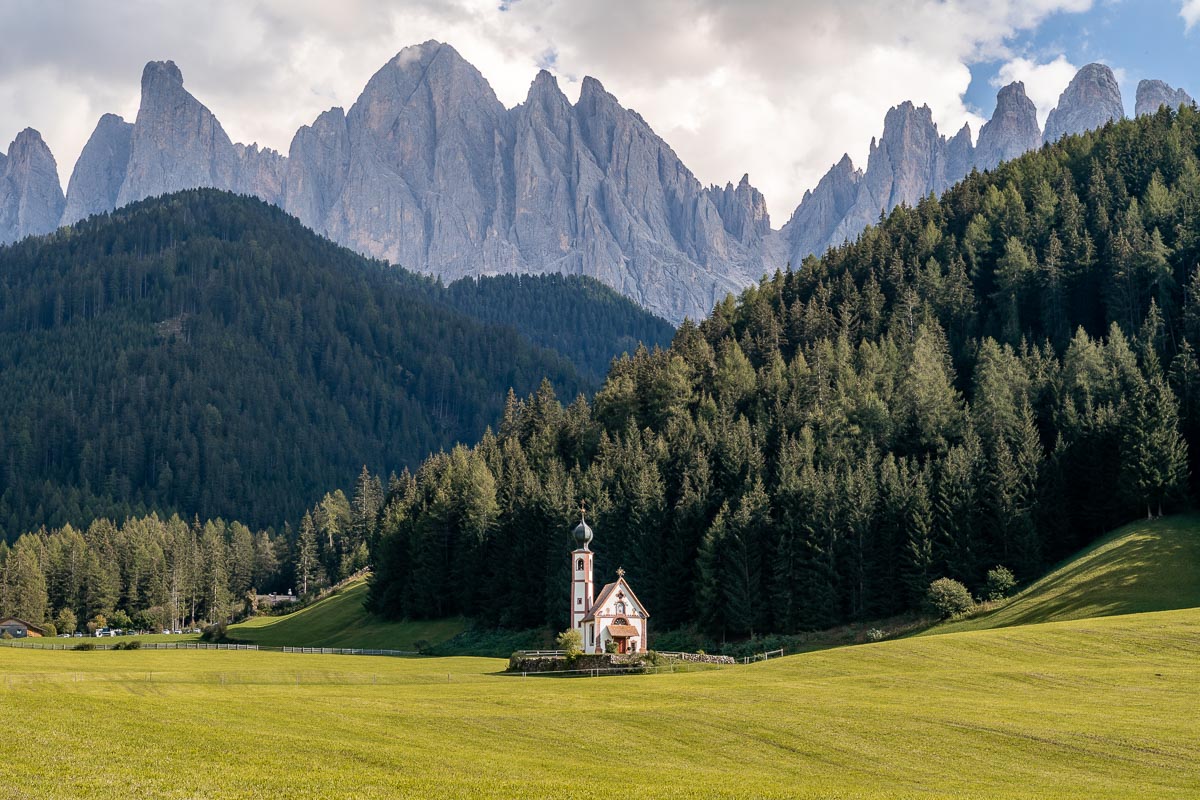
Sunset at Alpe di Siusi
After visiting the two churches in Val di Funes it’s time to head over to probably the most famous place in the Dolomites: Alpe di Siusi/Seiser Alm!
It’s important to know that driving there is strictly prohibited and if you don’t want to get fined hundreds of euros, you need to follow the rules.
Alpe di Siusi is the largest mountain plateau in Europe and it grants amazing views over the peaks of Sasso Lungo, Sasso Piatto, and Sciliar. It’s a must-visit on every Dolomites road trip itinerary!
You have basically three options for getting there. You can book a hotel for the night, in this case, you are allowed to drive up in your car but only until you reach your hotel (no further) and you can only do it once on the day you arrive.
There are only a handful of hotels at Alpe di Siusi, these two are the closest ones to the famous viewpoint (pictured below): Hotel Icaro***S and Sporthotel Sonne .
From Ortisei you can take a cable car to get up to Alpe di Siusi, a one-way ticket costs €16.90 while a round-trip ticket costs €24.90.
The cable car runs from 8.30 am usually till 6 pm which is great if you want to visit during the day, but unfortunately, it’s not good for sunrise or sunset visits. The opening hours vary depending on the season, you can check the exact timetable on their official website .
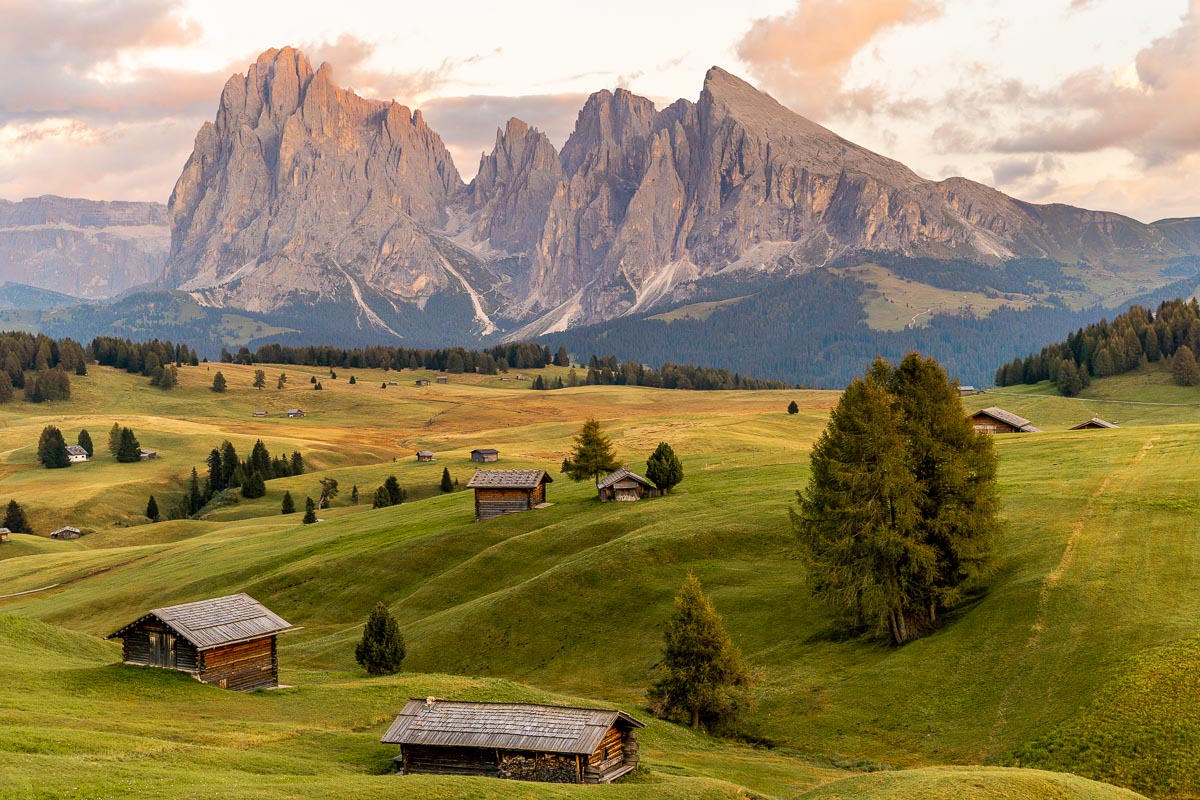
If you want to visit for sunrise or sunset, the best thing you can do is to drive up to Compatsch and leave your car at the P2 parking lot (I marked it on the map that you can find at the beginning of the article).
You can’t drive up on the road between 9 am and 5 pm without getting a big fat check but if you go earlier or later it’s going to be fine.
After you left the car in the parking lot, you need to hike for around 1 hour to get to the famous viewpoint (pictured above).
I marked the coordinates on the map at the beginning of the article but if you search for ‘ Belvedere dell’ Alpe di Siusi ‘ on Google Maps you will also find it. The hike is super easy, it’s mostly flat and the views along the way are simply breathtaking.
If you have a little extra time before sunset, before reaching the viewpoint turn right and hike down to the ‘ Malga Sanon ‘ restaurant.
You will find a tiny playground in front of the restaurant with a swing, it’s so much fun to take photos there, not to mention the insanely gorgeous background!
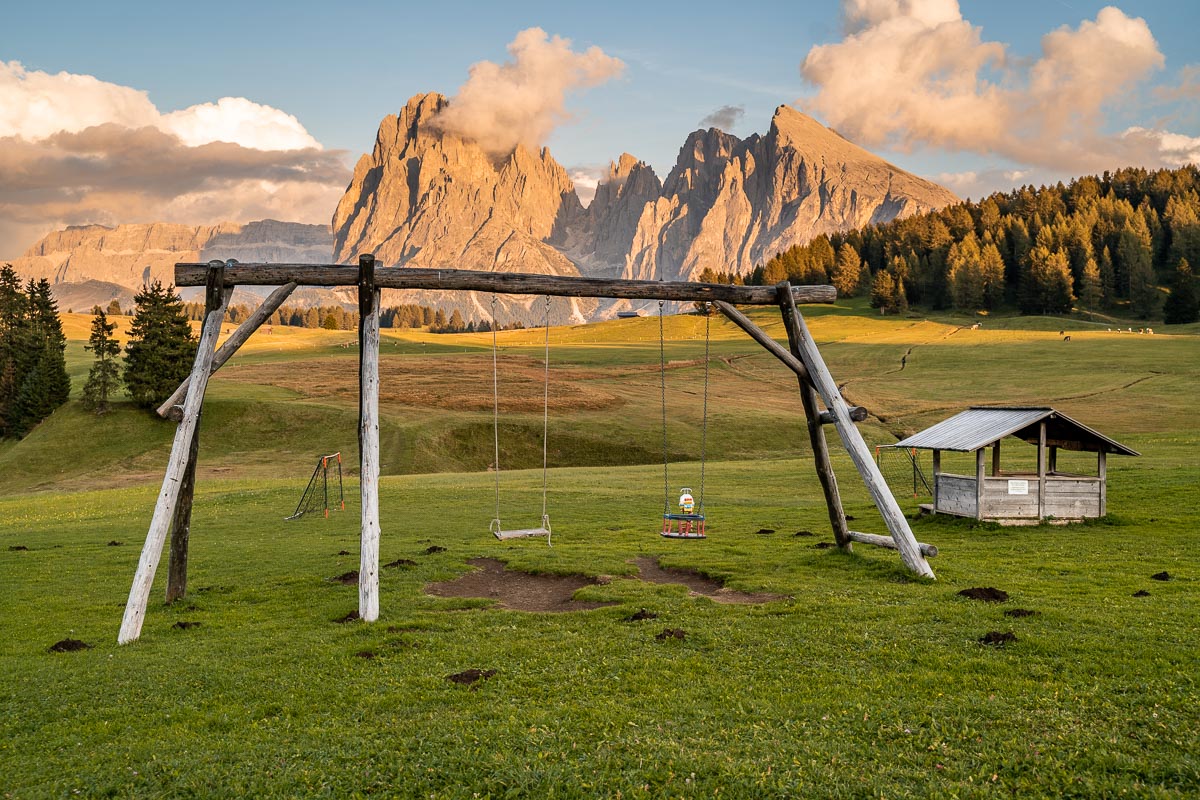
Day 3 of Your Dolomites Road Trip
Since this is already the third day of your Dolomites road trip itinerary, you will need to check out from your hotel in Ortisei and move to another one either in La Villa or Cortina d’Ampezzo (more about this later).
But before that, it’s time to go up to the Seceda ridgeline and do a little hiking there!
Since the cable cars run from Ortisei, it’s best to check out from your hotel in the morning, leave your luggage in the car and go up to Seceda. After you’re done with the hike, you will still have time to drive to your other hotel and check out Passo Gardena on the way.
Hiking at Seceda
As I mentioned, the cable cars going up to Seceda run from Ortisei. In case you can’t leave your car at the parking of the hotel after you’ve checked out, there is a big parking lot at the cable car station as well.
A round-trip ticket for the cable car costs €39,50 per person and it operates between 8.30 am and 5.30 pm.
Located in the Puez Odle Nature Park, Seceda has one of the most dramatic ridgelines in the Dolomites with jagged peaks and huge drop-offs.
Once you’re up there, there are countless hiking trails and it only depends on your preference which one you take. If you have time, you can even hike all the way down to Ortisei as well!
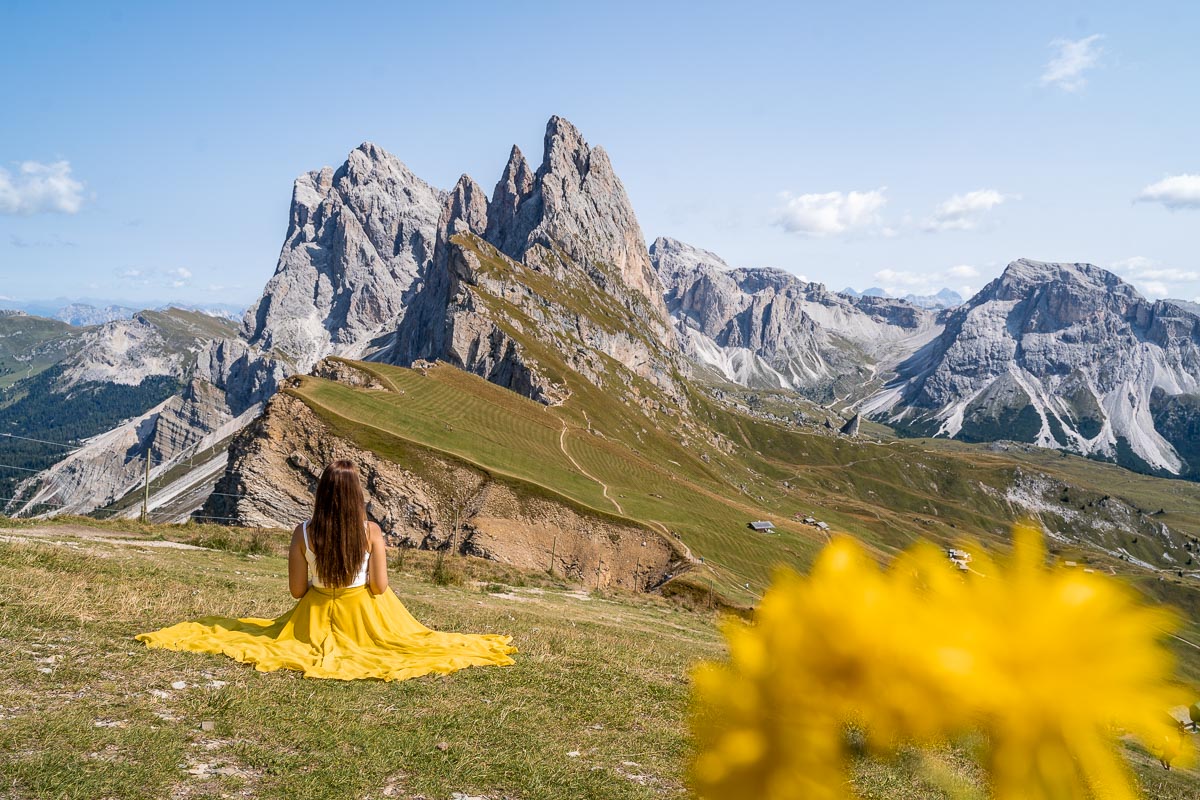
Whichever you choose, walking along the ridgeline is a must when visiting Seceda. After you’ve arrived with the cable car, turn left and start walking uphill! There is even a sign on the road pointing to the viewpoint, you simply can’t miss it.
If you’re not much of a hiker, you can go back to the cable car station after you soaked in all the views, but if you’re up for a little exercise, you can hike down to the meadow to Baita Troier Hütte (they have amazing apple pies!).
From there you can either continue your hike to Pieralongia (twin spires – they kinda look like the rocks from Lion King) and then Rifugio Firenze, or you can just go back to the cable car station. Totally up to you!
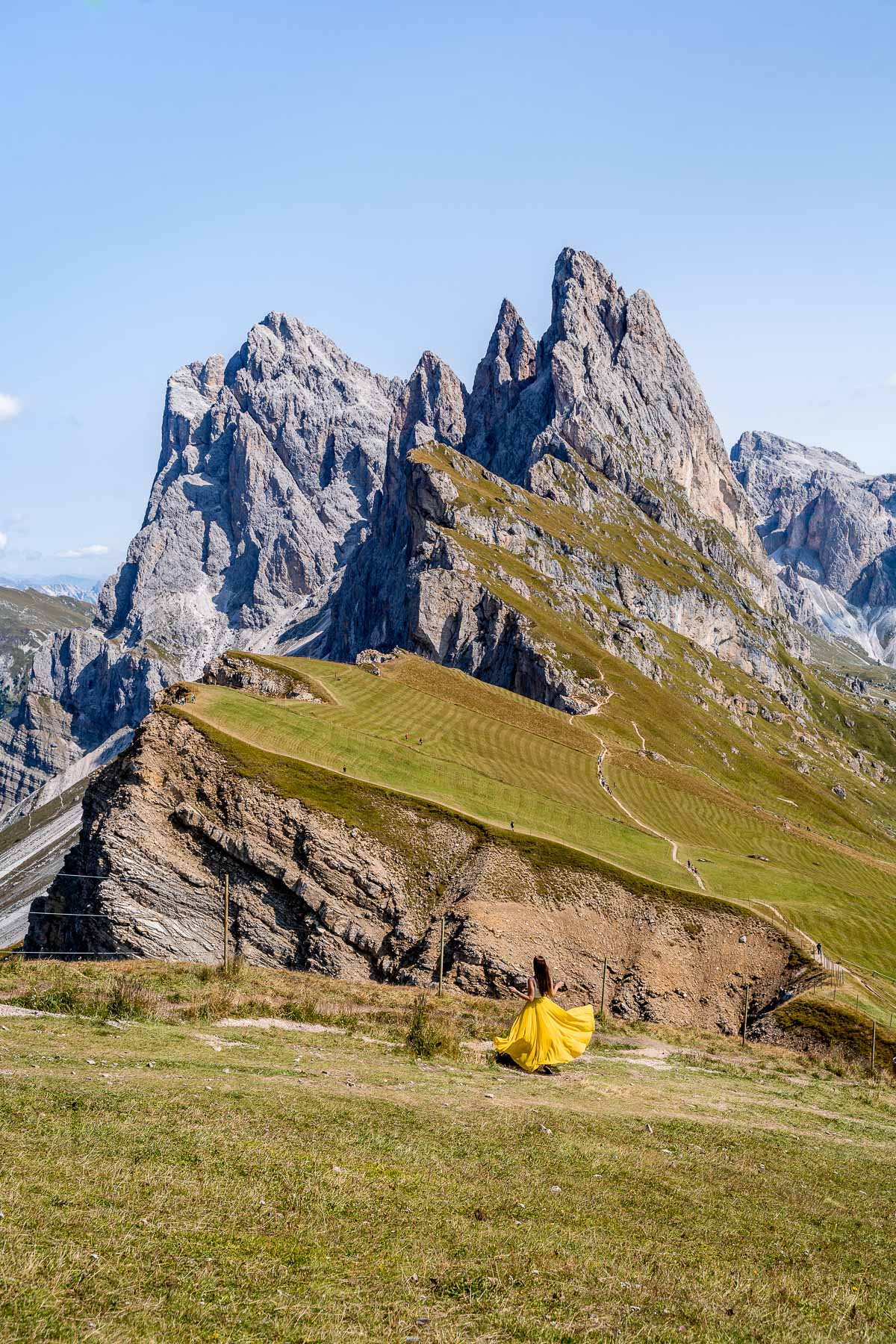
Passo Gardena
Passo Gardena (Gardena Pass) is a super scenic mountain pass connecting Val Gardena with Val Badia.
Since you’re going to drive in the direction of La Villa/Cortina d’Ampezzo from Ortisei, you will drive through it anyway and since you’re already there, it’s worth stopping for a few minutes to soak in the views.
There is a small hütte called Rifugio Frara where you can park your car and from there you can walk up to the viewpoint (it only takes a few minutes to reach it).
Actually, this is a start of an 11.5 km long like but since it’s a very difficult hike, I wouldn’t recommend it to first-timers (we didn’t do it either).
It’s worth scheduling your arrival to Passo Gardena half an hour before sunset, this way you will be able to see the scenery during golden hour, which is super beautiful!
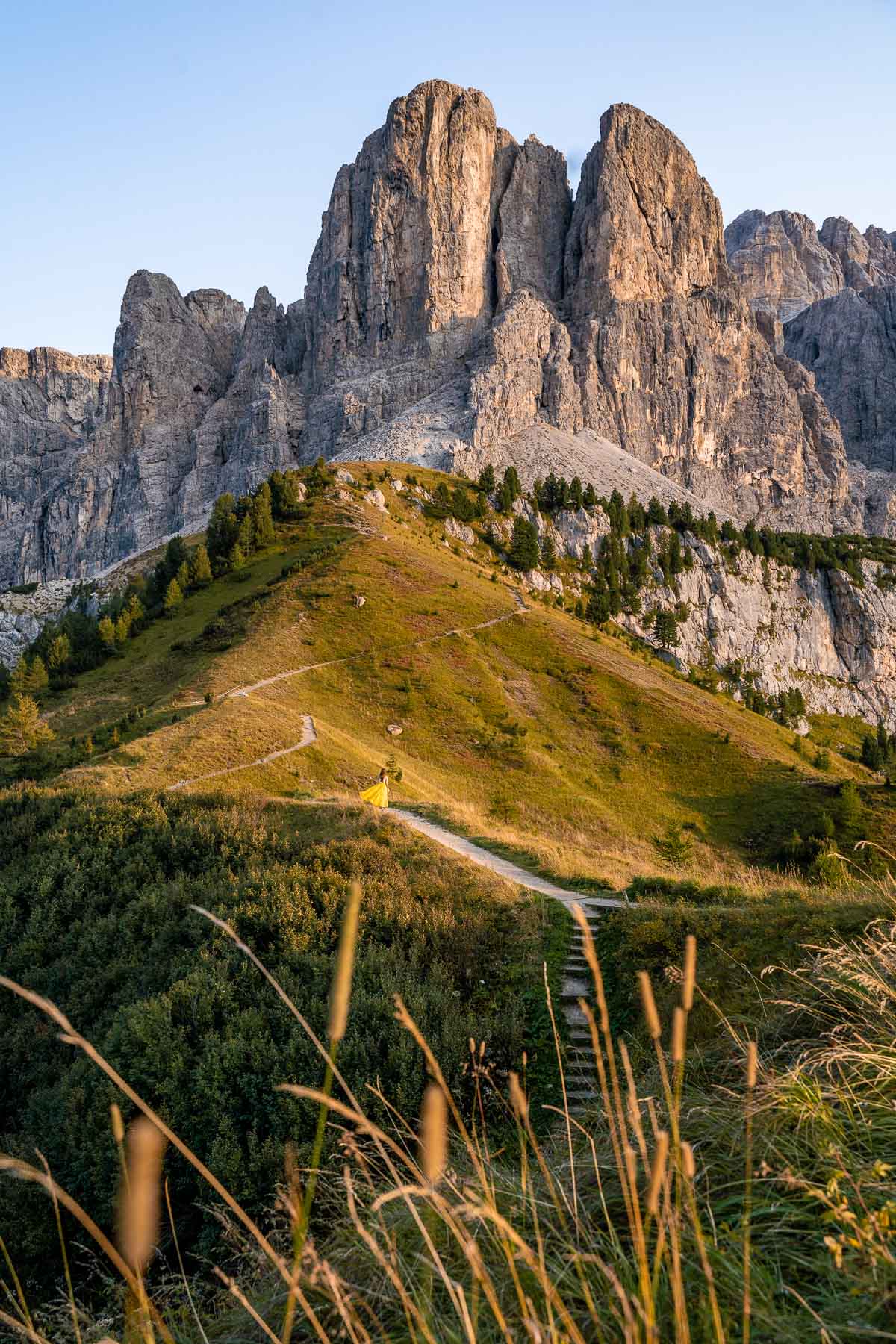
Arriving to La Villa or Cortina d’Ampezzo
For the second half of your Dolomites road trip itinerary, I recommend staying at another hotel either in La Villa, Cortina d’Ampezzo, or one of the nearby towns.
The simple reason is that the places you’re going to visit on the rest of your Dolomites trip are too far away from Ortisei and it doesn’t make sense to stay there and drive countless hours to reach these sights.
Although Cortina d’Ampezzo is the most popular choice among travelers, we decided to stay at Hotel La Majun in La Villa/Stern and absolutely loved the hotel!
It’s a 4-star family-operated hotel and what makes it even more special is that the owners actually live in the hotel and their mission is to make you feel at home too.
The hospitality was exceptional and the panoramic view from the hotel is simply breathtaking (pictured below). You can check the prices and availability here .
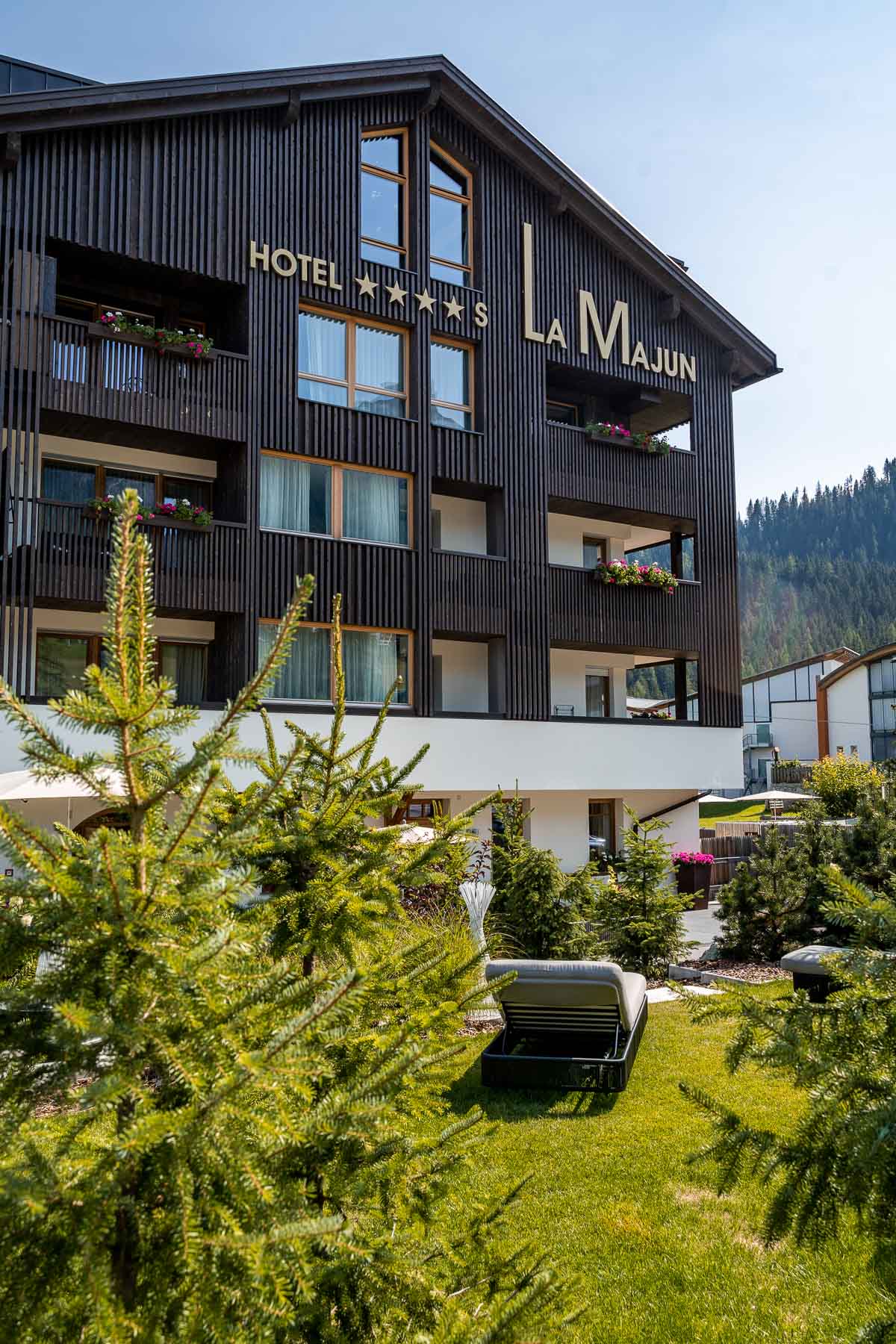
If you’re looking for something else or there is no availability at the hotel on your preferred dates, you can find some more recommendations below, both for La Villa and Cortina d’Ampezzo.
BEST PLACES TO STAY IN LA VILLA
- Luxury: Hotel Cristallo – Wellness Mountain Living | Dolomites Wellness Hotel Savoy
- Mid-range: Boutique Hotel Dolomit | Hotel Des Alpes
- Budget: Casa Nives | Garni La Ciasota
BEST PLACES TO STAY IN CORTINA D’AMPEZZO
- Luxury: Rosapetra SPA Resort | Dolomiti Lodge Alverà
- Mid-range: Boutique Hotel Villa Blu Cortina | Hotel Villa Alpina ***S
- Budget: Hotel Meuble Oasi | Ciasa Nonna Bon Bon
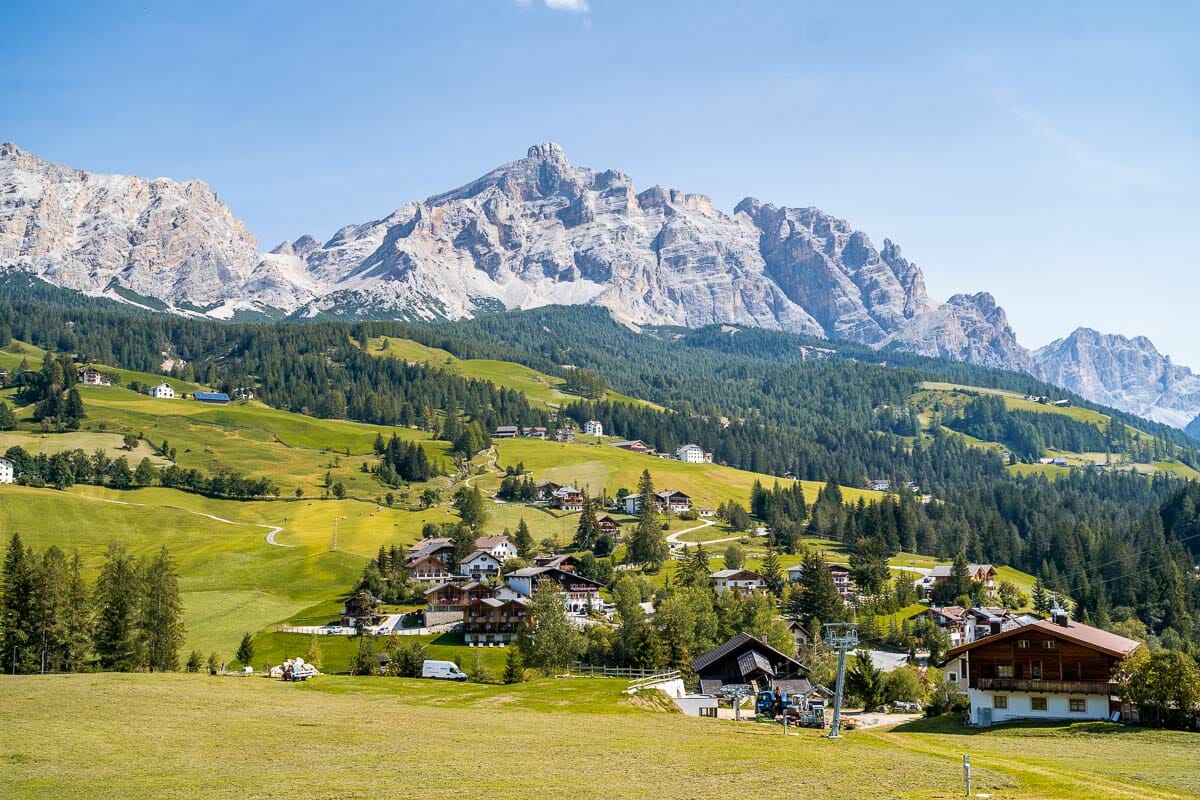
Day 4 of Your Dolomites Road Trip
Lago di braies.
Start the fourth day of your Dolomites road trip itinerary by visiting the most famous lake in the Dolomites: Lago di Braies/Pragser Wildsee. It’s a very picturesque alpine-like with turquoise-green colored waters and a beautiful mountain panorama.
It’s the perfect place for nature lovers and hikers but unfortunately due to its fame it usually gets insanely crowded during the day so try to plan an early morning visit to be able to enjoy the lake by yourself.
It takes around 1 hour 10 minutes (60 km) to get to Lago di Braies from La Villa, while it’s only 50 minutes (46 km) from Cortina d’Ampezzo.
There are 3 different parking lots close to the lake and although they are big, they can fill up really quickly (especially the closest one) so I can’t stress enough how important it is to get to the lake early.
Chances are that around 9-10 am you will not be able to find a free parking spot at all!
The best things to do at Lago di Braies include renting a rowboat from the boathouse and slowly paddling across the turquoise water and then walking around the lake which takes around 1-2 hours (the distance is 4 km).
The boathouse is open between 8 am – 7 pm pm in July and August, while it’s only open from 9 am to 5 pm between the end of May and the end of June. It opens at 10 am from the beginning of September until the beginning of November. A boat rental costs €25 for 30 minutes and €35 for 60 minutes, reservation in advance is not possible.
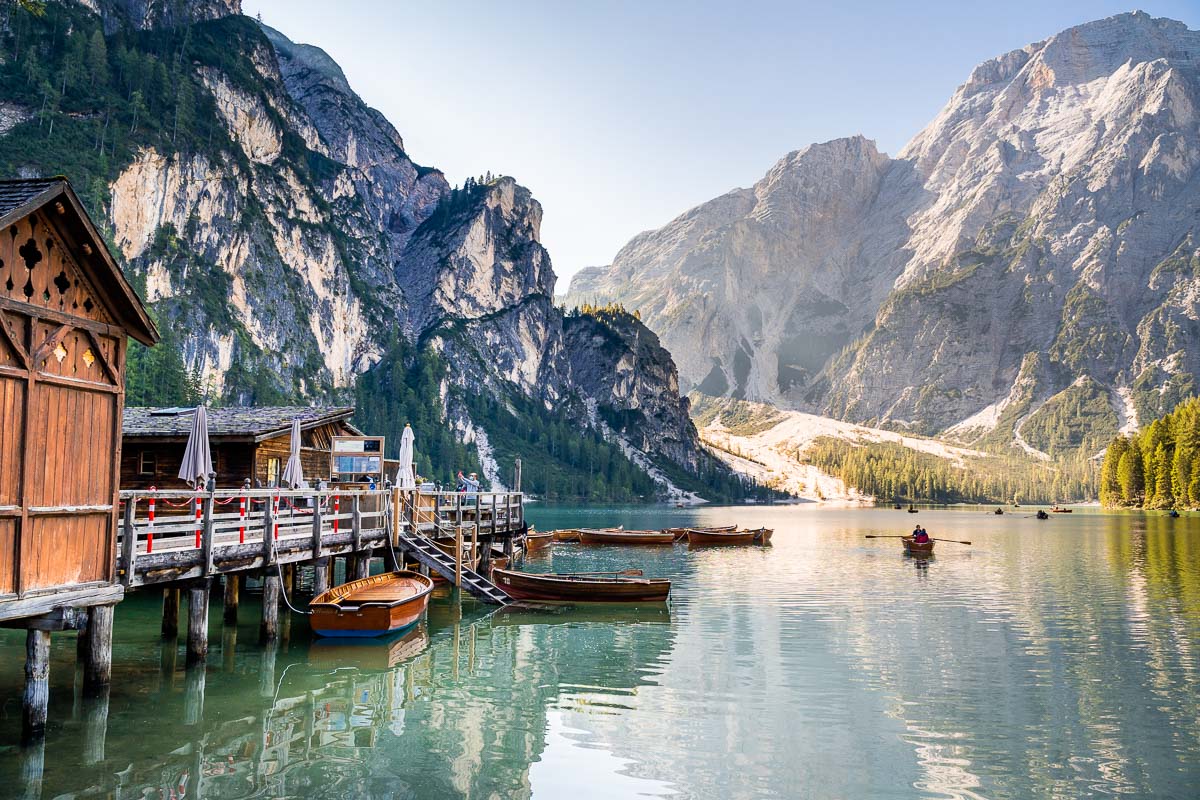
What you need to know about photography at the lake
I’m sure you’ve already seen many photos on Instagram, mostly where people are standing on a little pier, surrounded by wooden boats and a stunning reflection on the lake.
What most people don’t disclose is that the pier belongs to a private boathouse and you can’t access it unless you rent the pier for a photoshoot or rent a boat from the boathouse when they are open.
The boat rental only starts later in the day so even if you rent a boat, you will not be able to shoot a picture with reflections and a calm lake. Not to mention that people will be already lining up behind you and you will not have the time to take many photos.
So if you desperately want to have a similar picture (you can see an example here ), your only option is to rent the pier for a morning photo shoot. It costs €150 for one hour, you can find more information about the rental here .
That being said, I’ve heard stories that many people choose to trespass early in the morning when the boathouse is still closed. But in order to do that, you need to wade through the ice-cold water and then climb onto one of the boats, and then jump from boat to boat until you reach the pier.
Yes, I know, this sounds super crazy and it’s clearly not an example to be followed (please don’t do stupid and illegal stuff like this for a photo).
If you don’t want to rent the pier, you can still get a photo of it if you rent a boat. It won’t be so perfect like the photos you see on Instagram but it’s still beautiful! And this way you can shoot some pictures in the boat as well (see my pictures below).
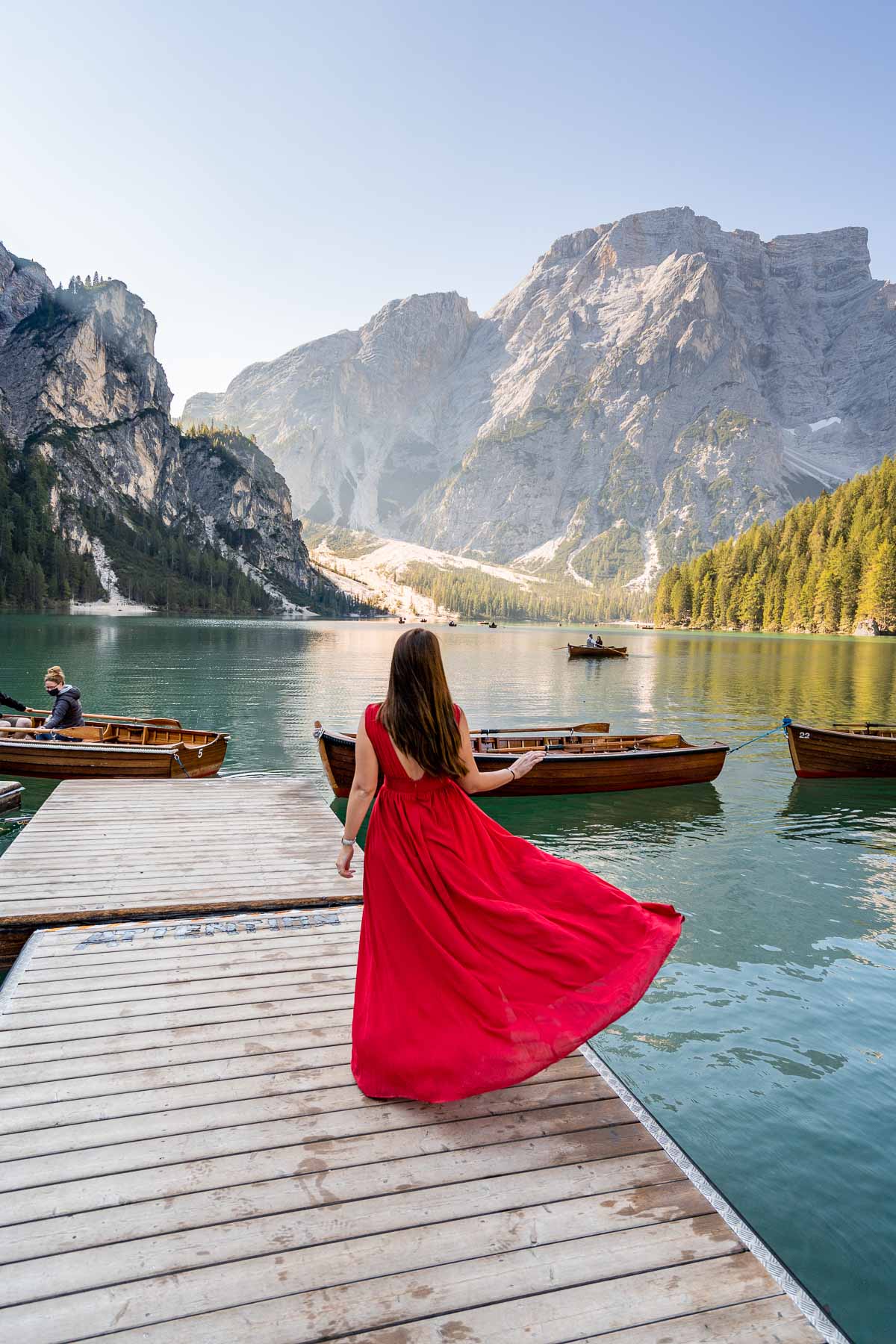
Lago di Limides
In the afternoon head over to Lago di Limides, which is one of the best hidden gems in the Dolomites. It’s a super picturesque little lake with insane panoramic views and reflections of the surrounding mountains (Mount Lagazuoi and Tofana di Rozes).
I still don’t understand why is it so overlooked by visitors but it just adds to its charm and you can basically have the lake all to yourself in the middle of the day!
In order to reach Lago di Limides, you need to drive to Rifugio Col Gallina and leave your car in the parking lot across the street.
It takes around 1 hour 15 minutes (62 km) to get there from Lago di Braies and the road goes through Cortina d’Ampezzo so if you’re not staying there and want to check out the town, you can include a short stop there.
After you park your car, you need to hike for around 25-30 minutes to reach the lake. Don’t worry, it’s a fairly easy hike (the distance is around 2 km) but the trails are not the best and you basically need to hike uphill almost all the way so wear proper shoes!
It can get slippery and muddy after rain so it’s best to visit when the weather is dry and it hasn’t rained in the last couple of days.
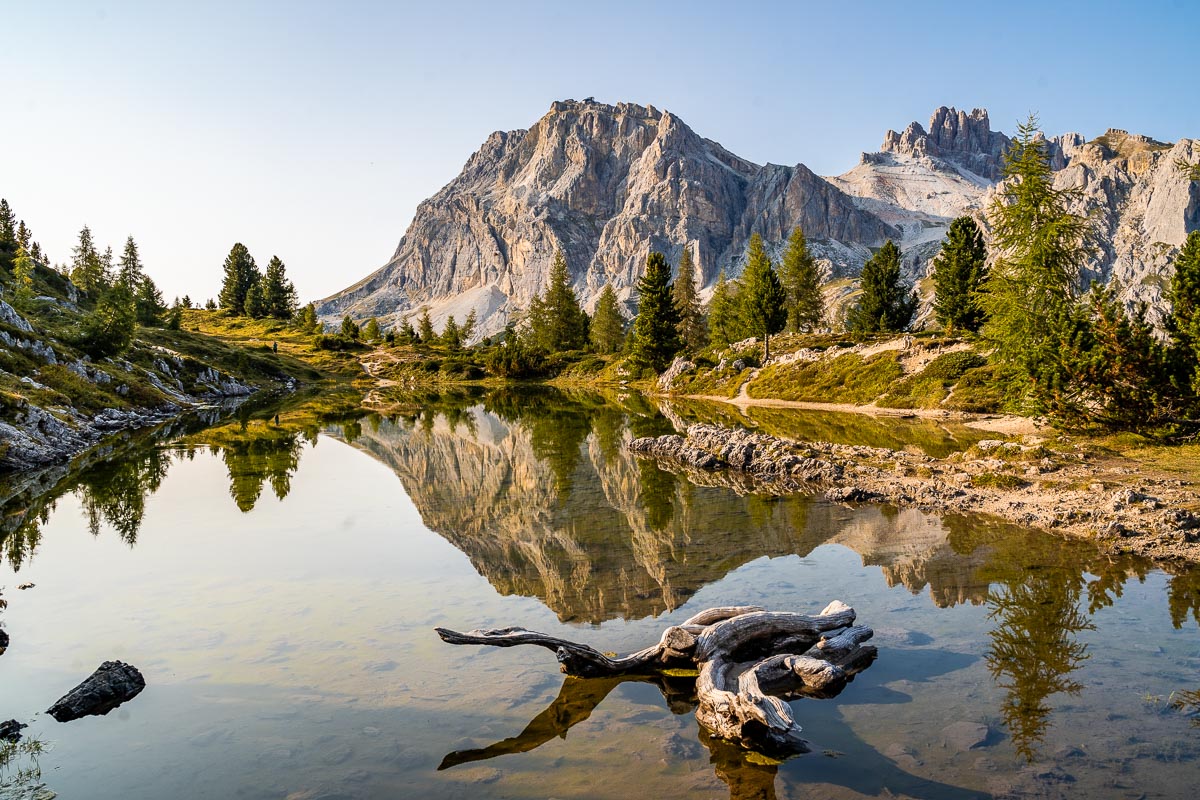
Lago di Valparola
The last stop of the day will be Lago di Valparola, which is a tiny alpine lake located on the top of Passo Valparola (Valparola Pass), not so far away from Rifugio Col Gallina (where you parked the car before going to Lago di Limides).
It’s like a 5-minute drive (3 km) in the direction of La Villa so if you’re staying there, you’re going to drive by it anyway.
There are parking lots on both ends of the lake where you can leave your car to check out the lake and the surrounding panorama.
The lake is visible from the main road but it’s also easily accessible from the road, it takes around 5 minutes to reach it by taking path nr. 24 that goes down to the lake.
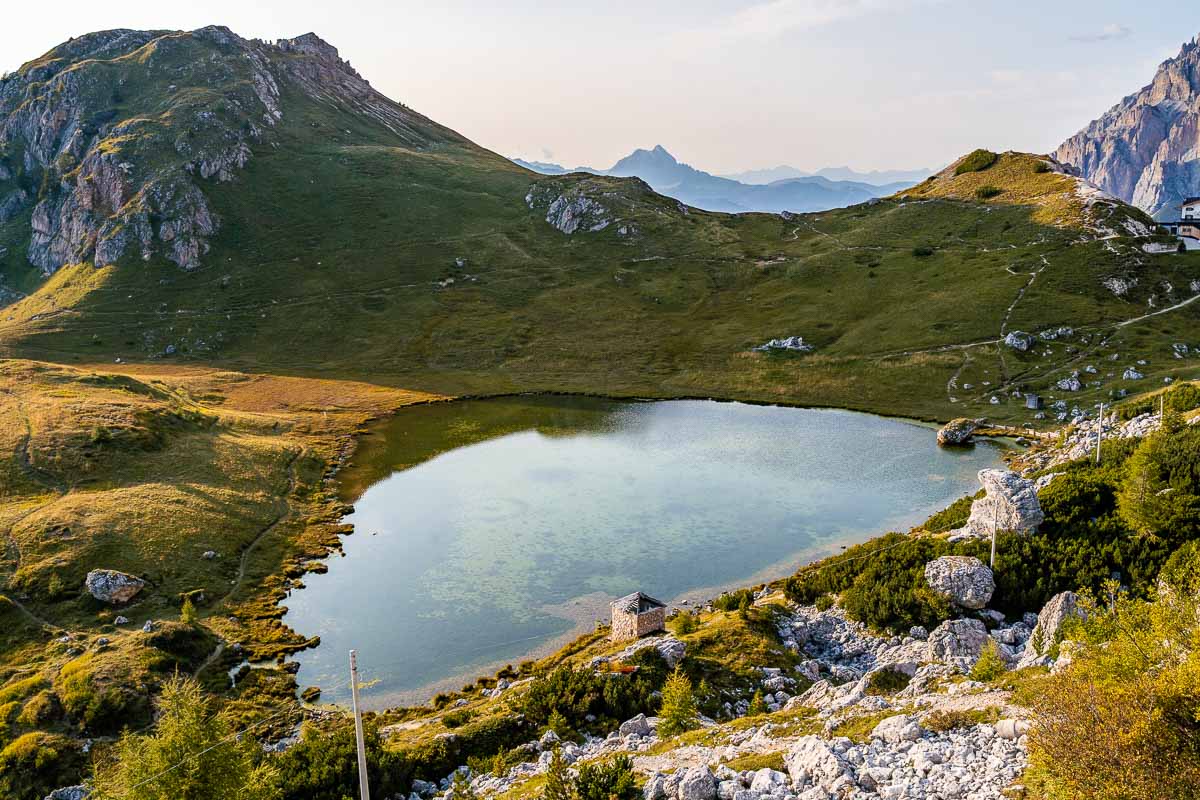
Day 5 of Your Dolomites Road Trip
Hiking around tre cime di lavaredo.
The Tre Cime de Lavaredo loop hike is one of the best hikes in the Dolomites and no Dolomites itinerary is really complete without seeing the iconic three peaks.
The entire loop is around 10 km (6.5 miles) and since it’s a fairly easy hike, it’s accessible to almost everyone.
Usually, it takes around 3-4 hours to complete the loop, we personally did it in 3.5 hours with a few photo stops (half an hour break at Dreizinnenhütte is not included).
The hike starts and finishes at Rifugio Auronzo, where you can find multiple parking lots (you can even spend the night there in a camper). Unfortunately, there is only one road leading up to Rifugio Auronzo and since it’s a private road, you need to pay €30 to use it with a normal car.
Try to go early in the morning because later on when the parking lot is full they can close the road and you will have no other option to get up there (apart from a quite strenuous hike).
It takes around 1.5 hours (55 km/35 miles) to get to Rifugio Auronzo from La Villa and 40 minutes (22 km/14 miles) from Cortina d’Ampezzo.
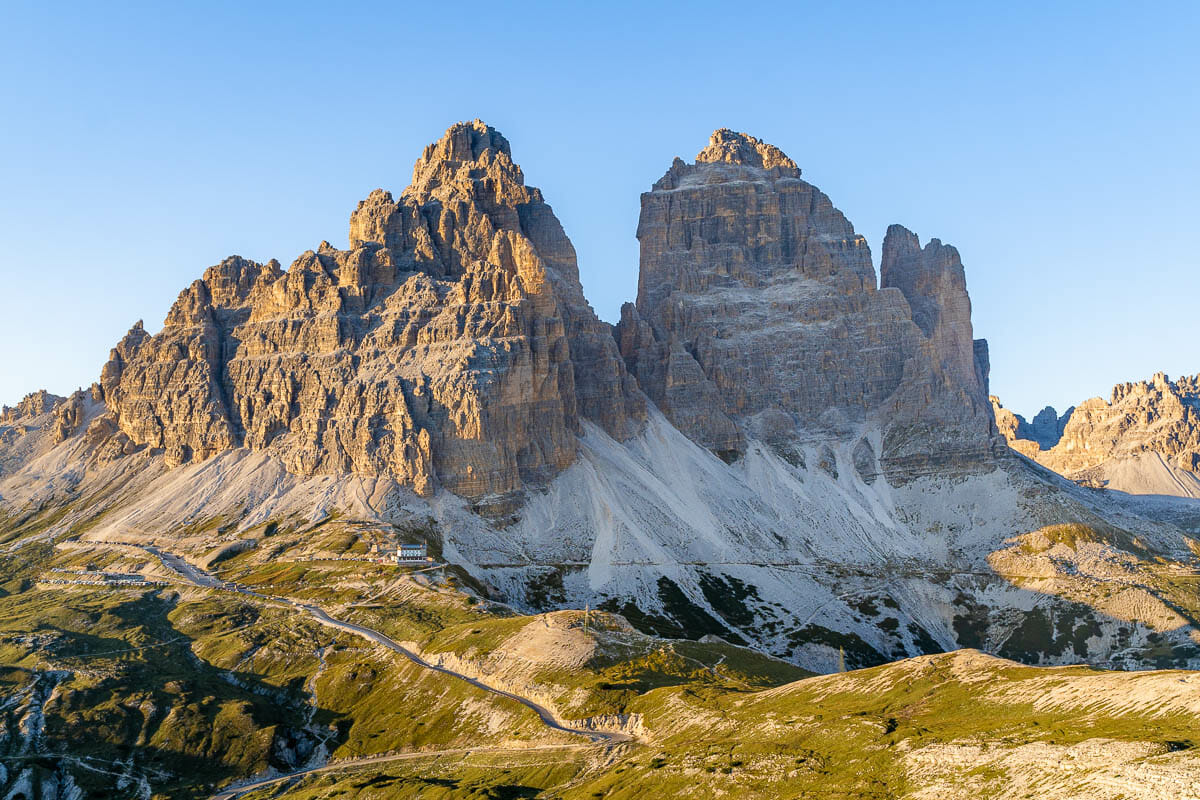
It’s a very straightforward hike, you can’t really go in the wrong direction. The best is to do the hike counterclockwise and start by walking in the direction of Rifugio Lavaredo.
This part is the easiest one as it’s mostly flat, after that you will need to walk uphill so it gets a little more difficult.
The next checkpoint is the Dreizinnenhütte (Rifugio A. Locatelli) where you can find two lakes and a couple of caves as well.
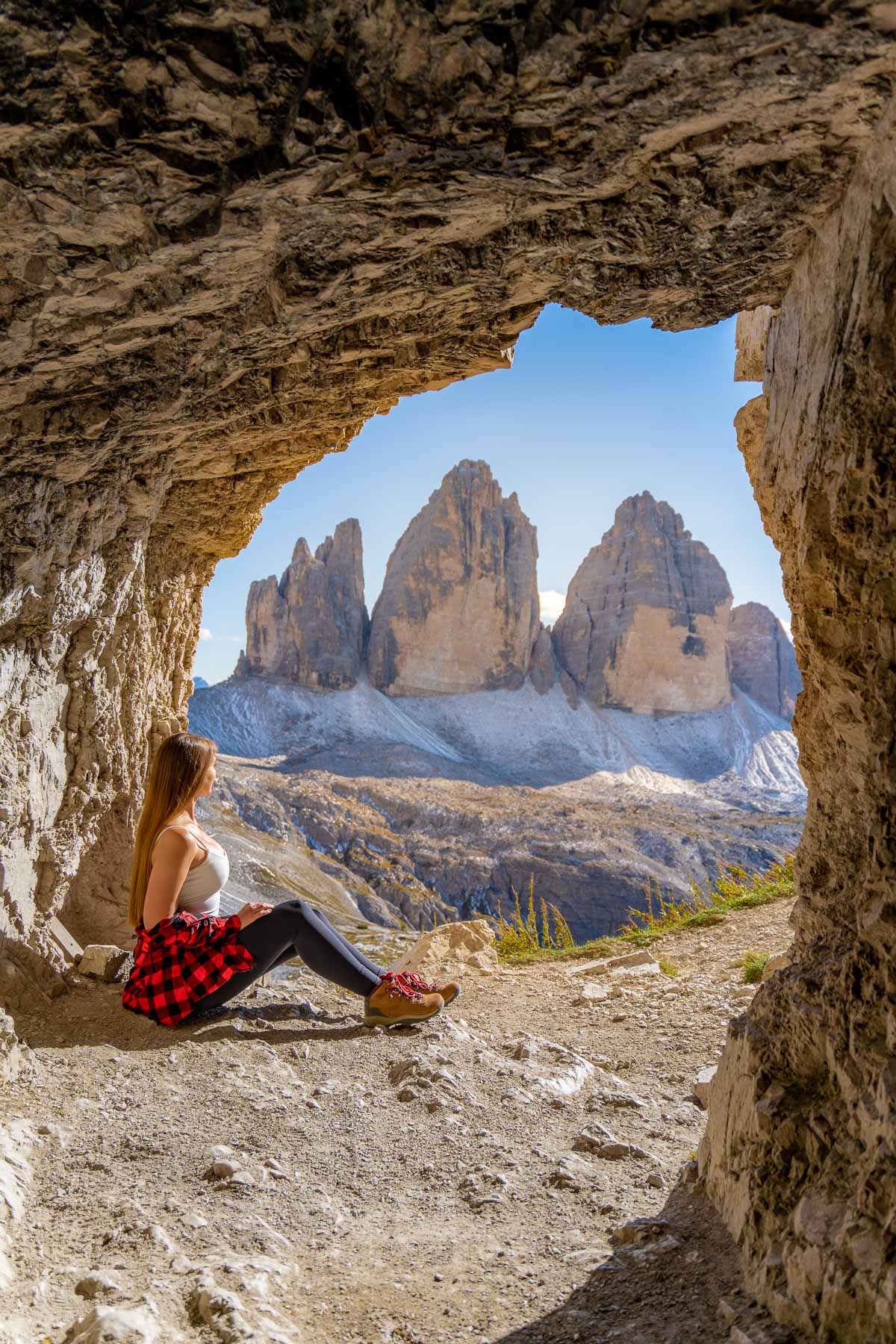
The hardest part comes after this, as you need to descend to the valley, just to walk up on a hill again. It’s still not a hard trail but due to the elevation gain, it’s a bit more difficult.
The last checkpoint is Malga Langalm, after that the route heads uphill again, and not long after you will already see Rifugio Auronzo, from where you started the hike.
All in all, completing the Tre Cime di Lavaredo hike is a must on every Dolomites road trip itinerary! It’s a fairly popular hike due to the insane views so it usually gets busy during the day so try to arrive early in the morning to avoid the crowds.
If you want to know more about the trails, check out my step-by-step guide about the Tre Cime di Lavaredo hike !
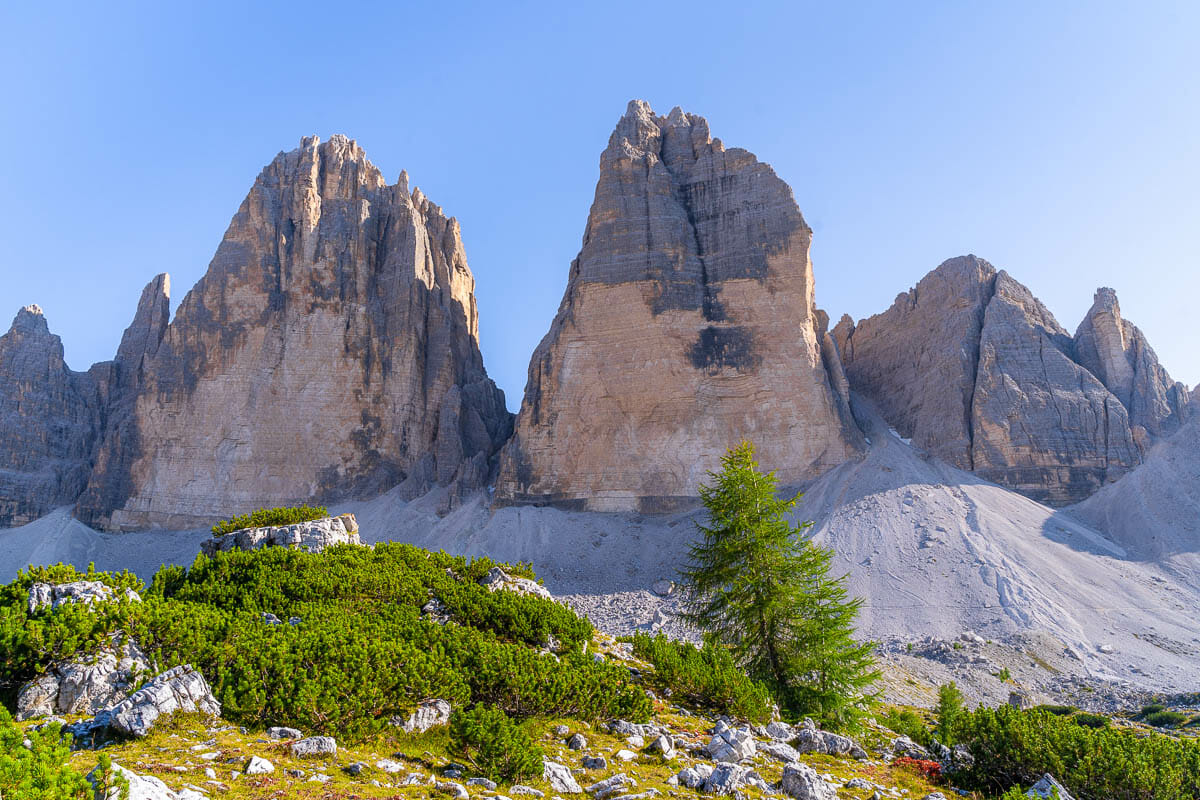
Hiking to Cadini di Misurina
If you have some energy left after completing the Tre Cime di Lavaredo loop hike, I would recommend adding an extra hike to your day.
There is an insanely beautiful viewpoint along the Cadini di Misurina hiking trail and it would be such a shame for leaving it out of this Dolomites road trip itinerary!
Hiking to Cadini di Misurina is one of the lesser-known hikes in the Dolomites and not many people know about it, therefore it’s less crowded than the Tre Cime di Lavaredo trail.
They have the same starting point from Rifugio Auronzo so it makes sense to do both in one day (you’ve already paid the €30 toll fee after all) but if you want to do the Cadini di Misurina hike, you will have to hike in the opposite direction of Tre Cime.
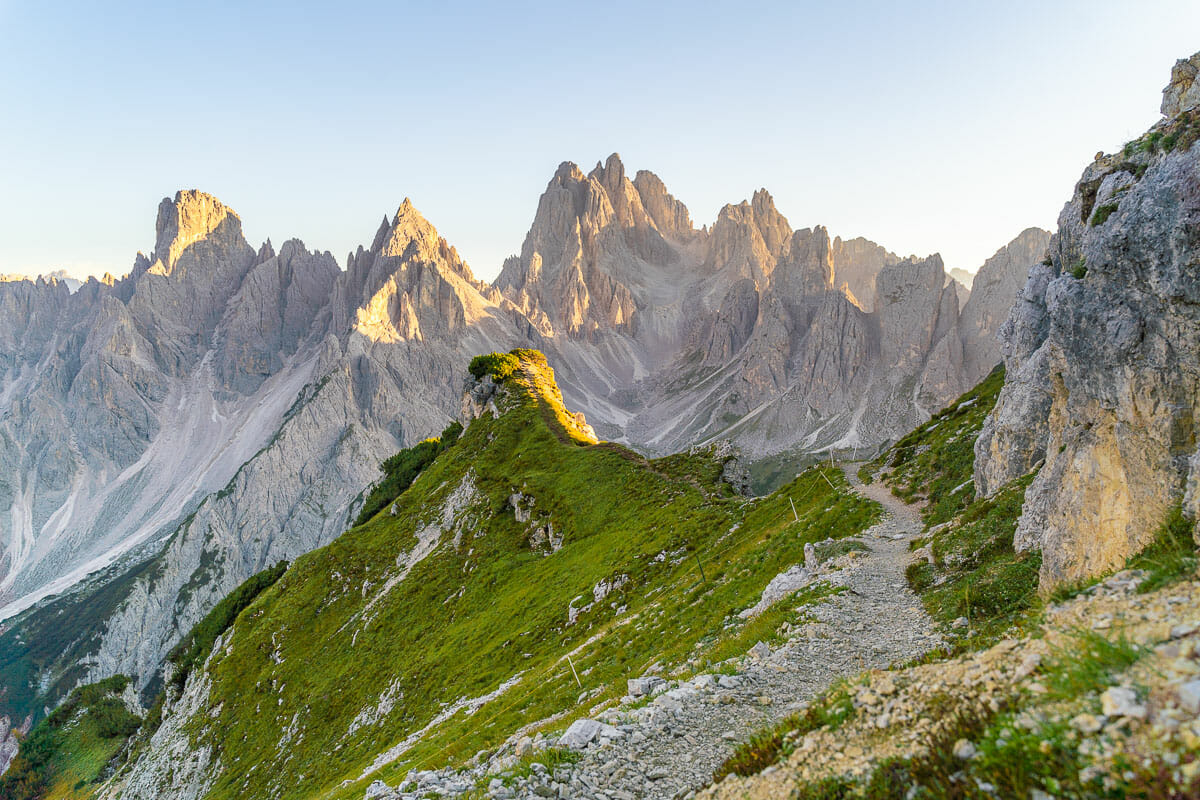
It takes around 35-45 minutes to get to the viewpoint, depending on your fitness level. It’s only a 2 km (1.2 miles) hike from Rifugio Auronzo but it’s a bit steep (112 m/370 ft elevation gain) and it’s important to know that this hike is not suitable for people with a fear of heights.
If you want to know how to get to the viewpoint pictured above, read my step-by-step guide about the Cadini di Misurina hike !
Please only climb to the viewpoint at your own risk and don’t even think about doing it if the trail is muddy or wet. If you slip and fall from there you can hurt yourself pretty badly so please be super careful!
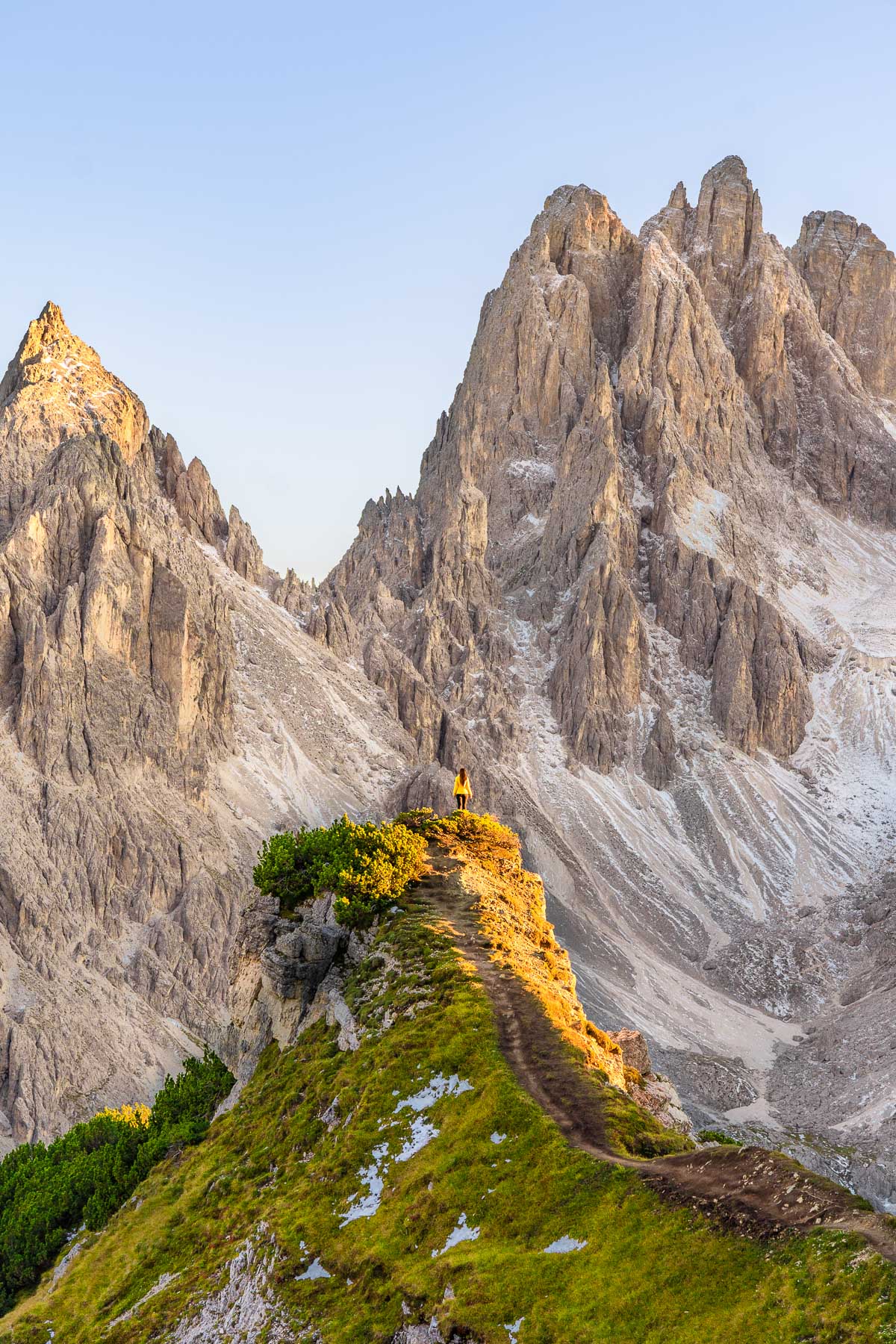
Useful Info for Visiting the Dolomites
How to get to the dolomites.
Although the Dolomites are undoubtedly one of the most beautiful dream destinations in the world , getting there is a little bit tricky as there is no dedicated airport in the area.
Since this Dolomites road trip itinerary will require you to have your own car, if you’re planning to arrive from a nearby country it’s best to take your own car and drive to the Dolomites from your home.
We personally arrived from Budapest and even if it was a 9-hour drive it was much better (and cheaper) to have our own car.
If this is not an option for you, there are many airports in the region to choose from. If you’re looking for a bigger international airport, the best option is to arrive at the Marco Polo Airport in Venice, from there you can reach Ortisei (the first base on this Dolomites road trip itinerary) within 3-3.5 hours.
Another great option is the Orio Al Serio Airport in Bergamo or the Malpensa Airport in Milan, it takes 3 hours to get to Ortisei from Bergamo and 4 hours from Milan. If you’re planning to go on a big Northern Italy road trip , you can easily visit all these places in one trip!
Munich Airport in Germany can be another great option, it takes around 3.5-4 hours to reach Ortisei from Munich. If you have more time you can include a few stops in Tyrol and Bavaria as well, like visiting the Neuschwanstein Castle !
The disadvantage of arriving at Munich is that you need to cross the German-Austrian and the Austrian-Italian border in order to get to the Dolomites and with a rental car it’s not the easiest thing to do.
There are a couple of other smaller airports in the area, like Treviso Airport, Valerio Catullo Airport in Verona, or Bolzano Airport so it’s worth taking a look at them as well.
No matter which airport you arrive at, you will need to rent a car for your Dolomites road trip. I recommend Discover Cars to check the best offers and availability!
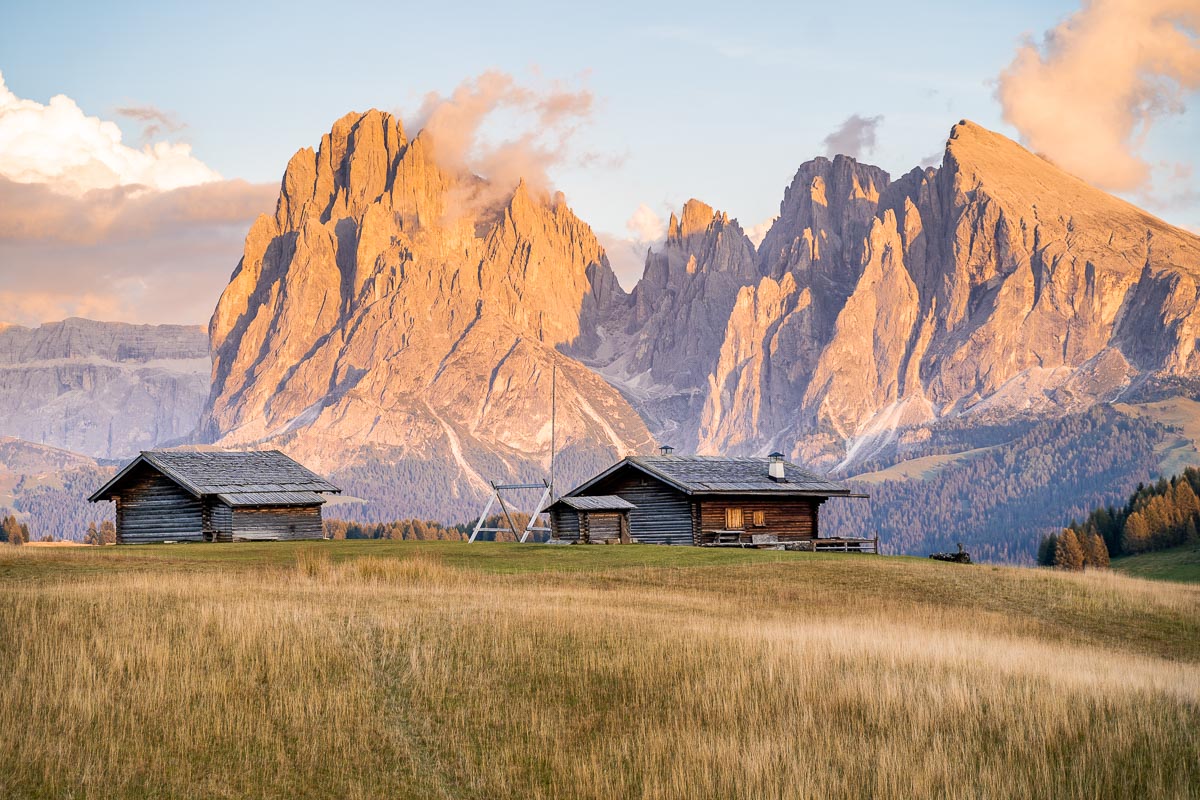
Best time to visit the Dolomites
The best time to visit the Dolomites entirely depends on your personal preferences. Although each season has its own charm, for the sake of this Dolomites road trip itinerary I recommend visiting the Dolomites from the end of May until the end of September.
The simple reason is that before or after this the mountains are usually covered with snow and many hiking trails are not accessible anymore. Don’t get me wrong, visiting the Dolomites in winter is still a great idea, just not so much for a road trip!
If you want to avoid the crowds, the best is to visit either in early June or the middle of September. We personally visited in the middle of September and we had the best weather, but of course, it can change from year to year.
All the photos you can see in this article were taken in the middle of September so you can have an idea about what the area looks like around this time.
How much time to spend in the Dolomites
As much as you can! Seriously, the whole area is so gorgeous that you will not believe your own eyes.
As a first-timer, I recommend spending at least 4-5 days in the Dolomites. This will give you enough time to visit the must-see sights such as Alpe di Siusi, Lago di Braies or Tre Cime di Lavaredo.
There are countless amazing hikes in the Dolomites so if you’re an outdoor person and you love hikes, you can even spend weeks in the Dolomites without getting bored.
I’d say the perfect amount of time would be between 1 or 2 weeks but I understand that not everyone has that much time for a mountain vacation.
That’s why I created this 5 day Dolomites road trip itinerary so you could visit all the best places in the Dolomites in just a short period of time.
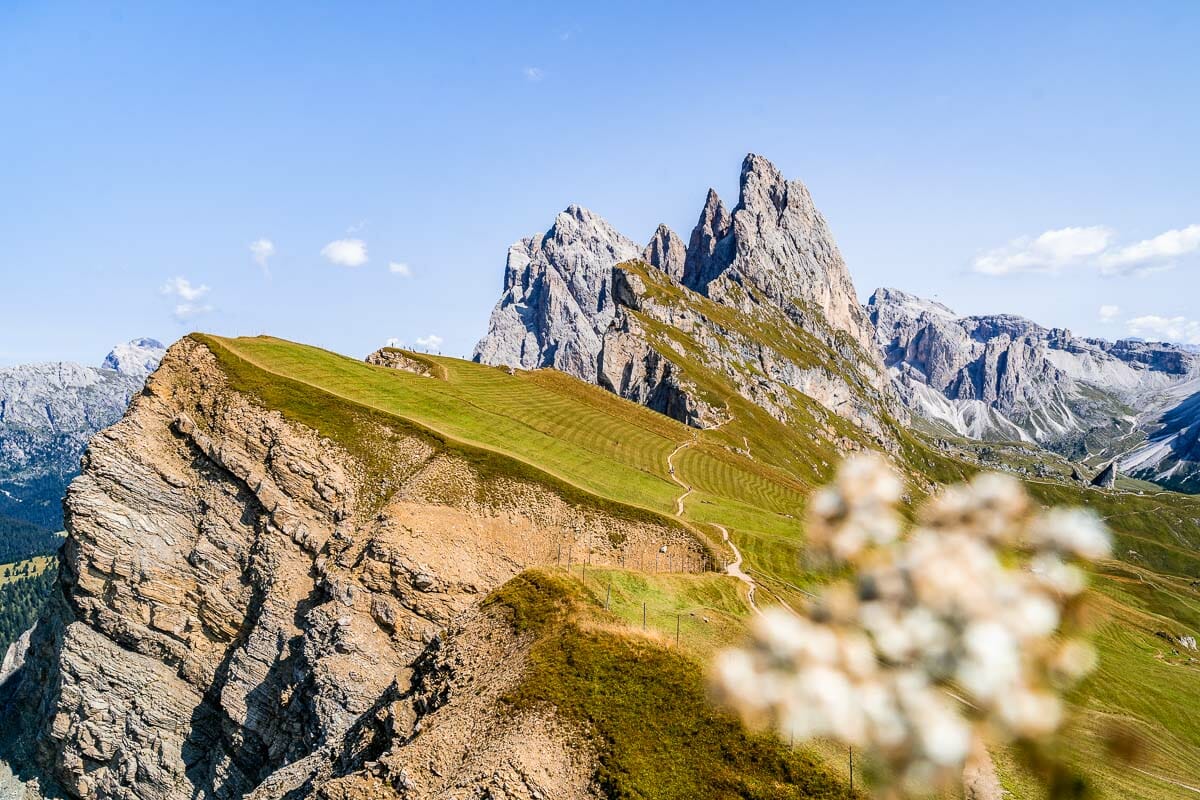
Planning a trip to the Dolomites?
Then you might want to take a look at all our other travel guides about the Dolomites. I promise, they are just as awesome as this article was!
- Where to Stay in the Dolomites: Best Areas & Hotels
- 11 Most Beautiful Lakes in the Dolomites You Can’t Miss
- 13 Best Hikes in the Dolomites You Don’t Want to Miss
- Tre Cime di Lavaredo Hike: All You Need to Know Before Visiting
- Cadini di Misurina Hike: How to Find the Famous Viewpoint in the Dolomites
- Hotel Review: Chalet Al Foss Alp Resort, Italy
- Hotel Review: La Maiena Meran Resort, Italy
Other Great Destinations in Italy: Cinque Terre | Florence | Lake Como | Lake Garda | Rome | Venice
Pin It for Later!
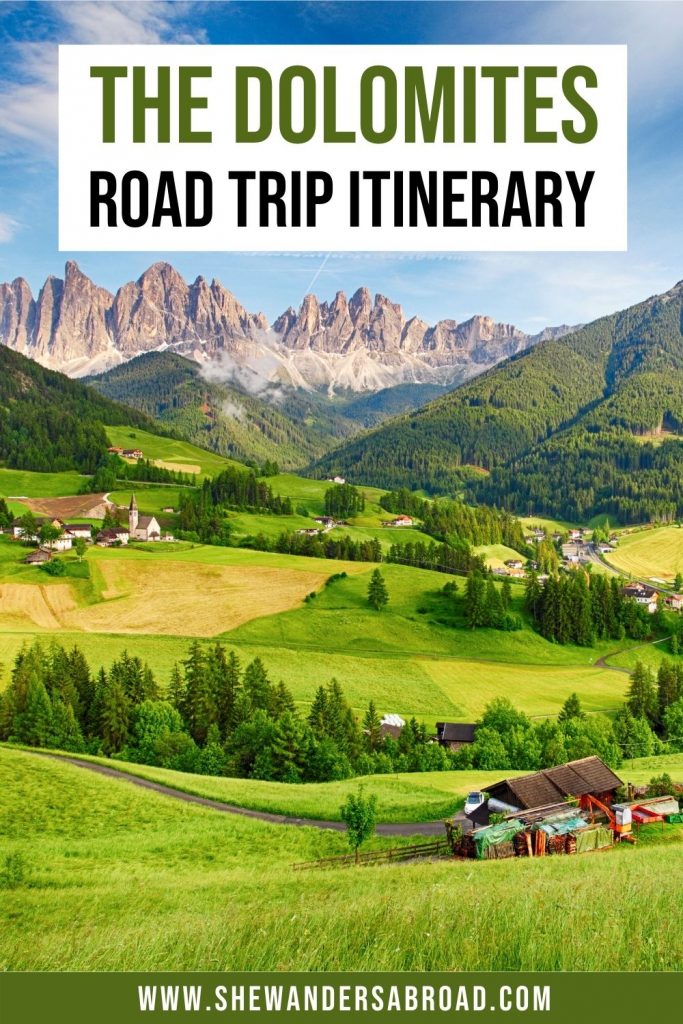
70 thoughts on “The Perfect Dolomites Road Trip Itinerary for 5 Days”
Seriously beautiful! We love a good road trip. I’ve only visited the Dolomites in the winter for skiing. Looks like a trip to hike and view the lakes in early autumn is a good call.
Yes I can only recommend going to the Dolomites in late summer/early autumn, it was absolutely amazing! I would love to go back in winter to see the beautiful snowy landscape too.
great work, i love the pins, photography and the useful information here! I lived in Italy for a year and never made it to the Dolomites – now im kicking myself! I think its time to go back!
Oh wow a year in Italy sounds wonderful, I’m sure you’ve seen so many beautiful places there! But yeah next time when you go to Italy I would really recommend going on a road trip in the Dolomites ?
Absolutely love your photos! You know, the entire area of Dolomites is just so magical in any time of the year. We have visited last year in first days of November and the color palette was just incredible. Though chances of getting a day with good visibility are less. I am saving your post for the next time I am there, because I am sure it is one of those places I would want to come back to.
Thank you so much Lena! You are so right, the Dolomites are really beautiful in every season. I would love to see the autumn colors there or the snowy landscape next time I’m visiting!
It was such a great guide to read Kriszti! Loved all the detailed explanations and. your photos are stunning! I would love to visit this part of Italy, maybe next year!
Thank you so much Ophélie! I’m sure you would love a road trip in the Dolomites, the landscape is just so incredibly gorgeous!
Such a detailed ultimate guide Kriszti! And the photos are all absolutely wonderful, it only confimed how high the Dolomites are on my bucketlist! Thanks a lot for all the tips!
You are so welcome Léa! Hope you will be able to visit soon!
I can’t wait to visit the Dolomites. Hiking at Seceda is on top of my list. Apparently I’ve been to South Tyrol and the Dolomites area with my parents and grandparents a couple of times as a child but I can’t remember. I save this for later when I can travel there again ?
Haha I can totally relate, I can’t remember many things from my childhood either. I really hope you will be able to go there next year, it’s such a stunning area!
Wow what a comprehensive post! I’ve pinned this so I can return to it because there’s so much useful information
Thanks so much Kelsey!
Wow what a stunning and unique range! I had no idea you could do so much around the Dolomites!
I was quite surprised too because I didn’t think it either, but it turned out that even spending 5 days in the Dolomites was not enough! Can’t wait to go back and discover more of this amazing area.
I saw a youtube video in quarantine of the Dolomites and have moved it to the top of my bucketlist. This post confirms that! THE LAKES. Your photos are incredible, too. Thanks for sharing 🙂
Thank you so much Carley, I’m so happy you liked this guide! And I can only agree with you, the Dolomites are just simply stunning!
We’ve usually gone to the French Alps for hiking but this has convinced me that the Dolomites are next on the list. They look even more serene and your pictures are stunning!
If you love the French Alps I’m sure you will love the Dolomites as well, especially if you like hiking! There are so many amazing hiking trails in the Dolomites with stunning scenery.
Dolomites has been added to the bucket list. Alpine lake reminds me of Emerald Lake in Yoho National Park – Canada. Many of my trips are decided by something bright, rainbow, or sparkly. PS – your skirts are absolutely adorable.
Thank you so much Chelsea! I would love to visit Canada and all the beautiful national parks in the country!
This is such a great guide Kriszti and I will definitely saving this for my next trip to the Dolomites! Last time I was in the Dolomites it rained the entire 4 days and there were major floods so I couldn’t actually see anything. I hope to go back soon though!
I’m so sorry you had such a bad weather in the Dolomites! Hopefully next time you’re visiting it will be sunny and clear!
WOW!!!! this doesn’t even look real….it looks like something just out of a fairy book tail. I have seen the Dolomites before, but your pictures are absolutely incredible!!! Pinned this to the top of my bucket list. Your article is super complete for anyone looking to visit this amazing place. Thank you!
Aww thank you so much Paula, you just totally made my day! I’m so so happy you liked this article!
This area looks absolutely stunning, I had never heard of this place before! Being in nature is one of the best things to do and I love being in the mountains, so I am adding this to my list of places to visit. Thanks for sharing!
You are welcome! Hope you will be able to do a road trip in the Dolomites soon, I’m sure you would love it!
Amazing! I would love to see St. John’s church. Great guide for a beautiful location!!
Thank you Erinn, I’m so glad you liked it!
The Dolomites are absolutely gorgeous and you’re photos are amazing! I’ve been to Italy 4x and have never been to this area. On my next trip to Italy I’d love to get out of the cities and take this road trip to get in some great hikes!
Thanks so much Vanessa! I can only recommend visiting the Dolomites on your next trip to Italy!
Gosh the Dolomites never get old. The photos are stunning. I need to visit ASAP!
Thank you so much Alanna! Hope you will be able to visit soon!
I loved reading your post! I visited the Dolomites once when I was a kid, but I think I was too young to fully appreciate them. Now that I’ve been seeing beautiful photos all summer long, I can’t wait to go back and explore the Dolomites all over again 🙂
I’m so glad you liked it Sara! The Dolomites are so stunning, I’m sure you will enjoy your trip there!
So. Beautiful! A friend of mine lives in Belgium currently and did a big trip out there just a month or so ago…the envy was real! Saving this one for later. Great post!
Oh I can totally imagine! I would love to go back for a longer time and explore more of the Dolomites!
The Dolomites are stunning, and your photos are amazing! Driving is definitely the best option, but there are full day tours that leave from Venice, if you don’t want to drive yourself.
Thanks for the info Shannon! Luckily we had our own car with us so we didn’t need to look for another options but it’s good to know that taking day tours is a possibility as well!
Thanks for sharing this itinary. Your photos are stunning. I cannot wait to visit the Dolomites!
Thank you so much Kelli, I’m glad you liked the article!
Great post. We are hoping to visit the Dolomites next year. This will be a helpful travel planner
Thank you, I’m so happy that you liked this post about the Dolomites! Hope you will be able to visit next year!
Thank you for your post. I am planning a trip to the Dolomites in mid-October, and noticed that most cable cars will not longer be operating. For the Tre Cime di Lavaredo hike, do we need to get a cable car up? Thanks!
Hi Kate! No, you don’t need any cable cars for Tre Cime di Lavaredo, you can drive all the way up to Rifugio Auronzo where the hike starts. Alternatively you can use the public buses if you don’t have a car. Hope you’re gonna have an amazing trip!!
Looks amazing! Nothing better than a mountain vacation. Thank you for sharing this.
We are looking to go the first week in October 2022. Some of the hotels you recommended close October 1,2, or 3. Others are open. We are kind of stuck with these dates, due to another commitment afterwards. SO, would you recommend we continue pursuing this trip. Or postpone until another year.
Hi! I think this Dolomites road trip works best from late spring to early autumn because in the winter period, lots of roads and hiking trails are closed, and also some hotels close for the season as well. That being said, if you can only go in the first week of October, I think you can still make the best of it! Just be prepared that you’ll most likely need to modify this itinerary. Oh and also, it might already snow during that period!
Hi- I stumbled on your blog …amazing ….my family of four ( two adults and two teens ) are planning a winter ski trip to the Dolomites. The possibilities seem endless…your site mostly touches on spring/summer activities there – any places you can recommend there for the winter ski season ?
Hi Shira! Unfortunately I’ve only been to the Dolomites during summer and fall so I don’t have any personal experience in the winter season. However, I’m sure you’ll find lots of opportunities in winter as well, especially if you love skiing or snowboarding!
Hi, is it possible to go in last week of May? Nice post! Thank you so much!
Yes, I think the end of May is one of the best times to visit the Dolomites.
We a family of 5, two 55-year-olds and three in their mid-20s will be visiting the Dolomites for 5 nights in July/August and would love to follow your itinerary. A few questions we would like to ask would be: – Are all the hikes mentioned in your itinerary doable for normal physical level fitness people? We are not hikers but can walk a long distance (without climbing steep hills). We will also be renting an SUV. Is driving in the Dolomites difficult? What should we be aware of and which part of driving in your itinerary is the most difficult? Last question, How much would the hotels you mentioned and car rental cost (average)?
Hey! Yes, all the hikes are totally doable. We’re not huge hikers either but I found most of the hikes pretty easy so I think you’ll be able to do them as well. There are some winding roads you need to be careful with but other than that, driving in the Dolomites is an amazing experience. I can’t remember any parts that were difficult to drive in. Unfortunately, I can’t really tell you much about the costs – we came with our own car so we didn’t do any rentals and hotels usually use dynamic pricing so it’s hard to stay how much it will cost without checking them individually. I linked the two hotels we stayed at so I would recommend checking their availability/price during your travel dates.
Thank you very much for an informative post about the Dolomites. This unique area in Italy has been on our bucket list for very long time and your post fuels our wanderlust to explore the Dolomites this autumn. Thank you dear and safe travels. Martina x x x
Thank you so much for your sweet comment! I’m so happy I was able to help 🙂
thanks for the detailed post and beautiful photos you had! may i check if is possible for us to drive directly in alpe di suisi area, from your map compatsch to malga sanon swing? Instead of walking for 1 hour. Thank you.
Sorry to miss out this, if I am not renting car, can I reach St. Magdalena/St. John church by bus? I checked google maps there is this option, just not sure how reliable is the public transport in Dolomites area. If not, any car rental company you are aware of that offers affordable rate? Thank you.
I’ve never tried public buses in the Dolomites so I’m afraid I don’t have any reliable information other than the one you gathered on Google. We took our own car to the Dolomites but in other cases, we always check car rental sites like RentalCars, DiscoverCars, etc. and choose the one that has the best ratings and rates in the area.
Hey! No, unfortunately, it’s not possible unless you have a hotel booked in the area. In this case, you are allowed to drive up but only to your hotel, not any further, and you also need to obtain a special permit from your hotel. This is valid on the first day of your arrival, on other days you still can’t drive up between 9 am and 5 pm.
Just wanted to thank you for all this information! Super easy to comprehend, detailed, and informative. My family and I just got back from the Dolomites where we primarily used your blog for our itinerary and it was a fantastic trip. Much appreciated.
Aww I’m so happy to hear that! Thank you for sharing it with me 🙂
Thank you, Kriszti. All helpful info as we plan our trip for March.
So happy to hear that! Hope you’ll have a great trip!
Thank you so much for this post! Do you know anyone that has been to the Dolomites in May? I would really like to spend time there in May but certain information I keep reading makes it sound like a lot is closed in the area then or hikes may not be doable.
Unfortunately not, we’ve been twice so far but both of it was in September. I think hikes should be absolutely doable in May already, the only ones I would really double-check are the ones that require a cable car ride to the trailhead but most don’t. I would love to go back in May too so let me know how it goes! 🙂
Hi Kriszti ,
Did you see Lake Misurina on your itinerary ?
On this trip we only drove by but on our second visit we spent a bit of time at the lake too, it was really beautiful!
i love your frank tips which really help put things in perspective when planning for a trip!
would you by chance have any more info re driving a german rental to the dolomites? e.g. would it be easy to find a rental firm that allows it (i’ve heard some allow with extra fees), as the major rental firms aren’t really clear on this on their websites nor their online rental contracts/selections.
i’m keen on combining a trip to bavaria with the dolomites, but have not been very confident in the planning process due to the lack of info for a multi country trip with a german rental. if logistics are too much of a hassale, i may have to split the places into separate trips or look at renting separate cars in the different countries!
Thanks so much for your nice comment, I really appreciate it! Unfortunately I don’t have any experience with rentals in the area as we always drove our own car from Hungary. Generally speaking, crossing the border with a rental is always a bit complicated but I’m pretty sure that there are some companies who allow this, maybe for an extra fee, so I think it’s best to contact them directly. Sorry that I couldn’t help more!
Leave a Comment Cancel reply

- Bosnia + Herzegovina
- Faroe Islands
- Philippines
- South Africa
- French Polynesia
- Solomon Islands
- Work With Me
10 Essential Things To Know Before Visiting The Dolomites In Italy
My trip to the Dolomites marked the beginning of the end of my time in Europe.
One final, last-minute hurrah to tick off a few long-held bucket list items, squeezed between my return from Georgia and impending flight back to the sunny shores of Australia.
In other words, it was mad dash of tossing out the beachwear and summer dresses I’d been carting around in my carry-on for the last 3 months, digging out my thermal layers, winter coat and woollen beanie from the bottom of my full-sized backpack, hoping it would be warm enough for the autumn in the mountains (it wasn’t) and quickly realising the general puffiness of winter attire meant I couldn’t fit quite so much in my trusty 30L backpack.
Plans were hastily thrown together, maps and bus timetables were poured over for hours and the endless possibilities of places to stay and things to do left me horrifyingly overwhelmed.
As it turns out, unlike a number of places I had travelled to this year, the Dolomites are incredibly well set up for tourists.
Public transport is prolific and runs on time, accommodation options are varied and plentiful, information centres are well informed and the food is pretty darn fantastic mixing the heartiness of Austrian fare with the moreish deliciousness of the Italian.
But in my haste to reach this stunning part of Europe, there were a few things I wished I had known beforehand, simple things that would have made my planning a little easier and things I’ll definitely be keeping in mind for my next visit.
These are my top 10 essential tips for visiting the Dolomites in Italy, and some practical things you should know before you go.
* This post includes affiliate links and any purchases made through these links will earn us a small commission at no extra cost to you.*
Carbonin or Schluderbach. Ortisei or Sankt Ulrich. Val Gardena or Gröden.
Straddling the border between Italy and Austria, almost every town, and sometimes even the mountains, have two names – Italian and German – and often, they’re not even remotely similar.

On my first day in the Dolomites, this led to fair few awkward encounters as my sleep-deprived brain after an overnight bus tried desperately to figure out why the very patient information attendant was repeatedly telling me to go to one place, which was completely different to the one listed on the information slip she’d just printed out for me. Turns out they were one and the same.
While bus timetables tend to list both names to help ease the confusion for us tourists, when you’re asking directions or buying a train ticket, whether the person you’re speaking to has a preference for German or Italian they may not use the place name you’re most familiar with.
Nothing beats a Dolomites road trip – whizzing past sprawling meadows dotted with quaint alpine villages, winding higher up a mountain pass to find one impossibly beautiful vista after another, gawking out the window as new, more impressive peaks tower overhead.
It’s a pretty amazing place to explore on four wheels, but the excellent public transportation means that those not keen on renting a car won’t be left behind.
If you’re a photographer hoping to chase the soft morning light, very short on time or an early bird not wanting to be constrained by a bus schedule, renting a car is certainly the way to go. Bolzano is the closest hub, though car rentals can be arranged from any of the nearby airports as well.
Search the best deals on rental cars in the Dolomites here.

During the buzzing summer season (late June to early September), dozens of bus routes return to service connecting all major villages and leading to many of the key hiking spots. Cable cars also resume their slow climb to the upper plateaus affording stunning views and easy access to many of the high altitude trails.
When low season sets in between summer and winter, getting around can be a little more tricky as these services begin to drop away, but it’s certainly not impossible. Keep a close eye on the timetable’s seasonal dates which are often listed year round and plan your itinerary accordingly. The STA website is an excellent database for all transport in the region.
Arriving by bus as well? Flixbus has major transport hubs in Bolzano and Trento, as well as a number of smaller terminals throughout the region. Find the best bus routes here.
DON’T MISS: YOUR COMPLETE GUIDE TO THE TRE CIME DI LAVAREDO HIKE
Thankfully, for the past four years of travel an Australian drivers license is all I’ve ever needed to rent a car and, given the short validity period , applying for an International Driver’s Permit was something I constantly put off doing.
It wasn’t until I was browsing through my options for car rentals in the Dolomites that I discovered an IDP is absolutely essential for driving in Italy.
A scrappy bit of paper that, somewhat annoyingly, it just so happened I did not have.
If you’re travelling to the Dolomites and don’t have an EU driving permit, be sure to apply for an IDP several weeks before you leave to ensure your plans for a European road trip don’t get derailed.

Longtime readers of The Sandy Feet will know that autumn is pretty much my favourite time of year in Europe, when colour washes through the endless forests, the summer crowds begin to dissipate and the climate returns to wonderfully mild temperatures.
When it comes to visiting the Dolomites, this is certainly one of the best times of year to visit.
It is true that the crowds in high season here can become a little overwhelming, especially along the most popular hiking trails which some have likened to being in a zoo – not a feeling I like to equate with a day out in nature. But on my visit in late autumn, with the frenzy of the warmer months long gone, I had the feeling of having almost everywhere to myself.
Spring is another beautiful time to visit when dewy summer pastures are unveiled beneath their winter coats and wildflowers blanket the countryside – a practically perfect scene to bust out your best rendition of ‘The Hills are Alive…’

It’s important to note however that visiting out of season is not without its challenges – many businesses and tourist services choose to close up shop for renovations or to take a vacation of their own before the madness of winter/summer set in.
Bus schedules are far more limited, cable cars stop running, hotels begin to take their last bookings and many restaurants are only open on weekends.
So, ‘budget-friendly’ might be a relative term, but as far as the Alps and Western Europe go, the Dolomites are an absolute bargain.
Cosy private rooms for the price of an Amsterdam dorm bed, affordable and prolific public transport, tasty and plentiful meals for under €10 and completely free and easily accessible hiking trails.
If you’re looking for an excellent value alternative to its French and Swiss neighbours, then the Italian Dolomites are your best bet. Plus, there’s pizza.

For penny pinchers visiting the Dolomites in Italy, these are some of my top money saving tips for the region:
Take away pizza with a view | As soon as you sit down to dine, the prices quickly start adding up. If you’re just after a quick bite for lunch or at the end of a long day, nothing beats a hot, wallet-friendly takeaway pizza enjoyed with a fabulous view of the mountains. Visiting out of season, this was sometimes also the only option during the week.
Order hot starters over mains | After a hard day of hiking, there’s nothing I crave more than a hearty meal, but after sitting down to eat on my first day and baulking at the prices of the mains, the cheapest of which was almost €30 (close to 50 Australian Dollars), I settled on a starter portion of pasta instead. Turns out, the mains tend to follow the rule of being a meat, veg and carb combo, while the starters were actually very decent portions of almost anything else – pasta, salad, soups etc. – and much more affordable.
Buy multi-day transport tickets | This was my biggest money saver of the trip. If you’re travelling over longer distances or planning to use public transport for several consecutive days, buy a day- or multi-day ticket instead of singles for each trip. For whatever reason these are only sold at a few of the regional train stations – Bolzano and Dobbiaco to name a few – but they can save you a huge amount on transport. Chat with the information attendants at the train or bus station to confirm where your ticket will be valid as some special services (like the shuttle to Rifugio Auronzo for Tre Cime di Lavaredo) are excluded.
Make use of free transport In Val Gardena | Many hotels in Val Gardena provide a free Mobil Card as part of your reservation which gives you unlimited access to all buses in the area for 7 days. Check if your hotel is a member of the Val Gardena Tourist Association to get this deal.
The Dolomites are not a place to come and sit idly, they’re a place to get out and explore on foot.
With spectacular views in every direction, trails that weave through forests, across sweeping green valleys and beneath some of the most impressive rock formations I’ve ever seen, it’s a veritable playground for hikers and lovers of outdoor adventure.
Hiking trails are available for all abilities, from one of the best hikes in the Dolomites, Tre Cime di Lavaredo , which is largely flat, to the alternate route to Lago di Sorapis which is probably one of the hardest hikes I’ve ever done, there’s a little something for everyone.

START PLANNING: 4 STUNNING HIKES YOU CAN’T MISS IN THE DOLOMITES, ITALY
If there’s one regret I have from my time in the Dolomites, it would be missing the chance to fall asleep and wake up in a log cabin in the heart of the mountains. Setting my alarm for some ridiculous hour, stretching out like a cat in my cosy sleeping bag and clambering out, bleary-eyed before dawn to see the first glimmer of day creep across an epic skyline of spiky peaks.
For me, this was the one major drawback of travelling in the Italian Alps out of season. Rocking up in late October, when the last of the mountain rifugios had closed their doors to visitors and renovations for the winter season were well underway, it just wasn’t meant to be.
Still, if you get the chance to wake up in such a glorious setting, take it!
Just be sure to call well in advance for enquiries as they book up fast and emails can often go ignored.

What’s better than staying in one mountain rifugio? Staying in a bunch of them!
It’s no secret that the Dolomites are one of Europe’s best summer hiking destinations, and one of the best ways to escape the crowds is to get off the main hiking routes.
Most visitors arrive around mid-morning and stick to the most popular day trails, which means anywhere a bit further off course will see the crowds quickly diminish.
Though like most visitors, I only managed to do day hikes, there are a number of fantastic multi-day routes that allow you to hike from hut to hut and really drink in the beauty of the Dolomites.

If all your knowledge of the Dolomites has come from what you’ve seen on the ‘gram, you’d be forgiven for thinking that this stunning corner of Europe was composed of no more than ten ridiculously beautiful locations.
As a millennial who spends far too much time on her phone, and has an awful habit of sinking into the mindless scroll and double tap routine, barely a day goes by that the Dolomites don’t pop up on my feed.
A warm sunny glow glancing off the jagged peaks of Tre Cime di Lavaredo , the teal surface of Lago di Braies peppered with charming wooden boats or just beyond the wistful gaze of some hatted and blanket-clad figure, the impressively rugged facade of Seceda draped in mist or with an out-of-focus foreground of wildflowers. No matter how many times I’ve seen them online, the changing conditions have the ability to transform these places completely before your eyes, and finally seeing them in person, they are nothing short of spectacular.

What struck me most, however, was that there is just SO much more to the place than what is distilled into these few perfectly beautiful but slightly overdone perspectives.
The massifs are larger than life, forests are filled with colour and enchanting silences and while the iconic sights are so beautifully captured, what I hadn’t expected was that what exists outside of this field of view, outside the tiny portion of the panorama that gets squeezed through the shutter, could possibly be even more beautiful.
I know the ‘Instagram spots’ will form the basis for so many people’s itineraries – they certainly did for me – and they are definitely worth visiting, but I would encourage you to also seek out other places for their beauty as a whole and not just for one singular image.
Trust me, they’re just as incredible.
READ NEXT: HOW TO HIKE TO THE SPECTACULAR LAGO DI SORAPIS
When I began planning my trip to the Dolomites, I was quickly overwhelmed with all the options of where to stay. Couple that with limited October transportation and I was soon lost down a rabbit hole of Google Maps, possible hiking itineraries, bus timetables and an infinite number of tabs that I could no longer keep track of.
On the map, the Dolomites cover a pretty small area, but they’re not that small, and if you’re anything like me, you’d rather spend your time out in the mountains than stuck behind a windshield watching them flash by in the distance.
I’d highly recommend choosing either one area as a base and exploring the nearby area well, or moving between several key bases over the course of your stay.
Due to my limited transport options, I chose to spend several nights in Cortina d’Ampezzano and another few in Ortisei which both lie in the heart of the mountains and didn’t require all that much travel to reach the hiking trails. Set in a gorgeous valley between the two, Alta Badia is another excellent base, though out of season, transport here is virtually non-existent.

Some of the better-established villages and their main attraction include:
Cortina d’Ampezzano – Great for visiting Tre Cime di Lavaredo and Lago di Sorapis , as well as Passo Giau which I wasn’t able to make it to.
Dobbiaco/Toblach – Less scenic than the other alpine towns, this is the closest major hub to popular Lago di Braies and also provides easy access to Tre Cime di Lavaredo. You could also visit both on your way to or from Cortina.
Ortisei and Val Gardena – Perfect for reaching Seceda and Alpe di Siusi. Though further afield, this area is also well located for reaching Lago di Carezza and the Torri di Vajolet (Vajolet Towers).
Alta Badia – Set between spectacular mountains but transport is more limited than elsewhere.

Calabria Itinerary: A Fantastic 7-Day Road Trip Of Italy’s Far South

Wonderful Things To Do In Scilla | The Prettiest Town In Calabria

Pizzo : A Day Trip To Calabria’s Home Of Tartufo

Things To Do In Tropea | The Pearl Of Calabria

Hiking To Lago Di Sorapis: Everything You Need To Know

4 Stunning Hikes You Can’t Miss In The Dolomites

Tre Cime Di Lavaredo: The Best Day Hike In The Dolomites
13 comments.
Excellent guide Freya. I’ve done 2 big Europe trips but never have the chance to go down to Italy yet. The Dolomites is definitely on top of my list for Italy and it’s good to know where to base myself off for hiking. The landscape looks out-of-this-world! 🙂
I am going in June and unfortuantely inspired by instagram posts, but how else would I get to know other amazing parts of the world?! Anyways, I loved your insight and tips because I too have been overwhelmed by the Dolomites destinations, insta posts, and where to stay (there’s so many rifugios!). This article helps alot. 🙂
Hey Scott, Thanks so much for your comment! Absolutely nothing wrong with being inspired by Instagram – I certainly was – but there are also so many other incredible spots in these mountains that aren’t famous on the ‘gram but are absolutely worth exploring as well. Good luck with your trip!
Hello, Thank you for your tips! I’m going to Italy next month and I would like to know if it’s worth it to go to Dolomites around October 26/27th. It seems that most of lifts and places are closed. But would you know if there’s still something to do there (without car, unfortunately… =/)?
Thank you very much!
Unfortunately, it will be quite tricky visiting at this time without a car, especially if you want to reach the most beautiful areas. There are definitely day hikes you can take from many of the towns, it will just be a matter of finding which towns you can actually reach. I’d say Cortina and Ortisei will be most accessible and offer a few day hike options from town as well.
Thank you so much for these tips! We’re about to start planning our trip and this is immensely helpful. If there were any must-see/do “off the beaten path” or “off the Instagram path” places you visited, we’d love to know! We promise to keep them a secret 🙂
Glad they were helpful for you, Sari! Honestly, the Dolomites cover a huge area and there are only around 10 super popular Instagram spots so you’ll find plenty of other stunning areas to explore. I haven’t been, but the Alta Badia valley and Fannes Nature Park (away from Lago do Braies) look absolutely beautiful and have plenty of hikes available. The high plateau above Cortina is also stunning and covered in hiking trails. I came through here on the alternate return route from Lago di Sorapis and although it was challenging the views were incredible.
You have hooked us! We are planning to backpack 9 days, hut to hut the Dolomites in September 2020. Starting our plans now, your post really have helped.
So glad it was useful for you and sounds like you’re in for an amazing trip!
My fiance and I are heading to the Dolomites for our honeymoon in September, and this post is so helpful!
Where was the last picture taken?
How exciting! September is such a beautiful time to visit. The last shot is overlooking Rifugio Faloria which is perched above Cortina. I reached here via an alternate return route from Lago di Sorapis, but there are plenty of beautiful trails on this plateau where you could find a similar view.
Hi, Freya! I’ve just been through all the information you give – Thanks a lot! But I still have some doubts about the best time of the year to go. I will be travelling in North+Central Italy for 3 or 4 months, with a camping car, alone. The Dolomites are my main goal. I want to do some hiking and I want to take my camping car as far as possible, so I don’t need to stay in ‘refugi’. The problem: I hate crowds!… I suppose July and August are way too crowded . What about May? Or June? Or September? I understand you were there in October, but that is no longer possible for me. I would be very thankfull for any tips on how to escape the crowds… 😉
Hi Miguta, there is generally a fair bit of snow around until mid-June so many of the trails might not be that accessible, though it will depend on where you plan to go and whether there is a late snowfall this year. So far it’s been a very warm winter so this might not end up being an issue. September is an excellent time to visit! During the busier months, I’d suggest getting an early start at the popular spots or hiking some of the more remote routes to avoid the crowds. In 3 months you should be able to see plenty as well 🙂
Leave a Reply Cancel reply
Your email address will not be published. Required fields are marked *
Save my name, email, and website in this browser for the next time I comment.
Post comment
This site uses Akismet to reduce spam. Learn how your comment data is processed .
The Dolomites
The jagged peaks of the Dolomites span the provinces of Trentino and Alto Adige, jutting into neighbouring Veneto. Europeans flock here in winter for highly hospitable resorts, sublime natural settings and extensive, well-coordinated ski networks. Come for downhill or cross-country skiing and snowboarding or get ready for sci alpinismo (an adrenaline-spiking mix of skiing and mountaineering), freeride, and a range of other winter adventure sports including those on legendary circuit Sella Ronda. This is also a beautiful summer destination, offering excellent hiking, sublime views and lots of fresh, fragrant air.
Attractions
Must-see attractions.

Museo Ladin
Atmospherically set in a castle 15km south of Brunico and full of folk treasures, this is the best of three museums in this region devoted to Ladin…

LUMEN Museum of Mountain Photography
Anyone passionate about the mountains should make a beeline for this captivating museum, opened in 2018 at the summit of Kronplatz ski resort. The…

Chiesetta di San Giovanni in Ranui
Sitting alone in a meadow below the gargantuan spiky peaks of the Odle mountain group, this tiny and almost impossibly picturesque onion-steepled church …

Messner Mountain Museum Kronplatz
Mountaineer Reinhold Messner's sixth and final mountain museum also sadly happened to be one of the final projects of star architect Zaha Hadid before her…

Messner Mountain Museum Ripa
Brunico's 13th-century hilltop castle is the evocative setting for mountaineer Reinhold Messner's fifth 'Mountain Museum'. Opened in 2011, it documents…

Kriegerfriedhof
This pristinely maintained cemetery set in a forest on Kühbergl just behind the town has graves of soldiers from the nearby WWI front as well as a section…

The lofty two-spired baroque cathedral you see today was built on top of the AD 980 Gothic-Romanesque original in 1745. While the bishop decamped to…

Diözesanmuseum
This museum is far more interesting than most of its ilk, and its magnificent palazzo (mansion) home testament to Bressanone's once-important religious…
Plan with a local
Experience the real Italy
Let a local expert craft your dream trip.

Latest stories from The Dolomites
Filter by interest:
- All Interests
- Adventure Travel
- Art & Culture
- Beaches, Coasts & Islands
- Food & Drink

Wildlife & Nature
Sep 2, 2020 • 2 min read
Italy's famous Marmolada glacier, known as the Queen of the Dolomites, could disappear in 15 years, scientists have warned.
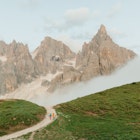
Jun 27, 2020 • 10 min read

Jul 19, 2019 • 5 min read

Jun 8, 2018 • 5 min read
3 Zinnen Dolomites is the Ultimate Ski Vacation in Italy
September 16, 2023 | OnTheSnow Staff
It’s no secret that the Italian Alps is one of the most renowned ski destinations in the world. All told there are more than 100 ski resorts spread throughout Italy’s Alps, featuring some of the world’s best ski terrain, jaw-dropping landscapes, charming towns, and unique experiences. And located in the heart of the Italian Dolomites, a UNESCO World Heritage Site, is one of Europe’s most incredible ski destinations, 3 Zinnen Dolomites . Stunning alpine landscapes, world-class skiing, and urban life all converge at 3 Zinnen Dolomites, in South Tyrol, for an unmatched winter experience.
Skiing at 3 Zinnen Dolomites
What was previously a destination of two small ski areas, has grown extensively in the last decade into one large, connected ski destination. Today, 3 Zinnen Dolomites, is comprised of five interconnected mountains, with 115 km (71 miles) of expansive runs served by 31 lifts, including the 10-passenger premium gondola lift, Helmjet Sexten, the most modern lift in the Alps. What’s more, 3 Zinnen Dolomites will soon be connected with Thurnthaler ski resort in Austria and Skiarea Val Comelico in Veneto. This connection will increase the terrain to 160 km (100 miles) of ski runs.
While there are five ski mountains, guests don’t even need a car thanks to the connectedness of 3 Zinnen Dolomites. The three mountains of Monte Elmo, Stiergarten and Croda Rossa, each of which are connected to one another, are the center of the 3 Zinnen Dolomites ski resort. These slopes have guaranteed snow, boast some of the resort’s best views, and have more runs than you could possibly ski in a weekend, while offering terrain for every type of skier and rider.
Monte Baranci is 3 Zinnen Dolomites’ family paradise. The 4-seater chairlift takes guests up to the Baranci Mountain Station from San Candido Village. Guests then have access to five lifts, 23 km of slopes, four ski huts, and a 2.1-km sledding run. There’s also night skiing on Monte Baranci every Tuesday and Friday. Braies, below the north face of the Picco di Vallandro, is a smaller, quieter ski area, but perfect for families and beginners.
Experience 3 Zinnen Dolomites Off The Slopes
In addition to five ski mountains, 3 Zinnen Dolomites is also home to five ski villages. At the base of Monte Baranci, San Candido is perfectly walkable, and full of historic buildings, boutique shops, and inviting cafes and restaurants. The small village of Sesto is a great destination for skiers and riders who want to ski directly from their accommodations. Dobbiaco is the perfect adventure basecamp, located near cross-country skiing runs, hiking trails, and more outdoor adventures. Villabassa, the first spa adventure village in Italy, is the cradle of the region, and the central village of 3 Zinnen Dolomites. Finally, Braies is popular for its location near the famous Lake Braies, and convenience to a broad network of cross-country trails and hiking trails.
The resort’s location, in South Tyrol, and near the Austrian border, affords guests some unique food and drink experiences at 3 Zinnen Dolomites. Ristorante Monte Elmo, with its panoramic outdoor terrace, is the perfect spot for an aperitif or a glass of sparkling wine to toast the end of a perfect ski day. Rifugio Gigante Baranci has a great patio, too, and features a menu of traditional Mediterranean and South Tyrolean cuisine. This is also your best bet if you or someone in your group is gluten-free. Jora Mountain Dining is one of the resort’s most popular restaurants, located on Monte Baranci, overlooking San Candido. Chef Markus Holzer, primarily using products from local farms, specializes in South Tyrolean dishes in a warm, homey setting. These represent just a few of 3 Zinnen Dolomites’ great food and drink experiences. You can see more restaurants here .
Plan your trip to 3 Zinnen Dolomites
- Getting there. Bolzano Airport is the closest airport, located 100 km (62 miles) from 3 Zinnen Dolomites. Südtirol Bus provides bus service from Bolzano Airport to 3 Zinnen Dolomites, or you can rent a car. There’s also shuttle service from several other airports that are further away, including Innsbruck (130 km), Treviso (170 km), and Venice (190 km). Train service is available to South Tyrol from a number of European destinations. There are railway stations in the villages of Villabassa, Dobbiaco, San Candido, and Versciaco/Monte Elmo.
- Travel between villages on the Ski Pustertal Express . Travelers to 3 Zinnen Dolomites don’t even need a car thanks to the Ski Pustertal Express. The ski train makes it easy for skiers and riders to get around the region and access each of the different villages and mountains.
- Dolomiti Superski Skipass . 3 Zinnen Dolomites is one of 15 ski regions that are a part of the Dolomiti Superski Skipass, which provides access to 1,200 km (745 miles) of ski terrain in the heart of the Dolomites. It features daily, multi-day, and seasonal ski passes, and offers discounts when you purchase a daily or multi-day pass at least two days prior to the day you’re skiing.
- Where to stay . Each of 3 Zinnen Dolomites’ villages are like their own ski town, full of great restaurants, bars, shops, and accommodations. Travelers may want to pick a village based on where they plan on skiing and spending most of their time. Families, for example, who plan on primarily skiing at Monte Baranci, will likely want to stay in San Candido, at the base of Monte Baranci. Those who want more of a ski-in and ski-out experience should consider Sesto, where a number of accommodations are close to the slopes. Browse and book accommodations on 3 Zinnen Dolomites website .
Related Stories
Experience the Best of Anchorage, Alaska
Aspen’s Wintersköl™ Festival: Annual Toast to Winter
Lucerne is the Perfect Urban Winter Getaway in Switzerland
Club Med is the Ultimate All-Inclusive Ski Experience

- International
- Food and Drink
- Places of Interest
- Sustainable
- What's new
- Celebrating People
- Hall of Frame
- Responsible Tourism
- MP on my Mind
- MP Wellness
5 Lesser-Known Lakes In Italy To Add To Your Travel List

Italy’s natural landscapes are one of the major reasons why it’s a popular European destination for travellers. Its ancient ruins, cliffside villages and rolling vineyards appear to have leapt straight out from a fairytale. One of the country’s most dazzling natural wonders is its lakes. From Lake Como to Lake Garda, the biggest reason to visit them all is the spectacular scenery, alongside the opportunity to engage in outdoorsy pursuits like hiking, kayaking and mountain biking.
During your Italy trip, bookmark these five secret lakes for an experience you will never forget.

This picturesque alpine lake in the Trentino province was created by the blocking of a moraine from the ancient Garda glacier. Thanks to its splendid green colour and the crystal-clear water which reflects the surrounding mountains, Lake Ledro is considered to be one of the most beautiful lakes in Italy. Moreover, it is surrounded by dense forests in a fairytale-like landscape. Up to the 19 th century, the lake was almost cut off from the outside world. It became easier to access it in the 1980s when a new street leading into the Valle di Ledro was built. Lake Ledro is primarily known for an archaeological finding made in 1929 when the water level of the lake was brought down to align with the power station of Riva del Garda. Pile dwellings dating back to the Bronze Age, among other artefacts, were recovered. Today, visitors can fish, explore a 200-kilometre path , walk along the lake or refresh themselves in its cool water.
Lake Posta Fibreno

Recognisable for its narrow and elongated shape, Lake Posta Fibreno is part of the Lazio region’s Sistema dei Parchi e delle Riserve Naturali. This karstic lake covers an area of about 75 acres at an altitude of almost 300 metres above sea level. The small, serene lake is home to an unusual natural phenomenon known since Roman times . Described by Pliny the Elder in his 1 st -century “Naturalis Historia,” the lake is the setting for the subtle dances and movements of a natural floating island. Known as “Rota” for its round shape, it was formed over the years by free-floating rhizomes, peat and roots. It constantly changes position depending on the winds and currents, enchanting and intriguing visitors with its fluctuating dance. Posta Fibreno’s mild temperature and extraordinarily clear waters have made it a paradise for divers, kayakers, wildlife lovers and birdwatchers. The lake has no tributaries and it is fed by karstic springs, whose constant flow are responsible for the turquoise water’s remarkable transparent hue.
Lake Scanno

While romantics are enchanted by its heart shape, sportspeople and nature lovers are drawn to Lake Scanno’s rugged character. This lake in the Abruzzo region formed after a catastrophic landslide on Monte Genzana. While experts believe its origin dates back to some 3,000 years ago, a local legend places it further back in time: they say the lake was created during a war in which Roman soldiers faced Battifolio, a local king. Confronting his certain defeat, Battifolio cast a spell that showered the battlefield with water, thus forming the lake that prevented his enemies from advancing. The colours of the lake are a marvel, with contrasts, tones and shadows creating a mesmerising effect with the blue of the sky, the dense green of the vegetation and the white of the snow-capped peaks. When you’re here, you should swim, explore the trails with a mountain bike, fish and bird watch.

Created in 1940 by damming the Salto River and the consequent submergence of the valley of the same name in Cicolano, Lake Salto is the largest artificial lake in the Lazio region. With its elongated and jagged shape, it looks like a huge river or fjord. The entire Valle del Salto is covered by dense forests along the mountain slopes that abruptly thin out by the lake. In the villages of Fiumata and Borgo San Pietro, you can find well-equipped bathing beaches where you can rent parasols, deckchairs, pedal boats and canoes. In recent years, the basin has become an important destination for wakeboarders and for fishing tourism.
Lake Molveno

Another scenic lake in the Trentino region is Lake Molveno. With a maximum depth of 124 metres, it is the largest alpine lake in the country that is located at an altitude of 800 metres above sea level. Its waters reflect the surrounding mountains of the Brenta Dolomites as well as the Paganella massif. Numerous rivers from the surrounding mountain chains flow into Lake Molveno, which is also bordered by dense forests. Inside the lake live a variety of fish such as trout, arctic char and perch while the surrounding reserve is where rabbits, chamois, roes and many other animals live. When you’re here, take a sailing trip across the water, relax on one of its many beaches or dive into its hidden depths.
Related Stories


IMAGES
VIDEO
COMMENTS
Dolomites Travel Tips. Here are a few travel tips when it comes to the Dolomites, because planning a mountain trip can be a bit tedious. ️ Help Me Plan My Trip! ⬅️. How many days is enough for the Dolomites? I recommend at least 5 days to really appreciate a taste of the Dolomites.
Here's 17 Things To Know Before You Visit The Dolomites. So, What / Where Are The Dolomites. In the eastern section of the northern Italian Alps, the Dolomites mountain range is universally heralded as one of the most beautiful mountain ranges in Europe. Distinctive for their pale grey limestone hue, sharp peaks and intimidating clusters of ...
11. Cortina d'Ampezzo. Cortina d'Ampezzo is a famous ski resort town in Ampezzo Valley in the Italian Province of Belluno in the region Veneto. Cortina's central location in the Ampezzo Dolomites means easy access to the Sorapiss Group, Tofane Group, Croda da Lago Group, Cristallo Group, and even the Sexten Dolomites.
The Dolomites is a region in northern Italy made up of glaciers, lakes, forests, and mountains. They are known for their distinctive and striking rock formations including spires, pinnacles, and sheer vertical walls. In 2009, the Dolomites were designated a UNESCO World Heritage Site for their natural beauty and geological significance.
The Dolomites also offer some of the most incredible mountain scenery in Europe, with 18 peaks rising more than 10,000 feet. Dolomitic limestone forms the mountains' peaks, which rise dramatically ...
Dolomites Travel Guide, Northern Italy. The Dolomites are a massive mountain range in the Italian Alps in northeastern Italy, stretching across the regions of Trentino-Alto Adige, Veneto, and Friuli Venezia Giulia. In 2009, these mountains were listed as a UNESCO World Heritage Site covering a total area of 141,903 hectares.
TripSavvy / Lauren Breedlove Dolomites Towns & Cities to Visit . Belluno: The alpine town of Belluno is considered the gateway to the Dolomites.Nestled between the Piave and Ardo rivers, this charming city is surrounded by meadows and rolling hills, making it the perfect home base for mountain biking, and trekking.
Let's say you fly into a major Italian city. For our purposes, we'll look at travel time and how much you'll pay to get to Bolzano by train. Bologna to the Dolomites: 2.5 to 3 hours, less than $30 USD. Verona to Dolomites: 90 minutes to 3 hours, less than $20 USD. Venice to Dolomites: 3 to 4 hours, less than $30 USD.
Sass Pordoi (2.952 meters) is easily one of the most visited mountains of the Dolomites. A convenient cable-car leads up from the road Pordoi pass to the summit. On top of the Sass Pordoi you will find a hutte to drink or to eat someting while admiring the views towards the Marmolada and Langkofel Groups.
Day Three- Dolomites Travel blog. Tre Cime in the Dolomites- our absolute FAVOURITE place! Dolomites Itinerary and road trip route planner- Day 3. Day Three Dolomites Road Trip Itinerary. Lake Braies (A) to Tre Cime (D) • 73km • 2 hours. A shorter road trip route today, with plenty of pretty lakes and stunning views.
Lake Braies reflections. 3. Val Gardena. Val Gardena is one of the best-known regions of the Italian Dolomites, and the place to be in summer and in winter. Val Gardena is home to three main towns - Selva, Santa Cristina, and Ortisei, that serve as a base for exploring the surrounding mountains.
While the bus and train systems can take you from the airport to a few of the bigger towns in the Dolomites, the BEST way to get to the Dolomites is by flying into a nearby airport and renting a car for your trip. The Dolomites are very well connected by the Italian highway system. This means two lanes one way, two lanes the other - sometimes ...
The best time to travel to the Dolomites for ideal weather and activities is during the summer months, from late June to mid-September. During this period, temperatures range from 20°C to 30°C (68°F to 86°F), which is comfortable for outdoor activities. The weather is generally stable, with plenty of sunshine, making it perfect for hiking ...
Breakdown of your Dolomites itinerary. Day 1: Lago di Carezza, Ortisei. Day 2: Val di Funes, Alpe di Siusi. Day 3: Seceda ridgeline, Passo Gardena, La Villa or Cortina d'Ampezzo. Day 4: Lago di Braies, Lago di Limides, Lago di Valparola. Day 5: Tre Cime di Lavaredo, Cadini di Misurina.
So, 'budget-friendly' might be a relative term, but as far as the Alps and Western Europe go, the Dolomites are an absolute bargain. Cosy private rooms for the price of an Amsterdam dorm bed, affordable and prolific public transport, tasty and plentiful meals for under €10 and completely free and easily accessible hiking trails.
The Dolomites. Trentino & South Tyrol, Italy, Europe. The jagged peaks of the Dolomites span the provinces of Trentino and Alto Adige, jutting into neighbouring Veneto. Europeans flock here in winter for highly hospitable resorts, sublime natural settings and extensive, well-coordinated ski networks. Come for downhill or cross-country skiing ...
There's no best time to visit the Dolomites; the region delights all year. While the rest of Italy sizzles Jul-Sep, temperatures here rarely top 25°C, with the odd thundery downpour - perfect for an active summer break. To avoid the crowds, visit in May, June or autumn, when it's cool and settled. There's snow Dec-Apr and it can drop ...
TRAIN. For those based on the European continent, train travel is the most convenient, stress-free and environmentally friendly way to get to the Dolomites. Additionally, the train ride through the South Tyrolean Alps is one of the most incredible in Europe, winding through alpine passes and verdant valleys while overlooking the towering Dolomiti peaks above.
The yearly average maximum temperature in the Dolomites is 49°F (ranging from 31°F in january to 67°F in july). Annual rainfall is 71.7in, with a minimum of 2.8in in january and a maximum of 9.8in in july. From january to april the climate is very bad. At lunchtime, it's 45°F in average and, in april, 9 days of rain are expected.
Get information on The Dolomites Travel Guide - Expert Picks for your Vacation hotels, restaurants, entertainment, shopping, sightseeing, and activities. Read the Fodor's reviews, or post your own.
What was previously a destination of two small ski areas, has grown extensively in the last decade into one large, connected ski destination. Today, 3 Zinnen Dolomites, is comprised of five interconnected mountains, with 115 km (71 miles) of expansive runs served by 31 lifts, including the 10-passenger premium gondola lift, Helmjet Sexten, the most modern lift in the Alps.
Here are 5 secret lakes to visit that are away from the hubbub of tourists. A cable car at Lake Molveno Danny Iacob/Shutterstock. eisha g. ... Its waters reflect the surrounding mountains of the Brenta Dolomites as well as the Paganella massif. Numerous rivers from the surrounding mountain chains flow into Lake Molveno, which is also bordered ...